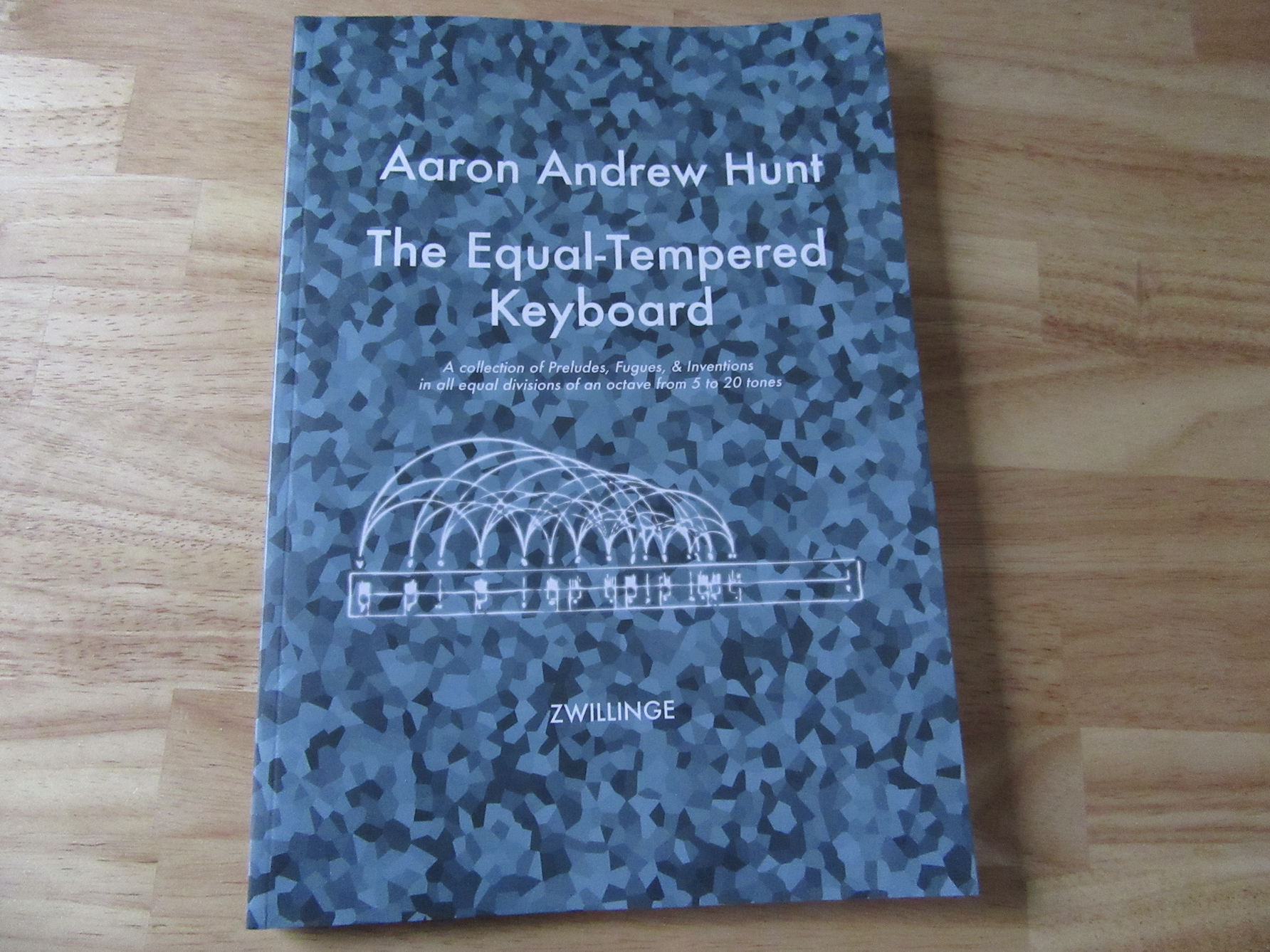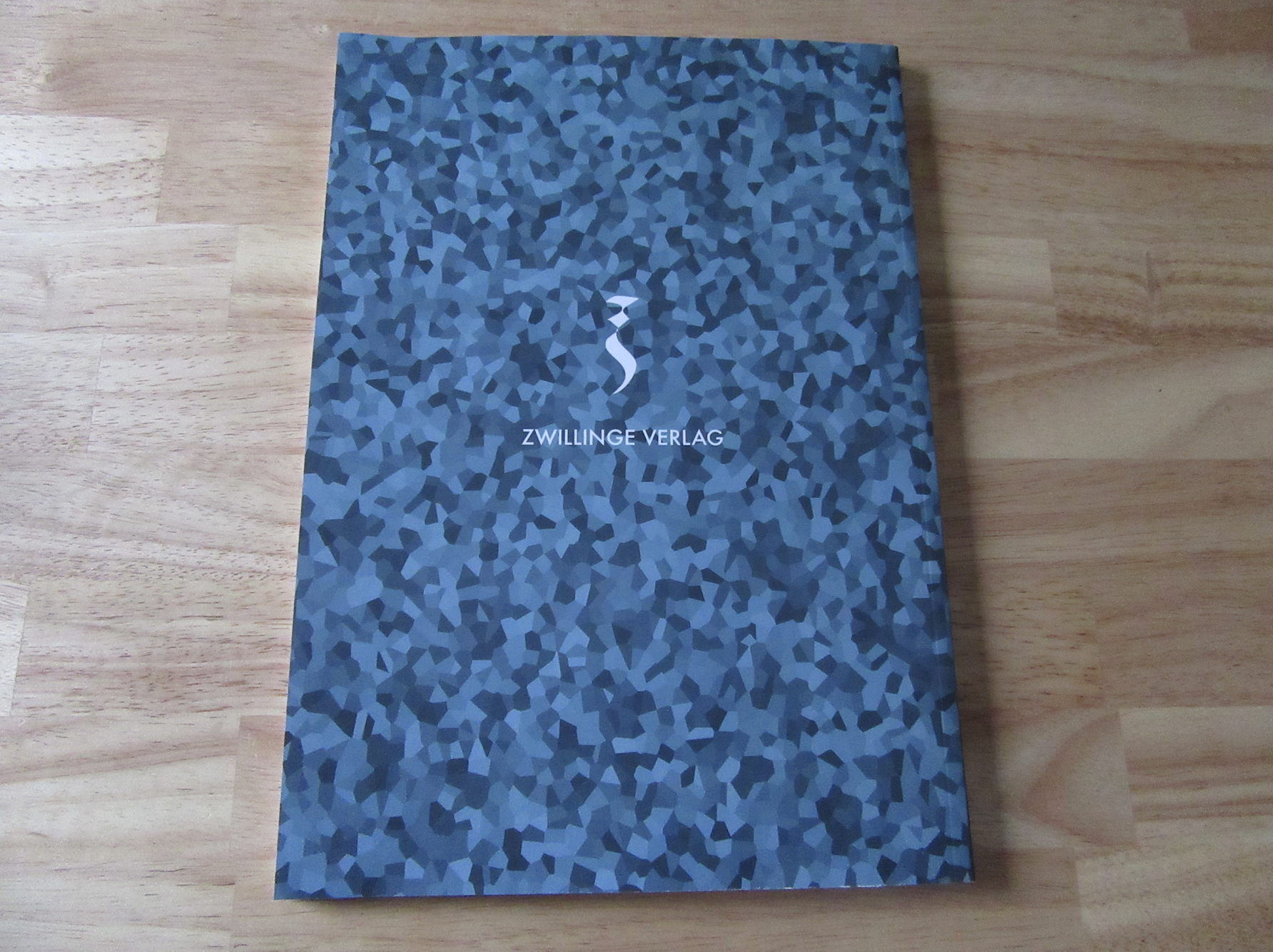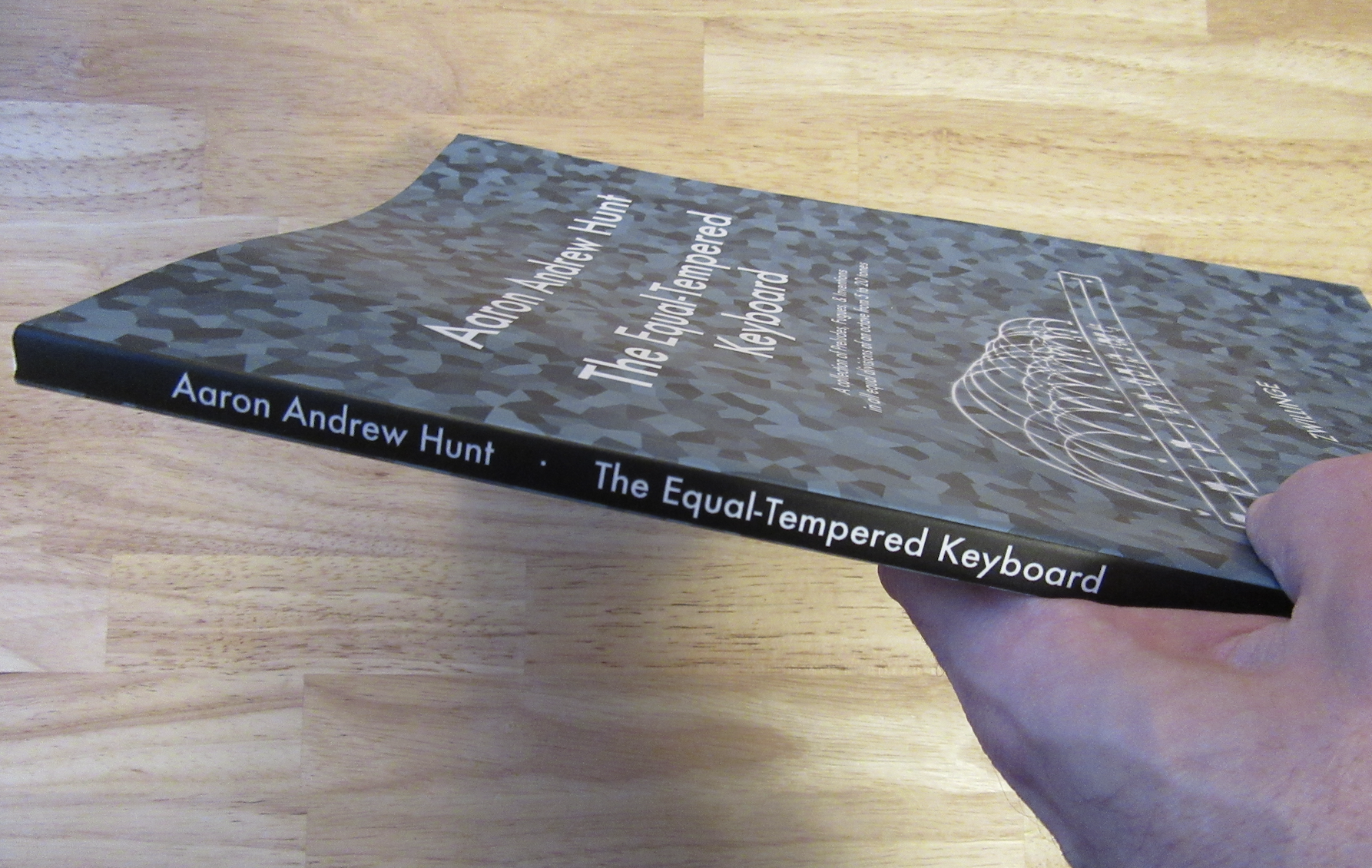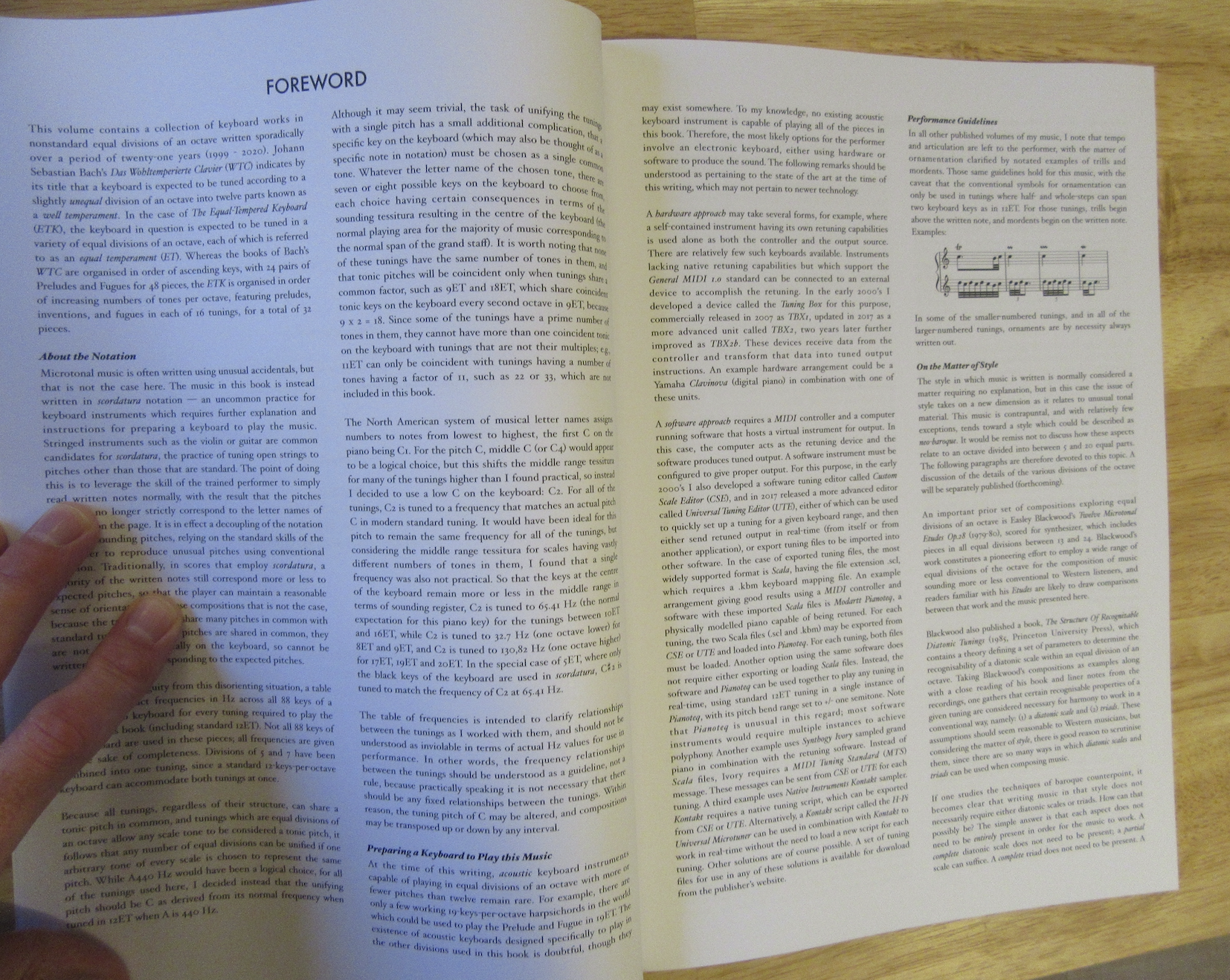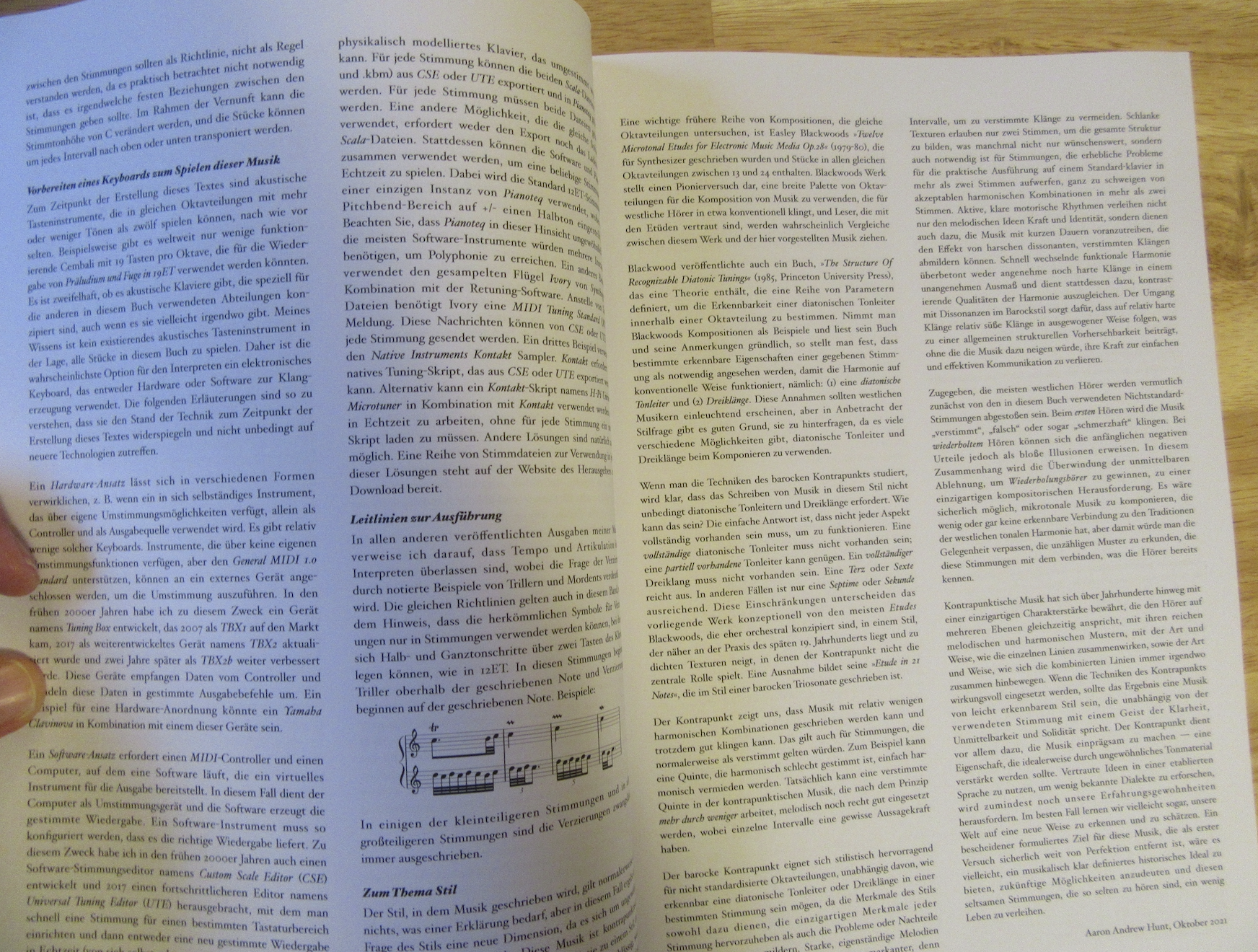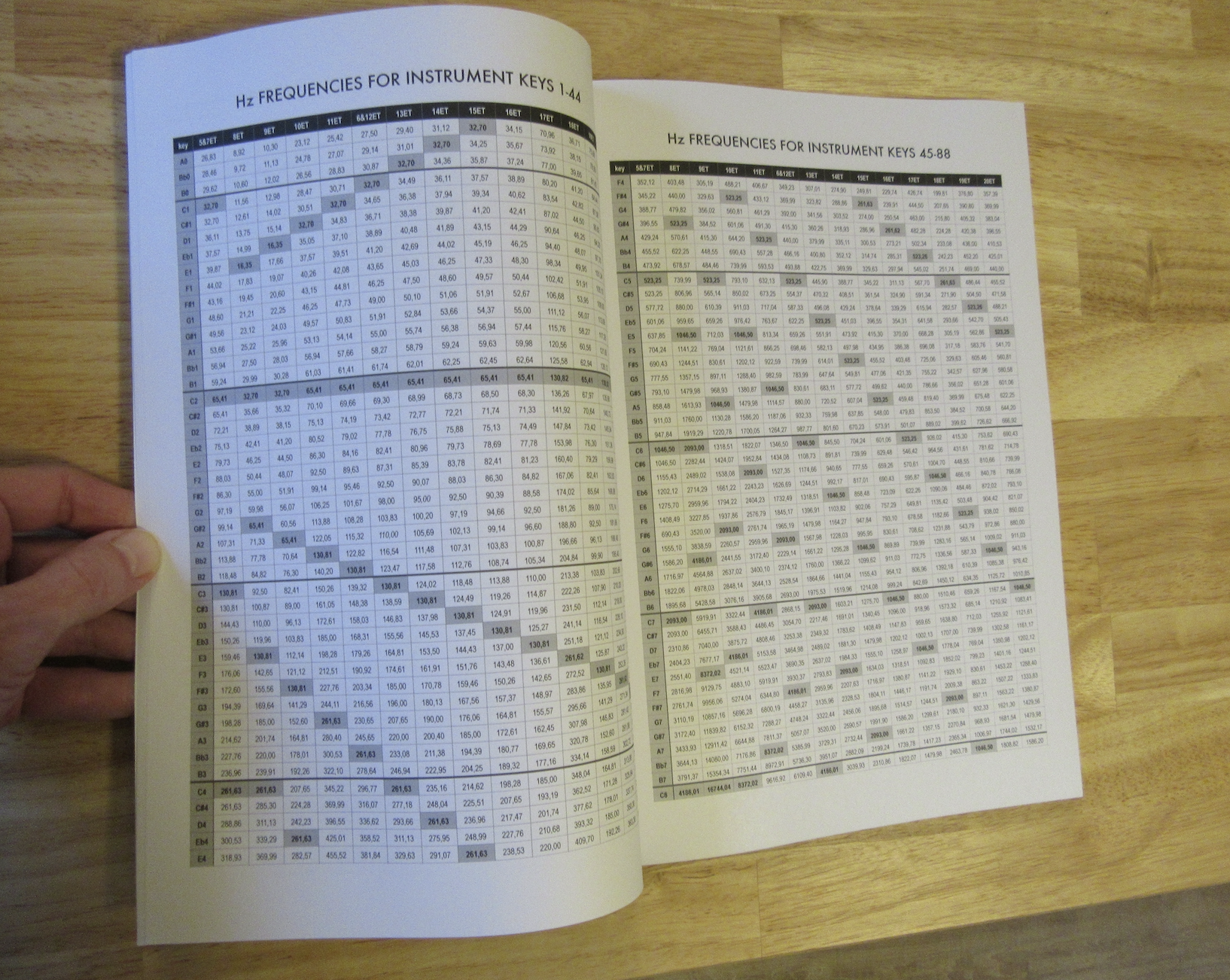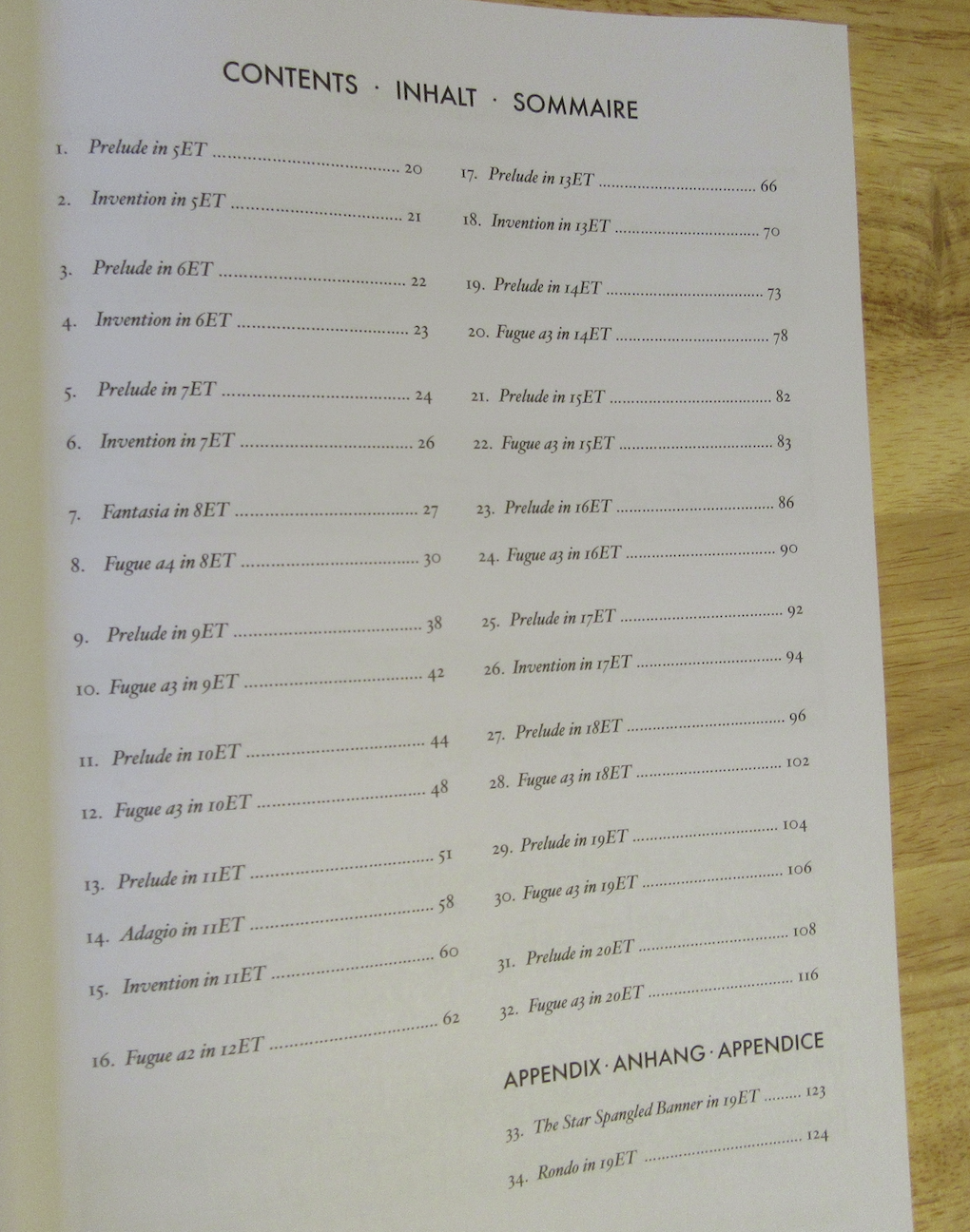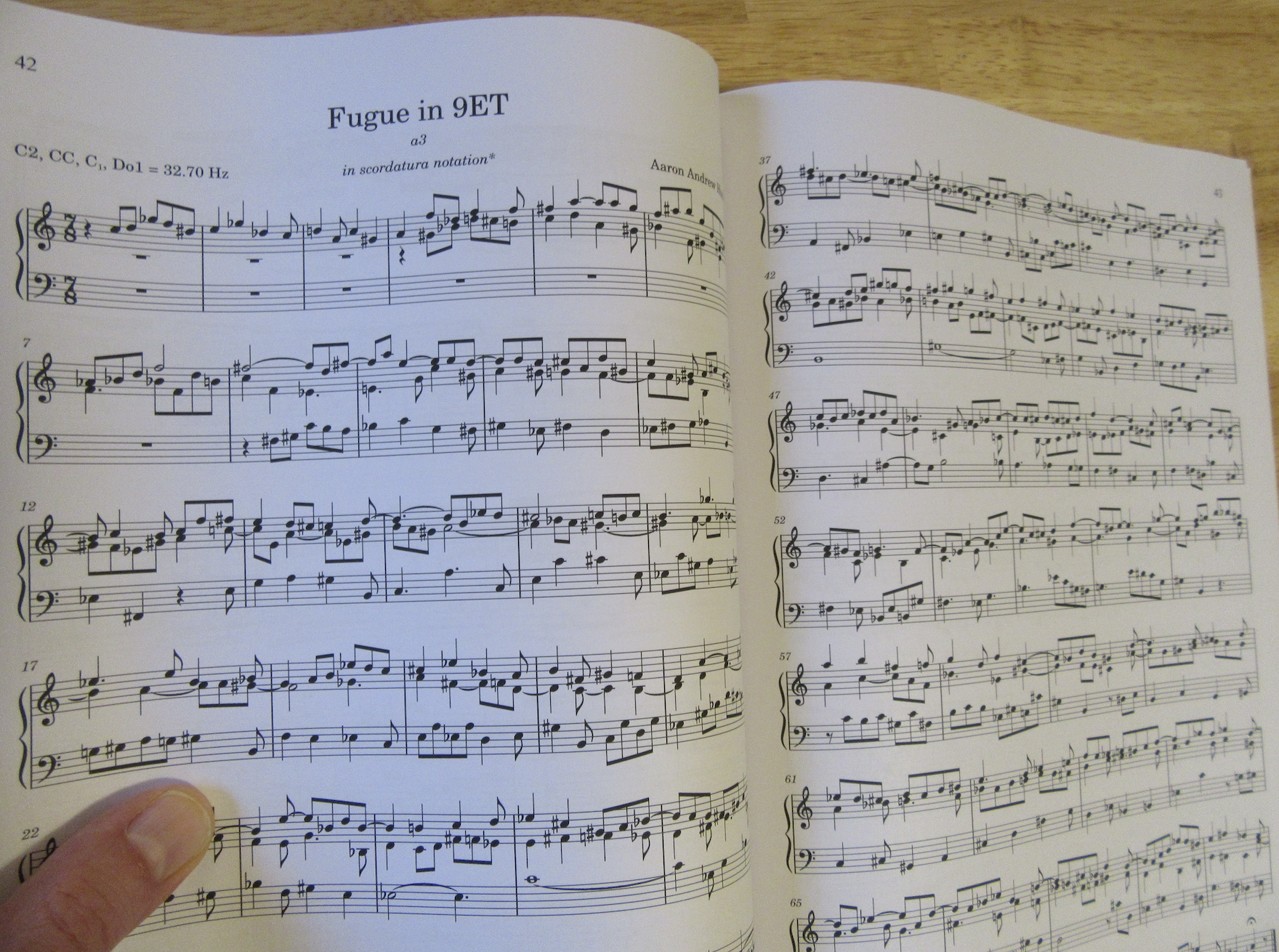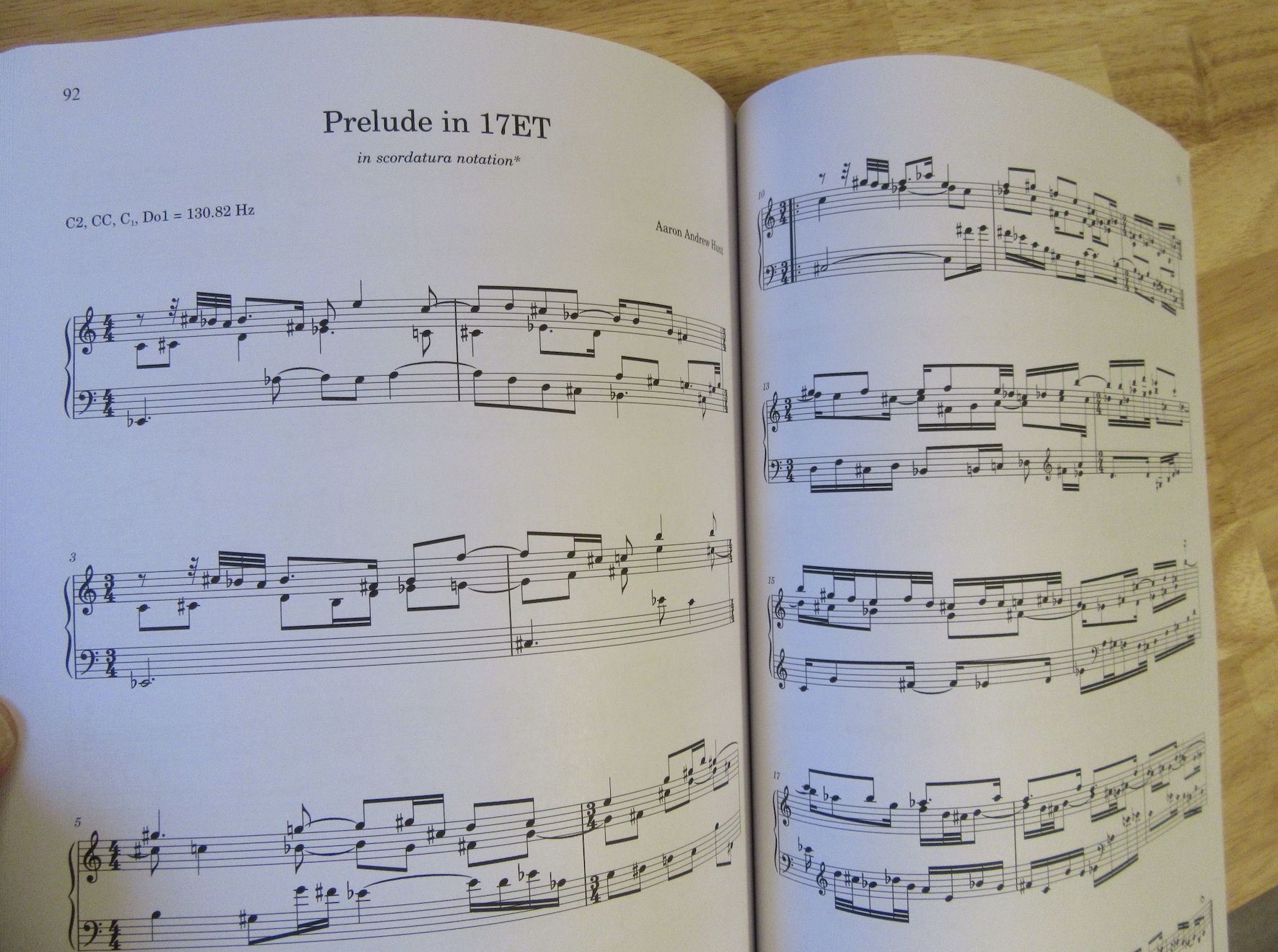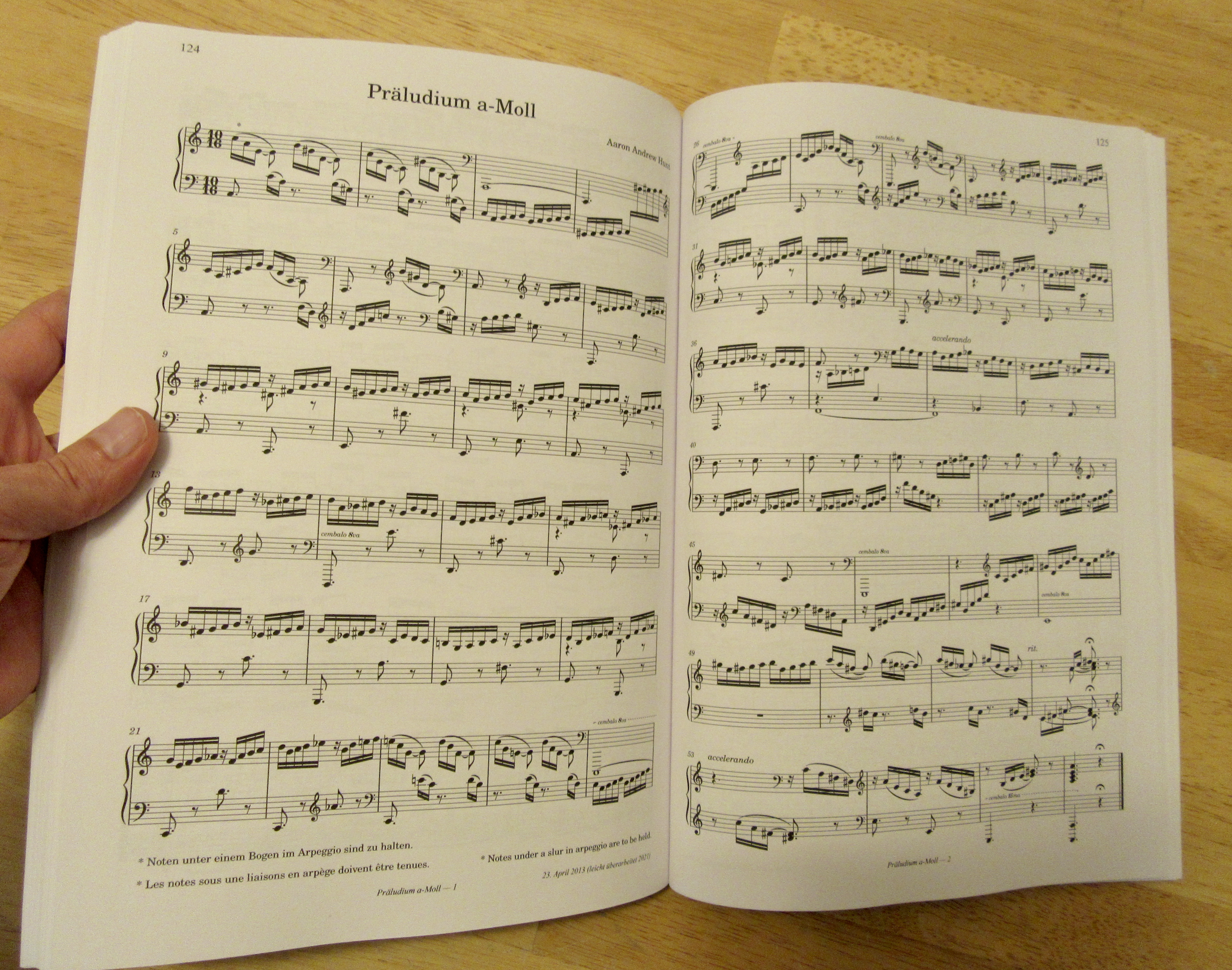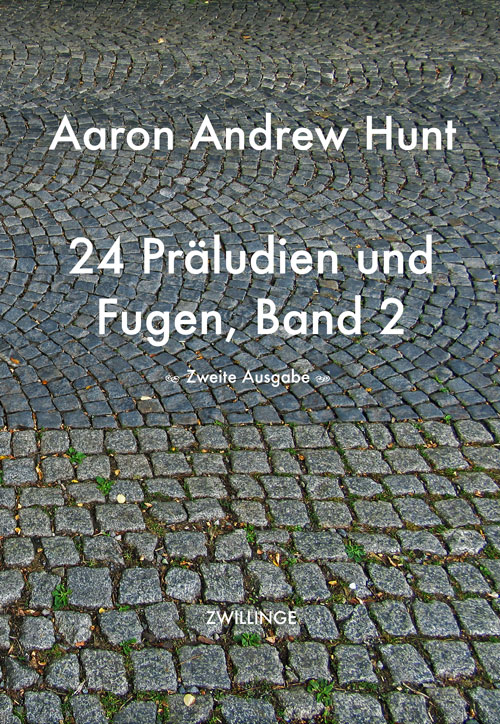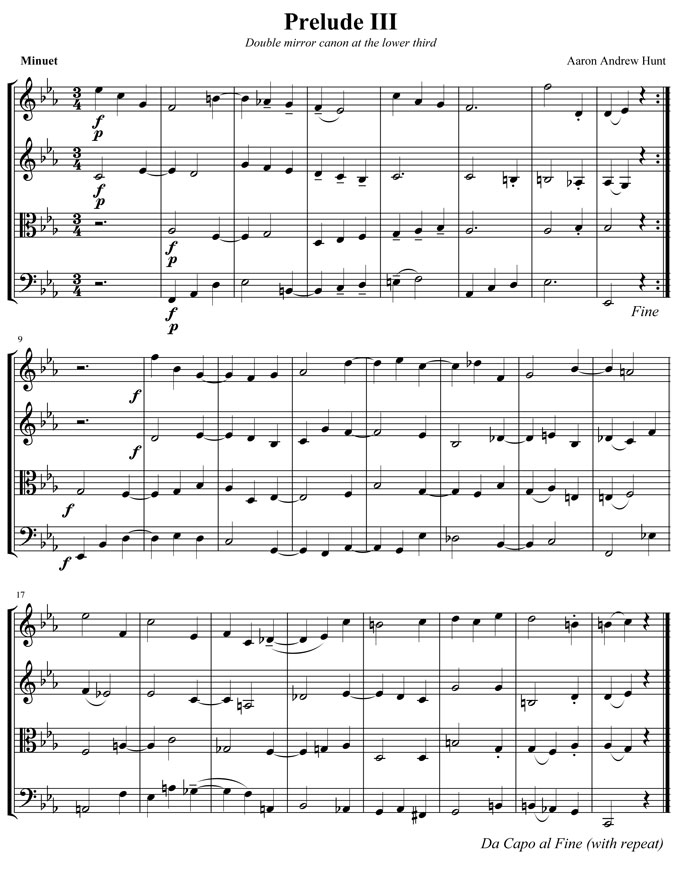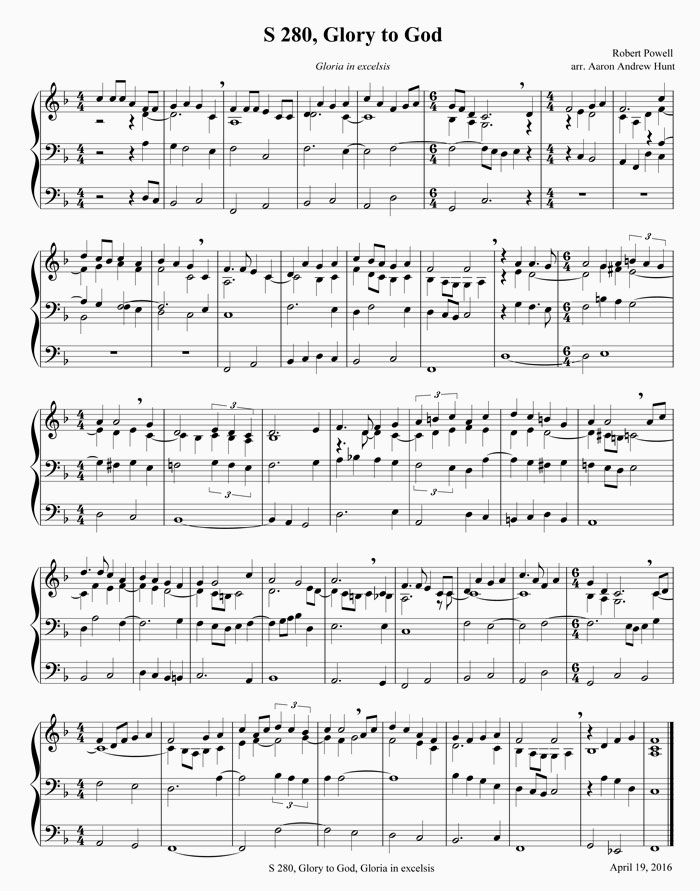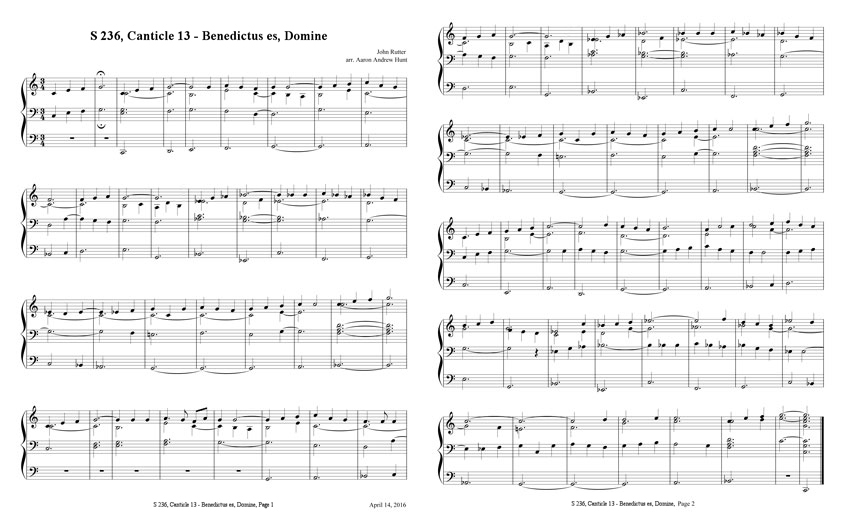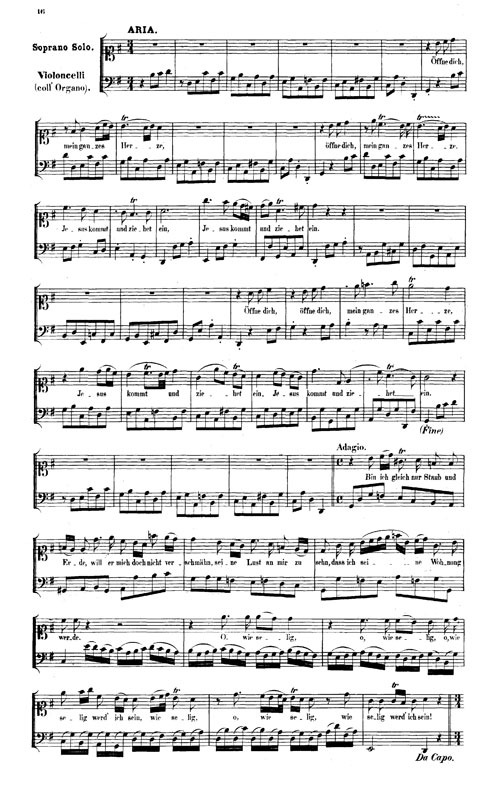

The Apprentice of Fugue, on piano
February 12, 2024
Some of you might already know that I released a new album on February 4, 2024 — a performance of The Apprentice of Fugue played on piano (a Steinway D concert grand). The music was written in 2022, and that year I had released a recording on organ under the original title of the work in German, Der Lehrling der Fuga.
To celebrate this release, my friend Stephen Malinowski made animation videos for Contrapunctus 11 and Contrapunctus 3. As many of you know, Stephen has an uncanny ability to match music to visual patterns. He also knows Bach's music very well, and has an excellent understanding of counterpoint and composition, so he had no trouble at all getting into the inner workings of these pieces. We corresponded over a period of several weeks, during which time Stephen tweaked the visuals again and again. I hope you'll take some time to appreciate the great attention to detail taken in these videos. In Contrapunctus 3, the chromatic lines are rendered with something that looks a bit like the eddies of a small fish swimming in clear water, which fits the feeling of the counterpoint perfectly.
In Contrapunctus 11, there are three subjects, which are the same three subjects used in (my) Contrapunctus 8, but inverted (turned upside-down). Whereas Contrapunctus 8 has three voices, Contrapunctus 11 has four; as in Bach's original, the fourth voice often verges on becoming a fourth subject – a stepwise line, usually chromatic. Bach used repeated notes in his third subject to give a feeling of insistence and urgency. One of my goals throughout this project was to avoid simply copying whatever Bach did. Rather, I wanted to to come up with my own way of doing something similar which might have a chance of being as successful (which I consider a healthy view of tonal composition in general). So I use the notes of his main theme, but (importantly!) I change the meter and rhythm. All other subjects (apart from the BACH subject in the closing fugue) must use different notes. For that reason, my third subject in Contrapunctus 11 doesn't use repeated notes — at least not directly. Instead, neighbour-tones are used. Stephen rendered this subject with spiralling thread-like patterns that fit the contour of the subject perfectly. Bach's second subject begins with a long note on the downbeat, and his third (repeated-note) subject begins with a weak-beat accented note that's often held over a barline (we can call this a "syncopation") — an exciting effect which produces expectation. I turned that around, using syncopation at the outset of my second subject, which allowed me to sometimes approach the third subject using syncopation, in such a way that the listener can't be sure which subject is going to follow that first note. That uncertainty lends an edge to the development. I discussed this with Stephen, and in the video you'll see that those syncopated notes are larger than the others, circled, and they rotate as a sort of "handoff" to what follows. It's these kinds of details that make these videos so much fun to watch!
If you like, you can also watch the corresponding "inversion" of the above triple-fugue in a video of Contrapunctus 8 Stephen made of the first recording of Der Lehrling der Fuga (played on organ, released in 2022).
Stephen also previously made a video of Contrapunctus 9 (which features double counterpoint at the 12th) …
… and Contrapunctus 1, which is among the least similar formally to any of Bach's original fugues, because (as you can read in the liner notes of the recording, or in the score) The Apprentice of Fugue also tells a story, which begins with PART 1 as follows:
"In order to make the masterpiece undoubtedly different, the apprentice looks for alternatives – including potentially clumsy combinations which the master had not used."
Needless to say, I would have never been able to write an Apprentice of Fugue were it not for Bach's Art of Fugue. Which touches on the reason I took on this project to begin with: to learn things I simply couldn't have otherwise learned. There's more to say about that, but I'll end here for now. In any case there will certainly be more episodes of Passages That Bother Me, so stay tuned!
Until then, I remain,
— AAH
Re: Passages that bother me BWV 552a (St. Anne, Prelude)
July 22, 2023
This is a short followup to our previous episode in the series "Passages that bother me", where I thoroughly scrutinised a questionable transition found in the great St. Anne Prelude which opens Bach's Clavierübung III, published 1739. We begin by citing the passage in question as Bach wrote it. The transition in question is between bars 175 and 176.

After publishing my investigations, which contained many possible approaches meant to possibly "improve" the above transition, I received a remarkable alternative which hadn't occurred to me, written by the esteemed composer Stéphane Delplace. A brief exchange of observations led to the following "final version".
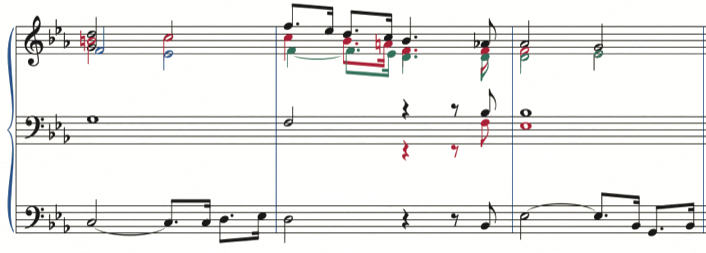
The core idea of this alternative is to replace the B-Flat triad in first inversion with a D minor triad in root position. It's difficult to convey just how much wisdom is contained within this surprisingly simple idea.
Recall that a B-flat triad is the most distant diatonic relation to be found in C-Minor, and this fact is in large part responsible for giving the transition an awkward effect. When we replace this harmony with D-minor 7th chord, the majority of the awkwardness is removed in one stroke, since a very distant harmonic relation is replaced with a very close one. When the fifth is present, the chord is an altered harmony in the key of C minor, since the 6th degree must be raised from A-flat to A, but Bach's voice-leading suggests that the fifth shouldn't immediately appear; rather, it should "sneak in" almost unnoticeably. This note, A, then acts as a leading tone to B-flat, so that the voice-leading is finally as smooth as it should be. Because the C is now held as a common tone, the similar motion is decreased just enough that it no longer draws any undue attention to itself.
As an added benefit, this sonority on D minor contains not only a 7th, but also a 9th, namely the small 9th E-flat above the root D. Here is where a deep knowledge of Bach's harmonic language helps to understand why using this specific chord as the solution might just qualify as a stroke of genius! Because this specific chord, a minor triad with a minor 7th and minor 9th, turns out to be one of the most important aspects of Bach's harmonic language. I almost want to say something like "the best kept secret" of his harmonic language, because it seems few people have taken notice of Bach's consistent use of this specific harmony throughout his work. Precisely this sonority occurs as a ninth chord in the major mode, on the third degree, iii9. In minor, it appears here as an altered ii9, where the perfect 5th in the chord is the raised 6th of the minor mode, which is exactly what we see here in the above solution.
In fact, Stéphane Delplace has written a treatise on this very subject, this sonority and the special role it plays in Bach's music, which may be one of the most important treatises on harmony in the modern age. To everyone who wants to understand Bach's harmony, please go now and read this treatise. It is available directly from Delplace's website both in the original French, and in an English translation (which I had the honour of helping with).
III V § I C A (MUSICA, a treatise on harmony by Stéphane Delplace)
As a final note, I also came up with my own version using this same approach, to address a few things about the above solution which still bothered me. First, I found that the B-flat appearing already on beat 2 in the alto was too early, and the arrival should instead be saved for the descent of the soprano. Second, the full triad in three sustained parts on beat 3 seemed to stray unnecessarily from the original which sounds only the single note B-flat at that point. Lastly, the chords in the right hand require an awkward "hopping" motion if they are to be played by one hand, which I found counter to Bach's normal fluid style (although it is easy enough to play the passage by taking the second alto with the left hand, which is how I played it for the above recording). My version resolves these issues by introducing the fifth (A) as a quarter note on the second beat and resolving it on beat 3, resolving the second soprano to a unison with the first soprano, and dropping out the alto on beat four. The result is as follows.
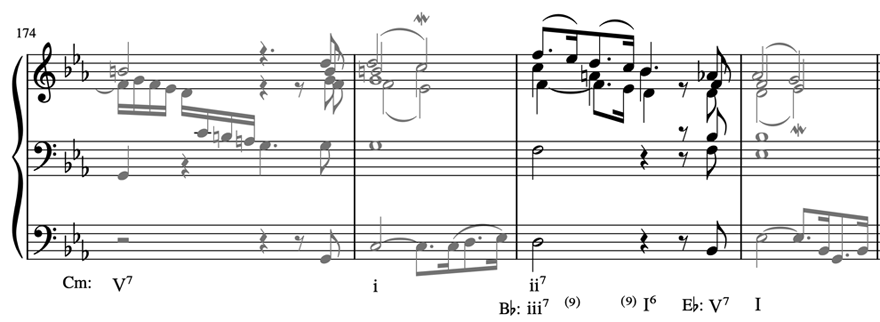
Upon comparing these, I have to admit that, despite my objections, Delplace's version sounds smoother. The reason is that it contains no distracting elements, whereas the accented A in my version makes the ii9 stand out. Therefore I consider Delplace's version to be better. Which do you prefer? As always, I'm curious to hear what you think. Whatever you do, be sure to get the treatise! It has the potential to help you appreciate Bach's music on a new level, and radically change the way you think about harmony in your own work.
Peace,
Aaron
Passages that bother me: BWV 552a (St. Anne, Prelude)
May 15, 2023
Today I welcome you to another episode in the series "Passages that bother me". It's very rare that I have the feeling that anything should be changed in a piece by Bach, but loyal readers of this blog will know that I've written about an example or two in the past. This time it's the Präludium pro Organo pleno, from BWV 552, the great St. Anne Prelude and Fugue which is found at the opening of Bach's Clavierübung III, published 1739, which contains a passage that bothers me.
The Structure of the Prelude
In some ways the form of the prelude resembles the scheme of a French Overture — a ternary form (we'll call it ABA) in which the opening and closing material (the "A" material) is slow and stately, with dotted rhythms and scale runs, and the middle section (the "B" material) features fugal imitation. In this case, instead of ABA, we have a five-part structure ABABA. This 5-part concept is a gross oversimplification of the form (completely ignoring secondary thematic material), but it serves the purpose at hand.
The piece opens with a clear question / answer phrase structure, using a descending scale motive embedded within chords in half notes which cadence on suspended harmonies. [N.B. The embedded audio clips in this blog post are live recordings of me playing the St. Bavokerk Müller organ sample set (Voxus) using Hauptwerk.]

We'll call this the "A" material. After some sequencing, a similar phrase structure takes place in bar 17, beginning on the dominant (B-Flat), this time moving to the relative minor (C-Minor), also with suspended harmonies.
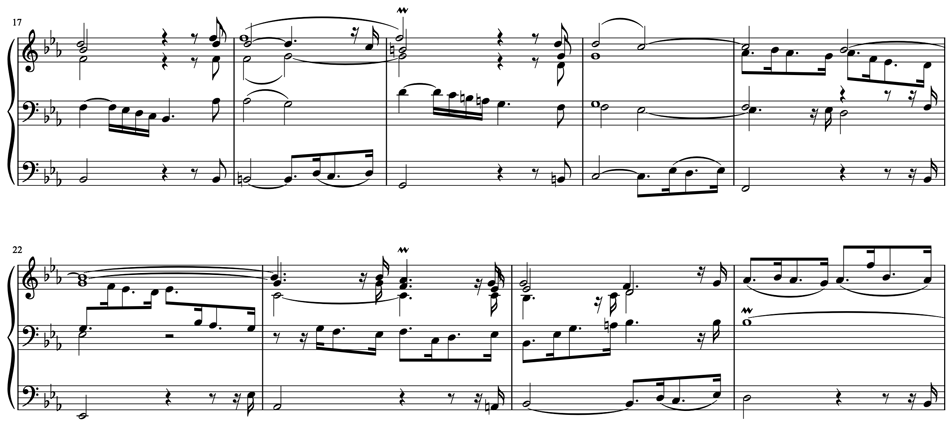
NOTE: The passage above becomes important for understanding how Bach transitions from the "B" material back into "A".
There is also a subsequent varied statement of this question / answer harmonic pair developed using more active scale runs, helping to warm us up for the B material, which is more active, consisting of shorter note values (16ths) accompanied mostly in quarter notes. The B material is developed in such a way that we become "swept away" as it were, so that we might even almost forget where we came from, and the return of the opening material becomes all the more pleasant.
The Art of the Transition
Anyone who attempts to compose a piece of music in which multiple themes are supposed to appear will find out how challenging it can be to transition from one theme to another. In such a piece, assuming the material is solid, the trickiest parts to write are likely to be the transitions. In the baroque style, transitions are usually done using cadences. In this prelude, there are four significant transitions which take place between the A and B material. The first, moving from A to B, is found at bar 71, a cadence in C-Minor.

The subsequent transition back into the A material is made to sound natural by immediately engaging in a sequence after a suspended harmony on F-Minor in bar 99. Recalling our note above, you may notice that this A material is a transposition of the sequence which started in bar 20.

So this turns out to be a transposition of the opening material in the subdominant, where the transition enters at the equivalent of the relative minor suspended harmony we saw in bar 20 (before: C-Minor in the key of E-Flat, here: F-Minor in the key of A-Flat).
Later, another transition into an extended treatment of B appears with a V I in E-flat (the home key) in bars 129-130.

The B material is then developed over a span of 103 measures without return to the A material, until bar 175, where the half notes reappear, not in E-Flat major, but in C-Minor (the relative minor), followed by a complete restatement of the opening (around 30 measures).

Measures 175-176
And here we have arrived at the passage that bothers me, which has in fact bothered me for as long as I can remember. Every time I hear this piece or play it myself, the shift from bar 175 to bar 176 sounds too abrupt — almost like a "cut and paste". It seems like the A material was simply put there without enough care being taken for the transition. Every time I experience this piece (and I keep hoping the feeling will go away, but it never does), I feel like something has gone a bit wrong and something is missing at this moment. Why? Is this just some personal quirk of mine? I don't think so, because there are logical reasons why it sounds not quite right. I will even go out on a limb here and wager that in the 300 years since it's publication, at least one other person has been bothered by this transition.
If we compare this passage from bar 174 to the end of the piece with the previous transition from B to A in bar 99 and following, we notice that this second transition would be symmetrical with the first if Bach made the "splice" from bar 174 to bar 193 instead of bar 175, because in both bars (175 and 193) we have essentially the same suspended C-Minor cadence half notes. Did you ever notice that before?
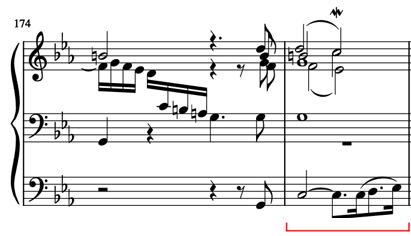
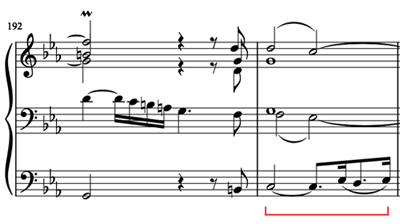
If this transition were to move from bar 174 to bar 193, the closing A section would be exactly symmetrical with the transition in bars 99 and following, and the final section would be 18 bars shorter.

Could this shorter recapitulation have been what Bach started with, and then he decided it was better to restate the whole opening? Not likely. A lesser composer might have done that, but not Bach. Bach knew that the transition would have been much more natural if it had moved from 174 to 193, because that's what he did at bar 99, but if he did that again here, the formal balance wouldn't be right. By including 18 additional bars from the opening, the form is correctly balanced, but the transition is slightly awkward. Bach knew that front-to-back formal symmetry was more important than the transition. In fact, the "surprising" aspect of the transition could in this light be viewed as a deliberate signal to make the formal return of the opening material all the more clear.
While that sounds reasonable enough, the transition still bothers me. Here's why. Before the return of the A material in bar 175, C-Minor has already been established 6 measures earlier (with the B material), so the note B-natural as the leading tone has already been in clear force prior to the transition.
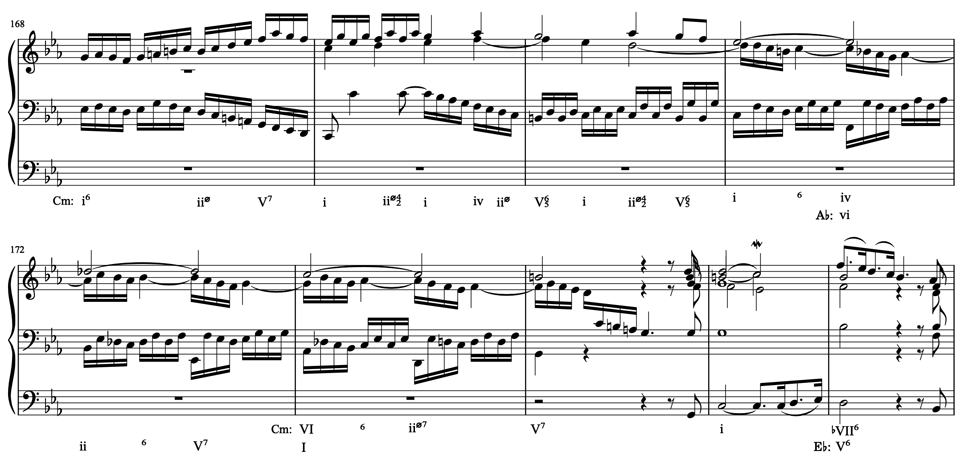
When we reach bar 175, we get a very strong suspended harmony, V over i resolving to i in C-Minor, and the crucial note B-natural sounds in the V resolving to C. In the following measure, the harmony shifts to B-flat Major in first inversion, with almost all voices moving in similar motion. If those two facts seem like clues that something is less than ideal here, you're starting to see why this bothers me.
A Questionable Harmonic Shift
B-Flat Major is in fact a functional diatonic harmony in C-Minor, but it's also the most distant relation, the flat VII. B-Flat Major sounding after a very clear C-Minor in which half of the bar has sounded the leading tone B-natural in the dominant V and resolved it, simply isn't going be the most natural-sounding transition (even when the preceding referenced the key of A-Flat, with the note B-Flat appearing in bars 171-173). The harmonic shift from C-Minor to B-Flat is by nature going to sound a little less than natural, if not slightly awkward, because of the chromatic shift from B-Natural to B-Flat.
Questionable Voice-leading
Too much similar motion is not good for counterpoint, and exactly that weakens this crucial moment. The D in the bass is supposed to be a leading tone in E-flat Major, but that isn't what it sounds like when it arrives. Instead, we are distracted by the chromatic shift from B-natural to B-flat (downward!) which works against the D sounding like a leading tone needing to resolve up by step. The soprano, alto, and tenor all move up. The bass technically steps down, but its line in bar 175 is a neighbour group around D, so the impression is still vaguely of stepping up from the downbeats of these two measures: C to D.
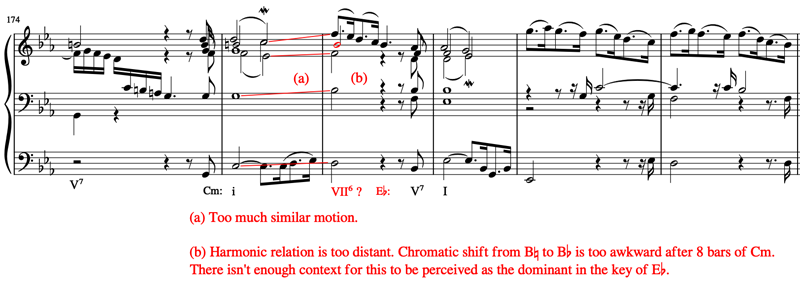
Alternative 1: A First Attempt
Could this transition be improved? Is there something "missing" here? To try to answer these questions, I wrote some alternative transitions. The first attempt was simple, using the advice "don't worry about anything, just follow your ear" (which is good for getting a quick result — not necessarily the best result, but a quick one). So I began with the piece up to bar 175 as written, and imagined that the score broke off there, with some music missing, then picked up again in bar 176. What might be missing? Again, the goal of this first attempt was not to write the greatest not-actually-missing bars in history. It was to have something that did the job, which could then help give clues about how to perhaps do it better. Following my ear wherever it led, I ended up with the following five measures:

I understand that at this point you might feel like telling me how awful this is, but let's look at what happens here objectively if we can, and see how it relates to the original. Instead of directly cancelling the B-natural leading tone with a B-Flat, A-Flat gets raised to A-natural so that the B-Flat sounds more natural along with a raised F-Sharp, to lead to G-Minor. This bass line is reasonable voice-leading, since it is in contrary motion with the soprano (and is the same bass pattern Bach used at the opening of the work — a downward tritone). The same harmonic progression then happens in D-Minor (a sequence), but with a thinner texture and a deceptive resolution of the dominant. Then comes a quick step backward on the circle of fifths, and a statement of the B theme appears in B-Flat (with a "hand-off" between the soprano and tenor), with another unexpected backward fifth modulation so that B-Flat clearly becomes the dominant of E-Flat.
This works, but feels a bit long, and has a harmonic direction that may not be entirely convincing. The cadence in G-Minor seems suspect. The problem is that that the symmetry of two suspended half-note harmonies of the opening theme is broken, since we now we have three such suspended harmonies (C-Minor, G-Minor, E-Flat). This raises a point in favour of Bach's version: simple symmetry. There are other issues within these five bars. Below, I've marked my score as if I were one of my students.

If anyone out there is concerned about the implied parallel 5ths between the tenor and bass in bar 180 above, take a look at my previous blog post which shows how Bach wrote implied parallel 5ths and implied parallel octaves, as well as one actual parallel octave / unison in this piece.
Alternative 2: A Second Attempt
Considering all of the issues in my first try, I made a plan for a second attempt, aiming for something as short as possible, trying to keep whatever might have been good in the first attempt. The result was the following two measures.
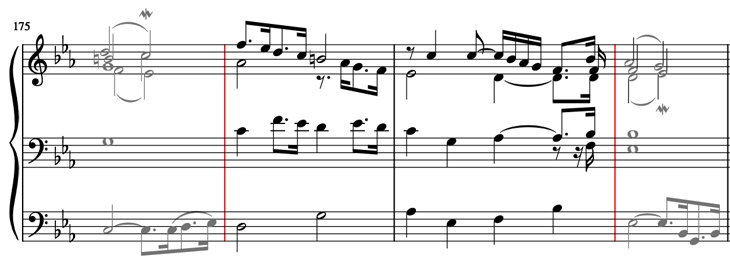
Here, the bass line from bar 175 to 176 remains as Bach wrote it, and the soprano line in bar 176 is almost the same except that what was a B-Flat is here a B-natural, and the harmony is D-Half-Diminished, so we stay in C-Minor. A deceptive resolution of V then moves to A-Flat, followed by a ii V I in E-Flat. Harmonically, this is more logical than the first attempt, and it seems to do the job without raising any obvious red flags. The symmetry of the original is still sort-of there, delayed by one measure.
This version sounds less invasive than my first attempt, but the fifths by contrary motion in outer parts bothers my ear, and I'm also left with the feeling that there isn't enough space, because we plow through with all parts sounding instead of dropping out voices as in the original. So another important aspect of the original becomes clear: space!
Another apparent weakness of this version is that we've just cadenced with a 2-5-1 in C-Minor, so the 2-5 (D-Half-Diminished to G) in the new bar 176 ends up sounding slightly repetitive.
Alternative 3: A Revised First Attempt
Returning to the first attempt to try to improve it, I noticed that the cadence in G-Minor could be removed, the deceptive cadence could be sequenced instead, and the soprano line transitioning into the suspended harmony in E-Flat could be altered in a way that would both make the melodic direction of the phrase more logical, and also produce a broader symmetry within the composition, so I made those revisions, as shown below.

With the cadence in G-Minor removed, the harmonic rhythm is certainly more consistent. The transitioning soprano line in the last bar now begins on A-Flat, higher than its previous entrance, and is now modelled after the alto in bar 174, creating a new symmetry. On the whole this should give a more natural and convincing impression, but it remains quite far away from the original.
At this point another important aspect of the original became clear to me, namely that the entrance of the pedal (which has been absent for about 15 measures prior to bar 174) is associated with the return to the A material. Here we don't get that same signal. Foiled again?
Alternative 4: A Revised Third Attempt
Since I saw that none of my alternative ideas matched the straightforward simplicity of the original, I changed my focus to the four measures 174-177 which serve as an analog to the opening four bars of the work. Those opening four bars are shown below, followed by bars 174-177.

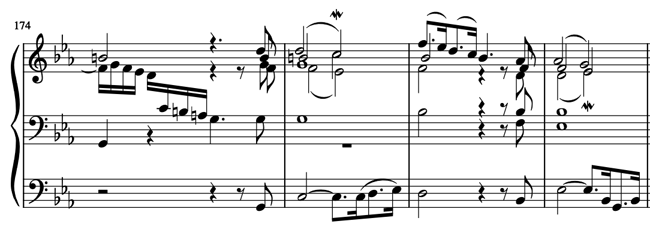
It occurred to me that without adding any new measures, a simple change in harmony could bridge the keys of C-Minor and E-Flat Major in a more functional way, while also improving the voice-leading. The trick would be, instead of moving directly to B-Flat, the bass would move to A as the 3rd of F Major, which would then move to B-Flat in first inversion on beat 3. By holding only the B-Flat in the soprano as a dotted quarter and making all the other parts on beat 3 quarter notes followed by eighth rests on beat 4, the feeling of rest before the suspended harmony on E-Flat could still remain half-preserved. Here is the result of this thinking:
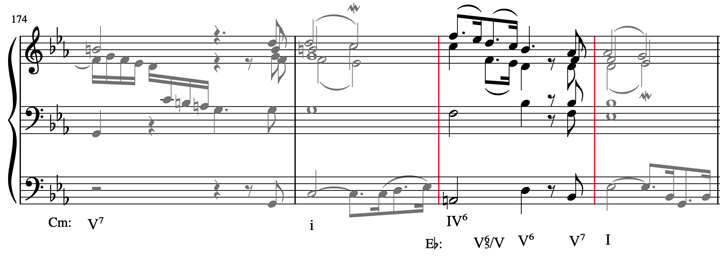
F Major is functional in both keys, serving as a more reasonable pivot than B-Flat. This option somehow manages to sound less convincing than the other attempts. One reason for this may be that Bach tended not to write two first-inversion 5th-related triads in a row where the bass sounds like it should be in root position but it isn't. Another reason mentioned earlier would be the fact that all voices remain present. It also contains implied octaves by contrary motion. Otherwise it's possible that the this version may be too similar to the original (which for those of us who know this piece is burned into our brains), so that cognitive dissonance is too strong, and it just "sounds wrong". Which begs the question, for someone who didn't know this piece to begin with, how would this version fair against the original?
Alternative 5: A Completely Different Approach
After all this bother over measures 175-176, where C-Minor is the given which causes so much trouble moving to B-Flat, it dawned on me that the sequence prior to these measures could simply be redirected so that we don't move to C-Minor in the first place. Instead, the sequence can move to B-Flat Minor, using a Phrygian half cadence. The trick is to use D-Flat, G-Flat and B-Flat instead D, G and B, since the sequence itself can naturally move in either direction. Once we have an implied F dominant instead of a G dominant, we can cadence in B-Flat Minor instead of C-Minor. Then the B-Flat dominant chord functions more strongly in both keys, as an altered tonic (secondary V7 of iv) in B-Flat Minor, and as V7 in E-Flat. An added 7th in the tenor on the dominant strengthens the shared harmonic function. Spoiler alert: this is going to sound a bit clumsy!

The clumsiness comes from two things: first and foremost, the single voice trailing off (as the original does) doesn't have quite enough context to state a totally convincing Phrygian half cadence. Secondly, the soprano stepping down from C to B-Flat instead of B is slightly conspicuous. The good news is that these things can be improved. Adjusting things slightly to move to B-Flat sooner, leaving in the other parts at the cadence, gives a better result. There would be any number of ways to work out the voice-leading for this; below is one possibility.
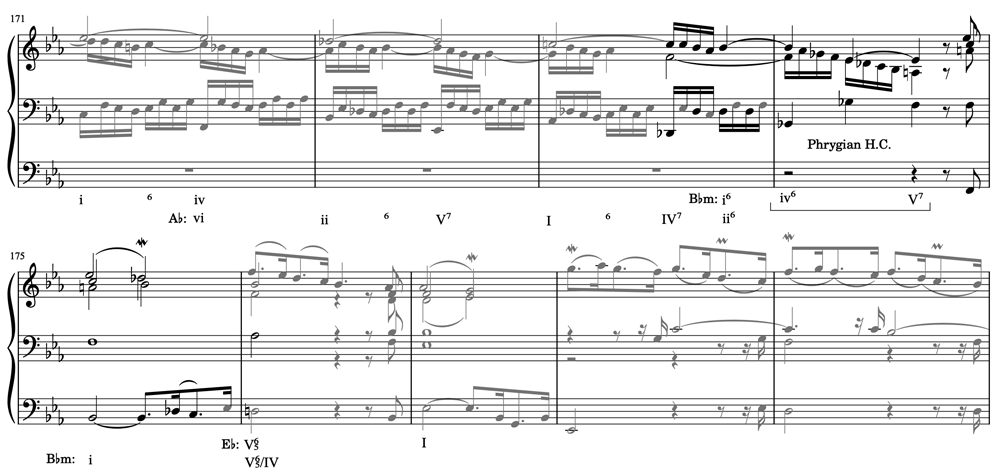
Although the harmony is clear and functional, the feeling I get from this version is a bit painful. B-Flat Minor is a lovely but rather torturous key in relation to E-Flat Major, the resolution on the high D-Flat sounds slightly too strident, and the chromatic shift to B-Flat dominant with the 7th in the tenor is too distressful at this moment.
So another trait of the original appears to be superior in comparison. Above, the soprano line steps down from E-Flat to G, but has to do an intervening chromatic shift from D-Flat up to D. Bach's version simply steps down diatonically from C to G — much simpler.

It would be possible to resolve the suspended harmony to B-Flat Major instead of B-Flat Minor to avoid the upward chromatic shift during the descent, but where do we stop? At this point, I think the lessons have been learned.
Conclusion
Are any of these alternatives an "improvement" on the original? No, I wouldn't go that far, although when I play the prelude using any of the more successful attempts, the awkwardness of the original harmonic motion and voice-leading is gone, and for me, that's a better feeling than I get from the original. That might not be the case for you, or for anyone else on the planet, but that isn't the point of the exercise. I've learned quite a few things about why the original is the way that it is, by figuring out some of the things that make it good in comparison to possible alternatives. Obviously, if I hadn't made the effort, I wouldn't have learned these things. That's justification enough for allowing myself to "rewrite" the music of the master. There are those who will protest, claiming that what I've done here is disrespectful. I've received these kinds of comments on social media many times before: "Who are you to ruin this music?!", "Disgraceful!", etc. Let's please not be so uptight. Rewriting Bach's music is a very good way to learn.
Was everything I learned from this exercise already obvious to you? If so, then congratulations for being a few steps ahead of me! If on the other hand you learned something from what I've done here, I'd be glad to hear that. Especially if my experiments inspire you to come up with your own alternative versions of passages that bother you, I hope you'll share those. And lastly, by the way, if you can't think of any passages that bother you, you may not be listening closely enough …
Peace,
Aaron
Parallel octaves and 5ths in BWV 552a (St. Anne, Prelude)
May 09, 2023
BWV 552 is the great St. Anne Prelude and Fugue found at the opening and closing of Bach's Clavierübung III, published 1739.
In case you don't already know, the nickname St. Anne wasn't used by Bach. It comes from the similarity of the fugue subject with the tune known in the English-speaking world as St. Anne, written by William Croft (1678-1727), to the text O God, Our Help in Ages Past, by Isaac Watts (1674-1748). Researchers believe it's unlikely Bach knew of the tune. The fugue subject is also related to one Bach had used earlier in his career, in the Prelude in E-Flat Major (same key) in the WTC, Book 1. Today we're looking at the prelude, which Bach marks Präludium pro Organo pleno, a large work — in fact the longest prelude for organ that Bach ever wrote — which has multiple themes.
There are some voice-leading anomalies in this piece. The most striking of these is found in bar 67, where Bach writes a real parallel unison (and / or octave, depending on how you want to interpret the pedal part).
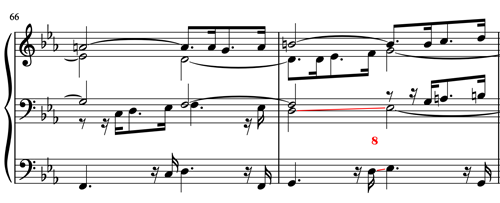
The thing about this is, nobody listening is ever going to hear a parallel octave or unison there. Organ registration is in fact based on adding parallel octaves and 5ths. The indication organo pleno means that many octave doublings and mixtures (which include 5ths) are expected to be used in the organ registration. When the pedal part moves here in a parallel unison with the tenor, the relationship between the voices simply can't be heard as such. It's even likely that the pedal will be sounding (in part) exactly the same pipes as the tenor, since the pedal is often coupled to the manual in organo pleno which again has been deliberately specified in the title of the work.
But it doesn't stop there. Bach also wrote implied parallel octaves in this piece, in measures 137, 146, and 150.

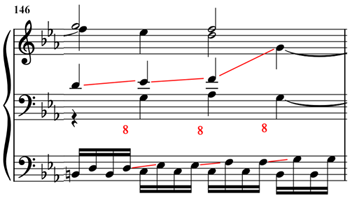

And if that's not enough rule-bending for you, in bars 133, 142 and 158, Bach also writes implied parallel 5ths with this same material.

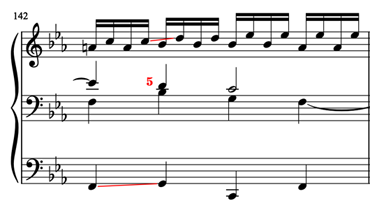

So students take note: Bach gets away with writing real parallel octaves / unisons when it's something nobody will ever hear, and he shows how these kinds of implied parallels can in fact be used, and will not sound wrong. But keep in mind that it takes a master to work magic like this. Chances are we're not quite on the same level as Bach. Like so many other things in this art, there are a great many more ways to do it wrong than there are to do it right. That's why students are simply told: "don't do it".
Next time we'll continue looking at this monumental work, taking a very close look at one particular passage — in fact it will be another episode of "Passages that bother me".
Until then,
AAH
Good-sounding parallel 5ths
April 16, 2023
There are cases where parallel fifths sound good. Sometimes even very good. Are these good-sounding cases still "wrong"? An interesting question!
Today I was practising at the organ, playing through the Prelude and Fugue in G Minor, BWV 535, in which Bach wrote one of these good-sounding parallel 5ths.
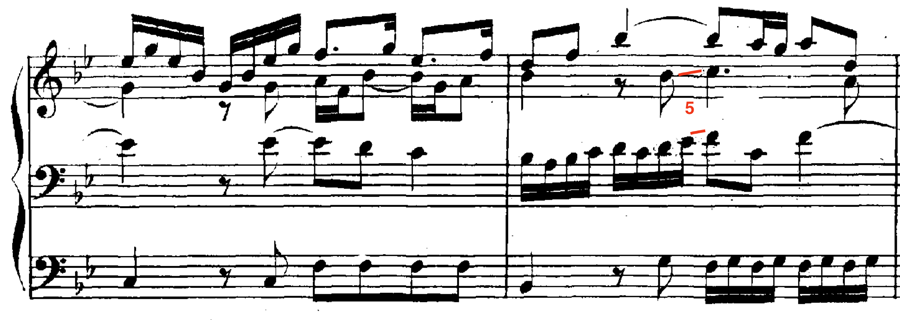
What makes this particular case sound so good is the suspended fourth in the soprano. Bach made sure to move the bass in contrary motion with the inner parts. It should also be mentioned that he could have easily "corrected" the passage by raising the E, so that the fifths would be unequal. But he didn't do that, we would have to assume intentionally, because the sound would not be the same.
There are times when I've found parallel fifths in my own music, sometimes already published, and have "corrected" them in a second edition. My opinion on this has changed over time. I think this example shows that parallel fifths are not always "wrong".
Of course, it's my job to point out parallel 5ths to students, regardless of the exceptions. But, it's also part of my job to explain the exceptions. Once a student has advanced beyond making simple mistakes, whether something like this is "wrong" starts to become a more personal matter.
Ultimately, composers have to decide these things for themselves. Count Basie's "If it sounds good, it is good!" comes to mind, which I like, but which also needs a qualifier, because it's only relevant for those who can truly hear and understand everything that's going on. Only then does it become a matter of taste.
Peace,
Aaron
Is this bad invertible counterpoint? (BWV851)
January 19, 2023
One of my students recently asked an interesting question about invertible counterpoint. He pointed out a passage in Bach's fugue in D Minor from the Well Tempered Clavier, book 1 (BWV851). In measure 3, there are 4ths between the soprano and alto (the only two sounding voices) on beat 4 and the 'and' of beat 4 (the 4ths are marked in red).

The same configuration happens again in bar 6 between the soprano and bass, but it's not necessary to show that, since this configuration was not cause for the question. The question comes from the observation that Bach uses these same patterns in inverted positions in bar 13. In other words, this is an instance of typical double counterpoint at the octave. Do you notice that things look a little suspect here?

Here in bar 13, we see what looks like implied parallel 5ths between the soprano and bass! What's going on? Isn't this bad invertible counterpoint? How did Bach get away with this?
If we take a closer look at bar 3, we notice that both of the 4ths are accented dissonances. The harmonic context makes this clear. The F and the D, both consonant 3rds, are the tones which determine the harmony, not the G and the E (the dissonant 4ths). Here the red notes are showing consonances and the dissonant notes / intervals are marked in grey.
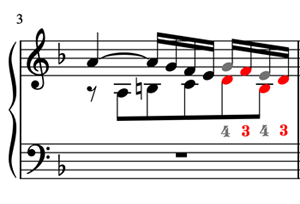
To stress this point, we can imagine an opening where in bar 3 the accented dissonances have simply been removed.

Of course, Bach didn't write that. But that is what's underneath what Bach wrote. When Bach inverted the parts as written in bar 13, it's a similar situation. The offbeat 6ths determine the harmony, not the 5ths.
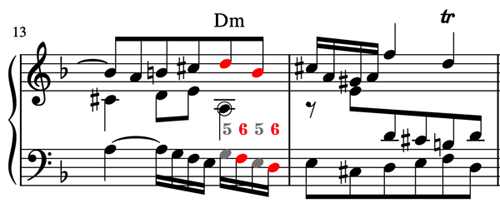
This is, we must admit, an extremely precarious thing to have done! The middle voice A has been circled, because without that note, the whole structure falls apart! In two parts, this inverted form would simply not fly.

The 5ths are way too conspicuous when we have only two parts. A clear no-go. The structure needs that A in the middle voice, not only to clarify the harmony, but also to draw attention away from the implied 5ths by sounding in close dissonance with the bass (a clashing 2nd). A very clever move by Bach! (If you like clever things, you'll love Bach).
By the way, the markings shown above are what I would normally use when giving feedback to students. Notes, voice leading, patterns, etc. which need attention all get marked, and each point gets a red letter in parentheses, which then is given a thorough explanation (usually the alphabet supplies enough letters for the feedback, but I have in fact had cases where double letters were necessary).
You may be wondering though, how do we explain exactly what is going on harmonically here? Well, it may seem slightly odd, but it's actually pretty typical of Bach. We can add a couple of notes to arrive at a more conventional version which clarifies the harmony.
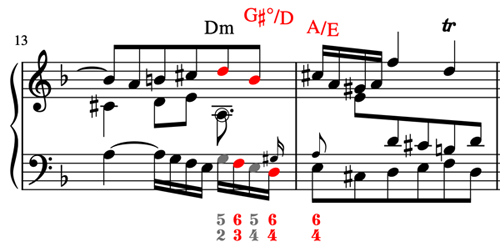
[N.B. The chord symbol Dm should be Dm/F] Bach didn't write that G-sharp, so the real harmony there is a "suspended" sound, but functionally that middle voice begs to sound a G-Sharp at that point, giving a second inversion diminished triad. If the voice were to continue sounding, then it would return to A on the downbeat as shown, resulting in a second inversion A Major triad. Do these clearer harmonies raise any red flags? Yes. Second-inversion flags. This is a pretty logical explanation as to why Bach didn't write these notes. Although the 64 on the diminished chord is passable, the downbeat 64 is very undesirable. We could say it's still there in Bach's actual writing, but the A isn't there, and a 6th without a 4th suggests an alternate root on the 3rd: C-Sharp to E. This is a trick of the trade you can also use to get around some cases of second inversion harmony. Use a rest, omit the 4th, and the sounding 6th is often acceptable, as it is here.
Bach was very careful in this piece not to repeat this configuration of voices. Bar 13 is in fact the only place in all of 44 bars this situation appears. The voices appear only one time again in a similar structure, in measure 27, in only two parts, but there Bach uses the inversion of the subject so that the structural tones and added dissonances form an entirely new constellation.

Much more time could be devoted to this. It would be easy to spend hours getting into the details of this piece. And it would be time well spent, very rewarding study. That's how Bach's music is. In the whole WTC, from one piece to the next he does such daring things, and if you look you'll find instances that just shouldn't work, but they do. Including parallel fifths! They are there in the WTC. I won't tell you where. See if you can find them!
Until next time,
AAH
New scores!
January 05, 2023
The first printing of »Der Lehrling der Fuga« (The Apprentice of Fugue) arrived today! I'm pleased with these results. The margins and the size of the notes and so on — things which are much harder to get right than you might think — all look right on, for both scores. The keyboard score is a normal A4 book, which is the a good size for reading and performance. The open score, having a higher page count, isn't really intended for performance, and I find it's especially attractive in the nearly Taschenpartitur format of 17x24cm (larger than most pocket scores). Having two different sizes brings an added benefit, that the keyboard score and open score won't accidentally get mixed up when shipping. Take a look!

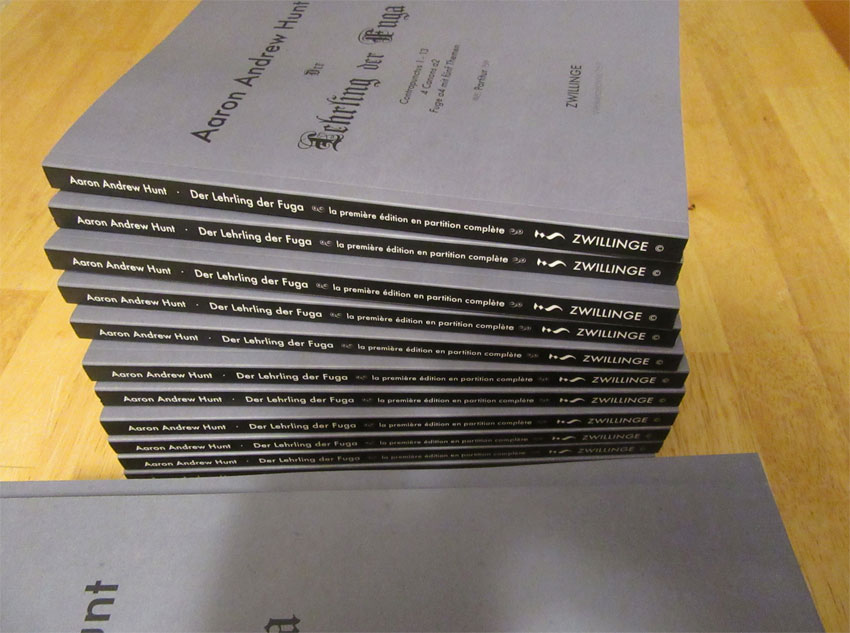
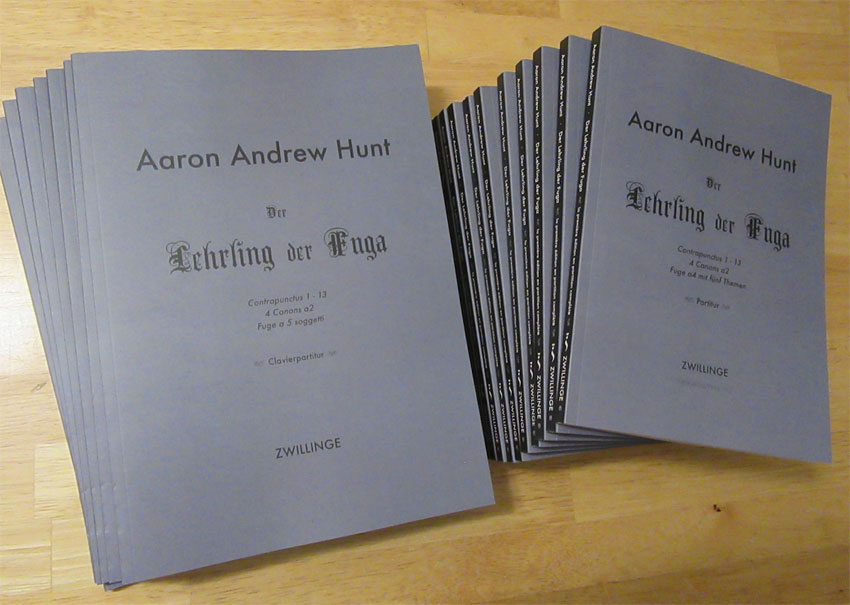


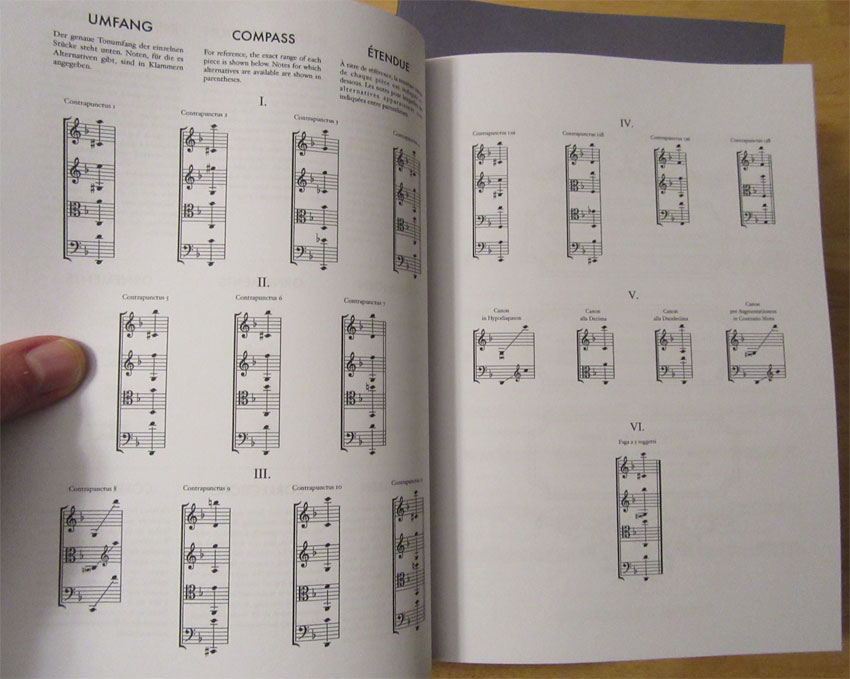
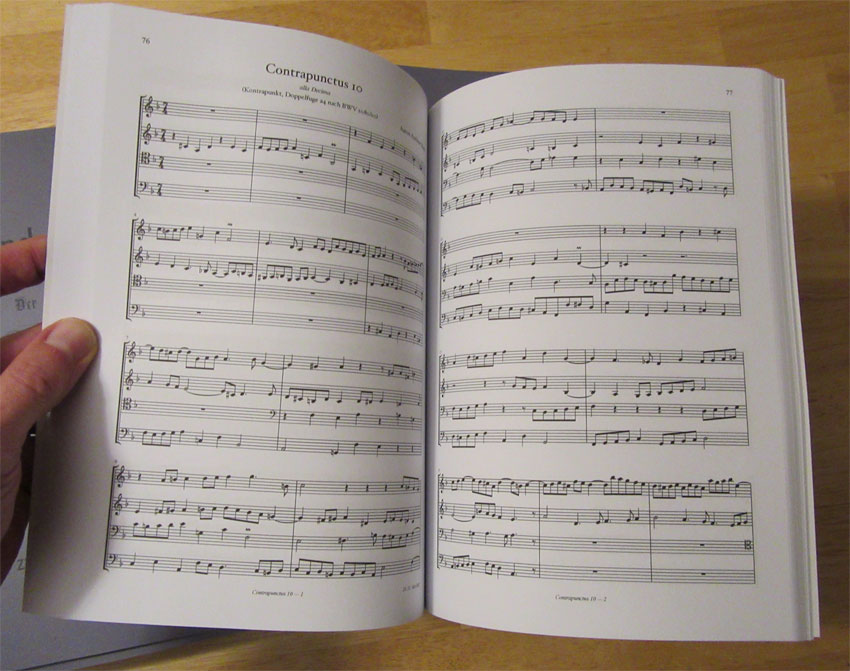
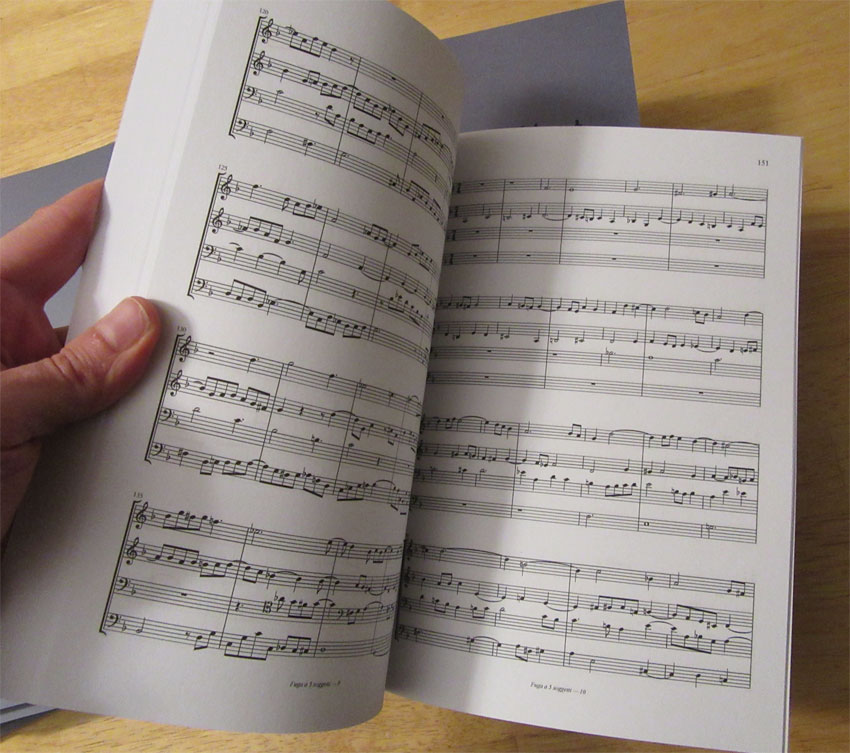
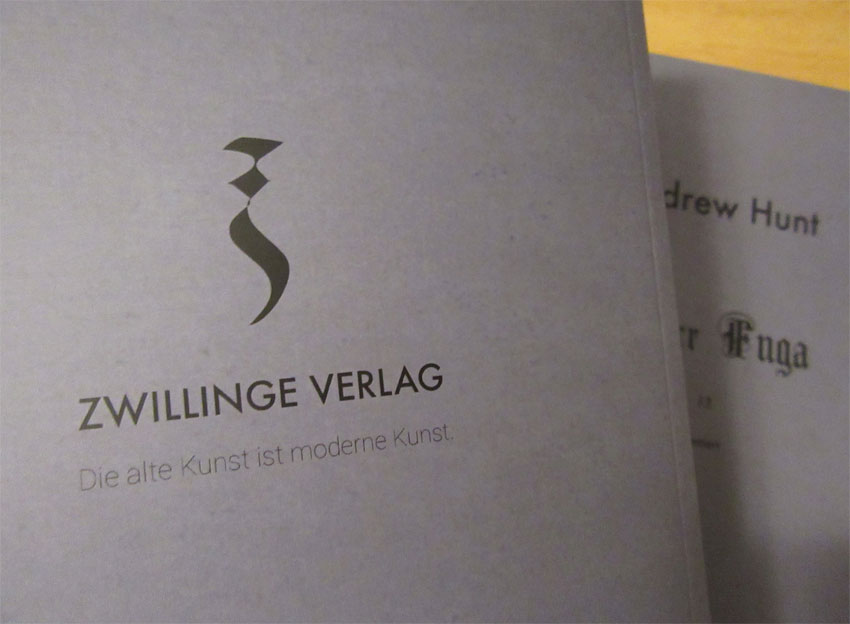
To the brave few who have already placed an order, thanks for your trust and patience. The books will be in the mail in the morning! If you'd like to have one of these, please place an order at Zwilling Verlag.
Happy new year everyone,
Aaron
Der Lehrling der Fuga (The Apprentice of Fugue)
December 14, 2022
As promised, the two-hour recording of Der Lehrling der Fuga (The Apprentice of Fugue) has been published today on Bandcamp.
If you've ever wondered what odd meters like 7/8, 5/8, 11/8, and 15/16 could possibly have to do with Bach’s Die Kunst der Fuga (The Art of Fugue), here's your chance to find out. Please note: this music is not an adaptation of the original. The music is newly composed, using the subject from the original, strictly following the techniques and formal models used by Bach.
The score is available in both keyboard reduction and open score, at Zwillinge Verlag.
Peace and blessings,
AAH
Der Lehrling der Fuga
December 02, 2022
I’m pleased to announce my latest work, Der Lehrling der Fuga (The Apprentice of Fugue), written during the past year — a time which has been devoted to intense study of Bach’s Die Kunst der Fuga (The Art of Fugue). This work is the result of a life-long fascination with Bach’s masterwork.
The structure of the original is followed, with 20 pieces arranged in six Parts: Contrapunctus 1-4, 5-7, 8-11, 12a-13b, four canons, and a final fugue. Each section is introduced with a short text.
Although we know now that Bach’s "unfinished fugue" does not belong to the Art of Fugue, since it has been included in all publications of BWV1080, and for other obvious reasons, my work also closes with a multi-subject fugue: Fuga a 5 soggetti (with not three, but five subjects).
A pre-release recording (PART I only) has been posted at Bandcamp. The rest will be released December 14. The score will be released later this month at Zwillinge Verlag, available both in keyboard reduction, and in open score (pre-orders may be placed now).
Thanks for your support,
AAH
Why are these parallel 9ths okay?
November 19, 2022
In my teaching, I try to avoid fixing student work by writing out a corrected version. Instead, I try to clearly mark every element that's problematic and do my best to explain why each thing has been marked, and what could be done to correct each problem. This way students are led to their own solutions. Sometimes though, to save time, particularly if we've been working on something for quite a while and problems are still cropping up, I might go ahead and just show something by writing out a new version for the student to compare with their version. Last week I did that for one of my students who is working on his first fugue expositions, and it so happened that what I wrote included the following measure:
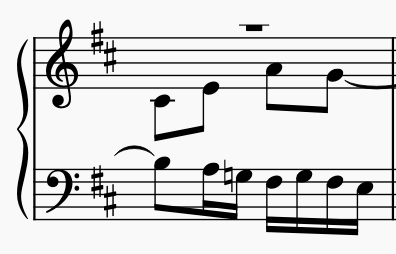
The student then pointed out that this measure contains parallel 9ths. Did you notice them?

He recalled that some time ago I had pointed out parallel 9ths in something he'd written as being a problem. Apparently, these parallel 9ths are okay, but why? A valid question. I explained it this way … The underlying voice leading is parallel 10ths. We can start there and work our way toward the version with the parallel 9ths:
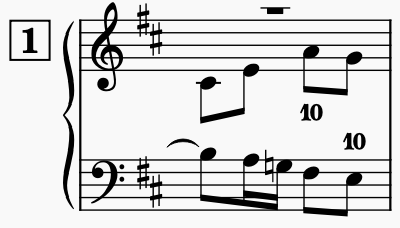
The F-sharp in the bass can be held as a suspension. The dissonant 9th sounds nice, and the F-sharp then sounds like it must move to the E to resolve the dissonance.
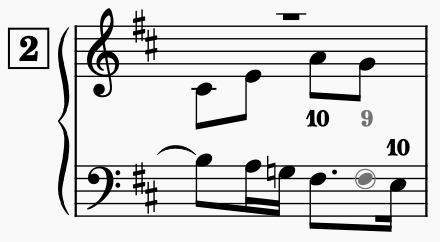
To further accent this dissonance while making the lower part more active, the suspension can be elaborated with an upper neighbour. This is where our parallel 9ths come in.
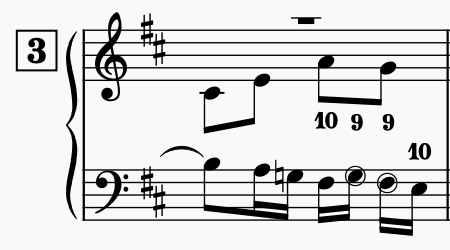
Parallel dissonances of this kind are a fairly common occurrence in Bach's music. Parallel 7ths and 2nds aren't entirely rare, since they result from this technique of emphasising dissonance and keeping voices rhythmically active — which is in fact one of the defining characteristics of Bach's music. Like everything else in this art form, there are a lot more ways to do it wrong than there are ways to do it right!
Best Regards,
AAH
Is counterpoint like chess?
October 24, 2022

Last week, one of my counterpoint students, who is currently working on the basics in two parts, asked me the following question:
Q: "What's it like to get better at writing counterpoint? Do you eventually get faster at considering many possibilities and discard weaker options (e.g. noodling lines), or do you get better at considering a few stronger options? Is it similar to chess or go where a weaker player considers many candidate moves and discards many options but apparently stronger players only consider fewer moves?"
Here's what I wrote back to him:
A: That’s an interesting question. Composing from scratch is enormously complicated, and I think music in general shouldn't be compared too closely with playing a game, but if we take the situation of writing counterpoint against an existing line, then there are some similarities to strategic thinking in chess or go. As with those games, you’ll learn to reject a lot of the “moves" that may seem reasonable to you now, and will get faster at seeing the “good moves" available to you. Eventually you will immediately see the “best moves", as the "expert player” does. Obviously, one can’t expect to achieve that level very quickly. It takes many years. Your confidence level and accuracy of self-perception will improve with time. In these games, the inexperienced players tend to think they know more than they actually do. They have false confidence out of ignorance (until they get demolished by the better player). The best players have worked hard to develop strong skills and the confidence that comes with that, and they will also tend to be humble about that and will want to help the weaker players to get better, because they have learned how difficult the game actually is. — AAH
Organ Recital in Hong Kong — October 15, 2022
October 06, 2022

I'm pleased to share the good news that organist Jonathan Yip (pictured, left) has chosen to perform my Chorale Partita »O Mensch, bewein dein Sünde groß« in recital at St. John's Episcopal Cathedral in Hong Kong on October 15, 2022. Jonathan's recital will conclude the Cathedral's Michaelmas Fair, a series of organ recitals which began in August. This performance will be a world premiere, and quite a unique event considering the length of the partita, which sets all 23 verses of the monumental Chorale text penned by Sebald Hayden in 1530.
The partita was published in 2019 in my book »Sechs Choralpartiten«. After the printed score became available, I decided to share a free PDF score on IMSLP, along with a free recording on Bandcamp (links at Zwillinge Verlag). Video animations of several movements from this and other partitas from the book have also been published on YouTube by Stephen Malinowski (example below).
As is the case with many Episcopal parishes worldwide, the music at St. John's Cathedral is of the highest caliber, which you can hear and see for yourself through the Cathedral's YouTube channel, where weekly choral Eucharist services, Evensong, and other special services are regularly broadcast (most are in English, some are in Chinese). The concert will begin Saturday, October 15, 2022 at 3 PM HKT (UTC/GMT+8).
Best Regards,
Aaron
‘Meet the Artist’ interview
August 12, 2022
A few days ago this short interview was published as part of pianist Frances Wilson's »Meet the Artist« project. I've discovered many interesting performers, conductors, and composers through this website. Take a moment and look around, you may be surprised by the insights shared there.
Best Wishes,
Aaron
Composing the ETK
February 02, 2022
The Equal-Tempered Keyboard has been available since January 2022, and has received a (surprisingly?) warm reception. Some readers have also expressed interest in the "forthcoming" text that is mentioned in the preface. In correspondence with those interested, I've had to admit that that text, tentatively titled "Composing in Equal Divisions of an Octave, 5ET to 20ET", remains unfinished. The idea is to discuss each tuning at some length, showing my approach to working with each tuning, along with musical examples from sketches and final scores. This kind of text can be useful not only for those interested in microtones, but for anyone interested in tonal composition, because each tuning imposes curious limitations on the kinds of patterns that will sound acceptable. For example, have you ever tried writing a piece that sounds minor, but contains no minor thirds? Have you ever written music that contains no perfect fifths? These are the kinds of challenges that arise when working with non-standard divisions of an octave. All quite interesting, but also very time consuming work. Having focused my efforts on completing the music and publishing the book, I unfortunately completely lost my motivation to work on this explanatory text. But I'm happy to report that, after admitting this, I received some encouragement, in the form of donations towards this work. So I will be working on this with an aim to publish as soon as I can.
So far I've determined that the text I've written up to this point (which was done sporadically over many years) is mostly worth keeping, but I will have to redo all of the musical examples, which is unfortunate, but at least better than having to rewrite the entire work. The book is planned as an A5 paperback, probably around 70 pages, but since I consider it worthwhile to translate texts into German and French, the end result will likely be around 200 pages. If the number of pages increases substantially, I suppose translations may also be printed separately, we'll see.
Thanks to those who are donating for this work. If you would also like to help, please support this project.
Stay well,
Aaron
Video Playlist: Bach Arias, but I wrote the obligato parts
January 11, 2022
As some of you know, I started this project near the end of 2020, in October to be exact. My idea was to add obligato instrumental parts to all of Bach's sacred continuo arias (those arias which were written for continuo and voice alone without any additional obligato instruments) with the aim that the new line should sound like it belongs there. The project ended up being 50 arias, though there are more which potentially could have been included. Some arias I didn't work with for various reasons, and there are also more candidates in the secular cantatas which aren't included. In all, the project took about a year, working one day per week. As I write in each of the video descriptions, I did this to learn from Bach's compositions, to challenge myself and improve my skills, and these are all drafts which may be improved. And please note: I wrote only the obligato parts which are marked with an asterisk in the score, J.S. Bach wrote everything else! I used original recordings mostly from John Eliot Gardiner, but also from Philippe Herreweghe, Masaaki Suzuki, Ton Koopman, Kay Johannsen, and others. The obligato tracks were added by me.
Of course, some of my efforts are more successful than others. The important thing for me is that I learned a lot from doing this. I may try some of then again later, or work on some of the secular arias. Lastly, if the embedded playlist above doesn't work for some reason, here is a DIRECT LINK TO THE PLAYLIST .
Happy 2022, and please stay well everyone.
Aaron
The Equal-Tempered Keyboard, first edition
December 30, 2021
Today is a milestone for me, as the first edition of my book »The Equal-Tempered Keyboard« has finally been published — a collection of microtonal Preludes, Fugues, and Inventions, written (sporadically) over a period of more than 20 years (!) The score is available through Zwillinge Verlag. In 2022 it should also be available on Amazon. Thanks to my friends Patrick Ozzard-Low, Wolf Peuker and Stéphane Delplace for help with editing and translating the preface in English, German, and French, respectively. I'll make a recording of all this music, but that will take some time ...
Cheers,
Aaron
New book — 24 Präludien und Fugen, Band 1, zweite Ausgabe
November 13, 2021
I'm happy to announce the new revised edition of my »24 Präludien und Fugen, Band 1«. A free PDF is on IMSLP and print copies are available from Zwillinge Verlag. This revision took many months to complete. All the errors in the first edition are fixed, the music is improved here and there, extreme care has been taken this time around for things like page turns and proper staff assignments for inner parts, and everything is now playable on a 5 octave harpsichord (FF-f'''), with ossias for instruments of smaller ranges. The book also concludes with a 'new' quadruple fugue in B Minor from 2013 (reworked 2021) which was originally intended to close the cycle. A new preface in English, German, and French explains the details, thanks to my friends Wolf Peuker and Stéphane Delplace for input on the German and French versions respectively.
Cheers,
Aaron
How to make score read-along videos - fast!
March 23, 2021
A couple of years ago I spent some time making YouTube videos of some of my early scores, read-along style. This was a rather painstaking process, involving manuscript scanning or notation tweaking and taking a lot of screenshots, editing images and audio files, and finally putting things together with video editing software. After having done that many times, to be honest I wasn't too keen on doing it again, but after posting a few score images on this blog at the start of my latest project (reimagining Bach's continuo arias), I realised that the best way to share this work would be through YouTube videos.
In the mean time I've also changed my notation software and my video editing software. I felt sure by now there must be a faster way to get results than what I had done before. Sure enough, it turns out these videos can be made in a matter of minutes. I was asked on Facebook how it's done, and I thought the best answer would be to go through the process step by step here.
I assume you have a completed score and a recording of your piece, and a YouTube account. (Making a recording could be topic for another time.) All you need are your notation app and a video editing software capable of uploading to YouTube. I'm using MuseScore and Adobe Premiere Elements, which I can recommend since I know they work well for this, but I assume these steps will transfer to other software.
Begin with your finished score, and follow these steps:
- Copy the source file and rename it Title-VIDEO
- Put that file in a new folder inside your project folder, and name that folder VIDEO
- Set the page dimensions of this new file to 300 mm x 170 mm with 15 mm margins
- Export the score as .PNG at 600 dpi.
The folder is there to hold not only your score but all the supporting files needed to make your video, which (if you're at all like me) you'll want to keep separate from your score since video editors tend to create a lot of subfolders that will otherwise clutter up your workspace. Step 3 makes your score fit the HD screen. It's virtually 16:9 using numbers that are easy to remember, though you can be more exact if you like (302 mm x 170 mm or some other numbers that are in 16:9 proportion). In MuseScore you can do this once and then save the page layout as a Style. Then you just need to use Load Style. The above altogether in MuseScore takes less than a minute for 8-10 page pieces. The most time is taken waiting for the .PNG images to render, so be smart and use that time to set up your video editing app.
Next, in your video editing app, do the following:
- Open an empty project for HD, and save it in the VIDEO folder you made
- Import the images into the project
- Import your audio into the project
- Place the audio on the timeline
- Place the images on the timeline in order, staggered at estimated intervals
- Tweak the placement and duration of the images to match the audio.
- Once the page-turns are all in place, upload to YouTube
Of course here the longest time is spent on the next-to-last step, but once you do a couple of these, you get a sense of where to place things. Premiere has a convenient drag and resize feature that lets you put images side by side and then drag-resize only the left image, and the right image drags along with it, so essentially you're just dragging the page turn point. How long it takes to get all the pages right depends on the length of the piece and how uniform the page turns are. For a work with a consistent tempo where the same number of bars appear on each page, the pages will end up taking equal space. Premiere makes the YouTube upload very easy. Once you allow the app access to your YouTube account, to upload the video you just click a button and type in the info for the video.
A few caveats about the specific software I use - this type of thing will vary based on what apps you are using, but I imagine probably all apps have some quirks you'll have to work around. Adobe could stand to improve their interface for YouTube uploading, as the right-left arrow keys don't work in their input fields (how absurd is that?) The obvious workaround is to type out the info in another app and paste it in. Adobe is also quite lame here as the keyboard shortcut for Paste also doesn't work, but luckily a right mouse click allows pasting. So once you get the hang of it, it's no problem. If you're like me and want to post a lot of similar videos, it helps to have a template for the text anyway. Another small caveat concerning the MuseScore .PNG export is that the files get numbered using suffixes, so you get Title-1.PNG Title-2.PNG etc. which seems fine, except that Premiere doesn't display the full file names after importing, and only shows you thumbnails of the images (which are likely to be totally indistinguishable from each other - imagine viewing the pages of your score at a distance of 50 meters), so after exporting the images, I manually rename the files putting a number at the beginning, so I end up with 1-Title-1.PNG, 2-Title-2.PNG, etc. so that I can see which page is which in Premiere. (Prefixed names should obviously be made an export preference in MuseScore, so I'll be requesting that.)
And that's all there is to it. Here are the few videos I've made so far using this method. You'll notice on the first one I hadn't quite got the HD page size correct, and I had exported the .PNG files at 300 dpi so the image quality is under par. If this helps you make your own score videos, let me know.
Stay well,
Aaron
Gott hat uns im heurigen Jahre gesegnet
January 01, 2021
I'm continuing my studies of Bach's continuo arias, adding obligato parts of my own. This week I chose BWV 28.5, "Gott hat uns im heurigen Jahre gesegnet", a duet for Alto and Tenor, from the cantata "Gottlob, nun geht das Jahr zu Ende", appropriate for the new year.
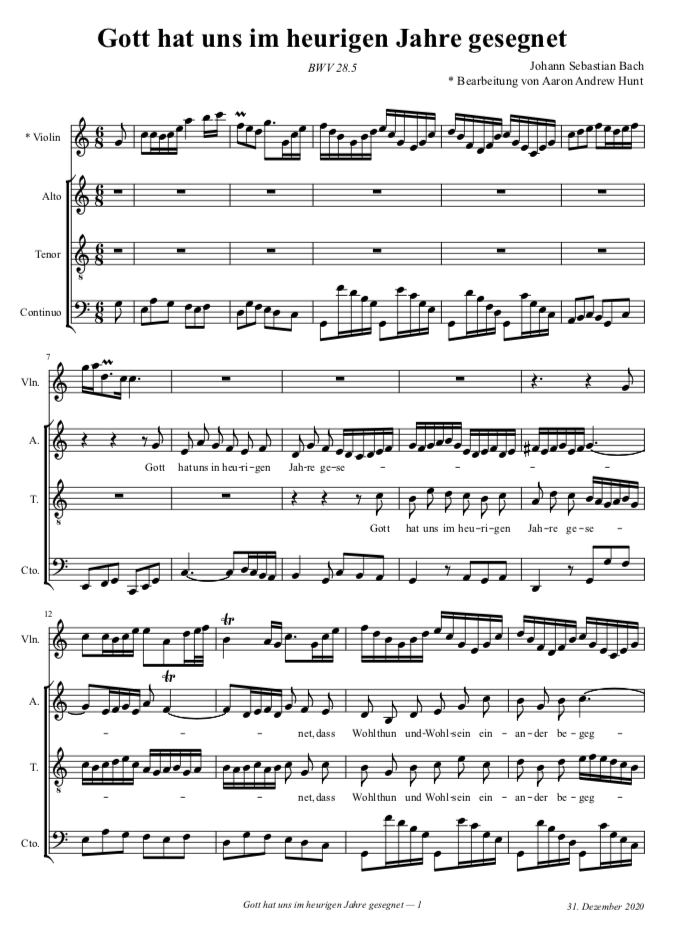
The original recording is from John Eliot Gardiner. The added part is written for violin, but was played here on organ using the Jeux SoundFont.
The text is about being grateful for the blessings of the past year, and trusting for a good year to come.
Gott hat uns im heurigen Jahre gesegnet,
dass Wohlthun und Wohlsein einander begegnet.
Wir loben ihn herzlich und bitten daneben,
er woll' auch ein glückliches Neues-Jahr geben.
Wir hoffen's von seiner harrlichen Güte
und preisen's im Voraus mit dankbar'm Gemüthe.
My translation:
God has blessed us in this year,
so that doing well and being well come together.
We praise him from the heart and ask along with this
that he will also give us a happy New Year.
We hope for this because of his persevering goodness,
and we give praise in advance with a grateful attitude.
I'm sure we can all think of ways this past year has been pretty awful. I for one lost my father to cancer. My friend died of COVID-19. I've been more isolated than ever before in my life. The list could go on. But, let's compare our standards of living to those of 1725, the year this cantata was written, when it was for example common for most children to die of illness within the first few years of life, when common viruses regularly killed otherwise healthy people, and when life expectancy for those who survived was around 50, to say nothing of the undrinkable water, no electricity, etc. In the Western world, and especially in Western Europe, we now have basically the highest standard of living that has ever been achieved on earth. Nevertheless, life can bring us down, mentally, emotionally, physically, spiritually. We are called to remain thankful for our blessings and to persevere with grateful and hopeful hearts. Let's do that.
Amen.
— Aaron
Reimagining Bach's Continuo Arias
December 10, 2020
In his over 200 extant Cantatas, Bach wrote a fair number of Arias for voice and continuo with no obligato instruments. Some of these have figures written in the continuo part, but many do not. Some of these pieces do genuinely sound as if some obligato voice is missing, and in a couple of cases we know a part was lost. Other times it's clear that Bach intentionally chose to write no obligato parts. Listening to performances of these works makes it pretty clear that musicians feel some responsibility to fill these pieces out a bit. Normally the continuo will improvise a lot of filler figures. There may also be double continuo (organ and harpsichord together) to achieve a richer effect. In whatever way the music is performed, there seems to be a general agreement among those playing that, indeed, something is missing here, and there is room to "beef it up" a bit. This room for improvisation makes hearing various performances exciting and interesting.
Over the past few years I've written a few vocal Arias of my own, but have found myself all too often feeling my limits, getting results of varying quality, sometimes clearly subpar. For that reason, all my planned Cantatas remain unfinished. I could just give up, but I decided what I need to do is to study more, and get better. So a few months ago I embarked on a new project, in which I'm given clear direction by the master himself. Every Sunday afternoon I select one of Bach's continuo Arias, copy it in its entirety the way Bach wrote it, and then add my own obligato instrumental part to it. So far I've completed 13 pieces (there are over 60 to choose from). This has been very rewarding so far. it's an excellent way to get into this music and really learn how it's put together, more than I would learn simply by playing through and analysing.
Writing a new line of counterpoint which works along with two existing lines can sometimes be tricky, and at times difficult to choose from many possibilities, but mostly it's easier than composing from scratch. In one sense, this kind of exercise is what continuo players are doing all the time, improvising harmony that goes with the written bass line (and, more often than not, the figures). But writing a solo part is not quite the same as continuo realisation. One of the reasons I thought of doing this project was the fact that very active continuo playing tends to annoy me, because what gets played almost always sounds, well, a bit too improvised. It doesn't have the same kind of thematic coherence as composed music. It sounds at best comparatively less well formed than what is going on around it, at worst disconnected and distracting. The thought occurred to me, that a coherent and purposeful melodic line could do a better job filling in the space.
Here's an example to show you what I mean: the continuo Aria for solo Bass, "Wohl zu thun und mitzutheilen" from Cantata BWV 39 "Brich dem Hungrigen dein Brot" The original score does not have an obligato organ part; I wrote the top line, and then played it along with a recorded performance of the work.
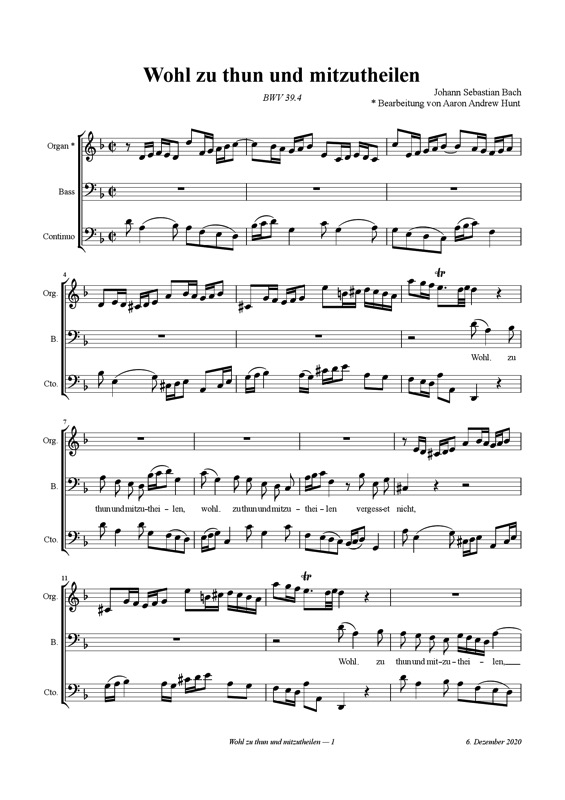
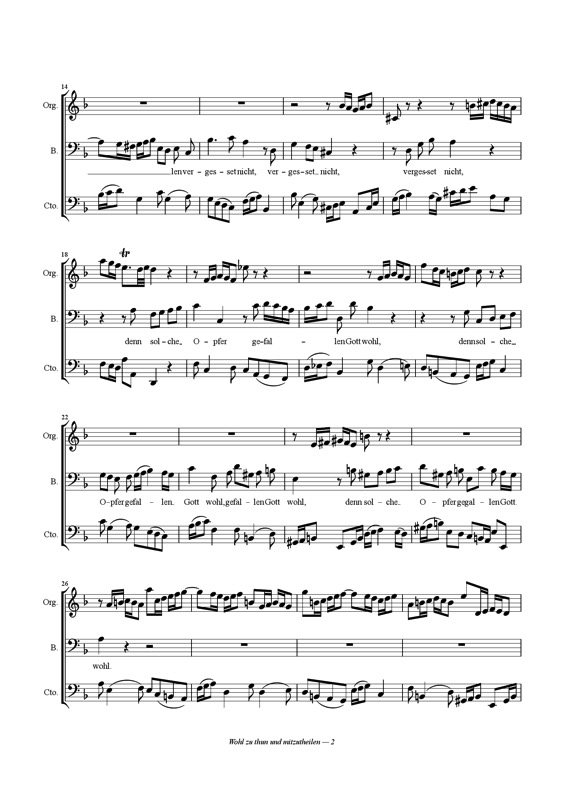


The original recording is from John Eliot Gardiner. The added part is played using the Jeux SoundFont. (Although I could use Hauptwerk to get a real sounding organ, the reverb mix unfortunately doesn't work with the recording.) For each piece, I try to add something which sounds like it belongs, like it could have been part of the composition. How closely I reach that goal varies, but my main goal is always reached — namely, that I'm challenged to do and learn something new, by working within existing music that is, without my contribution, already basically perfect.
In the process I'm also finding out a lot about how Bach worked with various texts, which to me are often highly relevant. Take this piece for example:
Wohl zu thun und mitzutheilen,
vergesset nicht,
für solche Opfer gefallen Gott wohl.
My translation:
To do and to share wellness,
don't forget,
for such offerings are pleasing to God.
Which reads a little better in English if we reverse the first two lines and add another word like so:
Don't forget
to do good and to share wellness,
for such offerings are pleasing to God.
Amen.
Stay well,
Aaron
New book — 24 Präludien und Fugen, Band 2
November 21, 2020
In August 2020, I finished writing my second book of 24 Preludes and Fugues. As with any large project, it takes a while after the music itself has been written to proofread everything, make a table of contents, decide on a cover for the book, and so on. The result is now available through Zwillinge Verlag.
Having given the book a final proofreading after its first printing, several minor errors were corrected, and a free PDF is now available on IMSLP.
The Prelude and Fugue in F Minor from this book was made into an animated video by Stephen Malinowski back in February (just after the music was written).
Recordings of the original drafts of most of the pieces have also been published on Soundcloud over the past couple of years, but many finished versions have not yet been recorded. At some point I will release a free recording of all the music on bandcamp.
I feel the book stands well as a collection, and may even show some improvement based on my studies over the past few years. The pieces are all intentionally quite short, intended for all skill levels including intermediate, though some pieces like the fugue in F-Minor are quite challenging to play up to tempo. Many of the fugues are written in only two parts, which makes them of course easier to play, and I think that's a very important quality since keyboard fugues in general have a reputation for being rather difficult to play. There are also many three voice and some four voice fugues, but in contrast to my first book of preludes and fugues which didn't have any particular plan regarding length or difficulty, here I aimed to keep the playability at a reasonable level, and I think that goal was accomplished pretty well.
I do know enough to know for certain that this music is not bad. I'm all too aware that it's never as good as I'd like it to be. Life-long learning hopefully also means life-long improving. I'm happy with this, but God willing, there will be better stuff yet to come. That's the plan, anyway ;)
Please be careful and stay healthy everyone,
Aaron
Konzert in Zeitz
October 20, 2020
In September, my chorale partita "Von Gott will ich nicht lassen" was performed by organist Babett Hartman and soprano Dorothee Mields in the Zeiter Dom, the cathedral made famous by Heinrich Schutz (1585-1672). The concert was recorded and posted on YouTube in two videos, one featuring my piece alone. The concert also got a nice writeup in the Zeitz paper.
Although the partita was written for organ solo, the chorale melody appears in a majority of the movements without ornamentation so that the tune can be sung along with the organ. The idea of singing along was already in my mind as I was writing the partitas in 2018, and it worked so well, I think it may be worthwhile to write out soprano parts for the other partitas as well. If and when I do that, I'll post them on IMSLP (where the score Sechs Choralpartiten can already be downloaded for free).
Stay well everyone,
AAH
How to hide incompetence
August 19, 2019
Let's say you've got good counterpoint chops, but you have trouble sorting out your ideas, and when it comes to form, you struggle. Here's how to cover that up.
- Make it busy.
- Add more ideas.
- Use more techniques.
- Make it long.
Any of these things will draw attention to your strengths and distract listeners away from your weaknesses.
If you need examples of how these tricks work, your hero is Johann Ludwig Krebs (1713-1780). Krebs could have been a great composer, but he wasn't. If only he had had a better teacher… oh, wait, Krebs was a student of Johann Sebastian Bach. In fact, it has been said that Krebs was Bach's best student. Some claim that even Bach himself said this. I think if Bach said this, he was just being polite. Bach had been a friend of Krebs's father, and Krebs jr. also worked for Bach. On the other hand, just because Bach was a great composer, that doesn't mean he was a great teacher. But his students tended to write very good counterpoint, so we guess Bach was a pretty good teacher. It's true that Krebs could write counterpoint very well. But there is a reason not many people today know who Krebs was. The reason is that Krebs was not a very good composer. Sadly, when it comes to his free organ works, he was a pretty bad composer. Why?
Despite his very Bach-like counterpoint, Krebs's music falls short. The main problems are too many unfocused ideas and a sense of timing and form that is all but nonexistent. A sort of mindlessness pervades Krebs's free organ music. Perhaps even worse, there is a sense of "Oh, I can do that too!" If one were to judge his music only by these free organ works, Krebs seems to be an 18th Century "wannabe" composer.
It is instructive to compare the organ music of Krebs to Bach's organ music. One can learn some things this way about what makes Bach's music so good. On the surface, Krebs's counterpoint often looks like Bach's, but important things are missing - things like reason, coherence, and purpose. Krebs's work is sort of like what artificial intelligence might be able to produce from studying Bach. AI produces brainless output. It has no mind and no soul. That is what Krebs's free organ music tends to sound like. Sometimes Krebs simply stole directly from Bach (which is incidentally something attempts at AI-Bach composition also have done). For example, in Krebs organ Toccata in a-Moll (Krebs-WV 411), there are a few bars which are suspiciously similar to Bach's Toccata in F-Dur BWV540. Listen and compare:
Krebs-WV411
Bach BWV540
Notice the pitch levels are even the same. This is not really so surprising, since we know that Krebs copied Bach's organ scores by hand (in fact many of Bach's works were preserved only as hand copies from Krebs!) Listen to a little more of both works, and the difference in quality between them is not hard to miss. Where Bach used a strong idea and worked it out brilliantly with perfect timing, Krebs simply stole the idea and dropped it into his music with no rhyme or reason. The idea appears briefly and has basically no relation to anything around it. Krebs even oversteps a very basic guideline and pushes the stolen sequence one step further than Bach did. Then music just keeps plodding on and on, for no real reason. There are numerous other instances of this kind of thievery. In this even more appalling example, Krebs lifted a sequence almost note for note out of Bach's Die Kunst der Fuga (The Art of Fugue).
Krebs Partita in B-Flat
Bach BWV 1080
Again, the pitch levels are the same. Conicidence? Not likely. (By the way, I've never seen anyone else point these things out.) That J.L.Krebs obviously had his mitts on The Art of Fugue seems like something musicologists should be looking into. Maybe they have and I just never heard about it. I suppose it's possible that Krebs slipped in these little quotes from his teacher on purpose as jokes, in order to get a rise out of Bach. But I don't get the sense that Krebs wanted his music to be funny. Or maybe these really are Krebs's ideas, gems amidst the chaos, and Bach cherry-picked them from Krebs to develop in his own music … and maybe unicorns exist.
Besides writing good counterpoint, technically speaking, what Bach was able to do better than anyone else was to tell a good story. In Bach's music, the technique alone is not only solid, and the ideas are not only strong, but the form is also balanced, the timing is right on, the drama is effective, and the feeling is authentic. In a good story, we care about what happens, we find meaning, we are moved emotionally, and by the end of the story, we feel a sense of catharsis. How that is done is not easy to understand or explain. But that's what Bach was able to achieve with his music, and that's what distinguishes his music from mere counterpoint.
Though Krebs fell short of being able to tell a good story, we can be grateful to him for teaching us thereby that writing good counterpoint, though it is a good start, is not enough. Not nearly enough! So far, Artificial Intelligence (which in fact means brainlessness and soullessness) teaches us something similar.
Maybe you have figured out by now that the tricks listed above don't actually work. When the music is busy, has lots of things in it, and is long, and technically dense, that is very likely to be a bad piece of music, where no coherent story is being told. Instead, it's similar to someone babbling. Babies babble. Most of us did this in our infancy. It was entertaining, for a while. It's how most of us learned to talk. As we get older, we have a choice to make: to continue to babble forever, using distraction to get by, or to grow up and get to work on telling good stories.
Best Regards,
Aaron
New album released - Sechs Choralpartiten
May 07, 2019
I've released a (free) recording on bandcamp of my work over the last year, composing an average of about 1.5 days a week, The German title "Sechs Choralpartoten" means "Six Chorale Partitas" in English. 61 tracks add up to a little over 2 hours of music as follows.
- Alle Menschen müssen sterben (27 min.)
- Von Gott will ich nicht lassen (19 min.)
- Straf mich nicht in deinem Zorn (26 min.)
- Ich steh an deiner Krippen hier (12 min.)
- Das alte Jahr vergangen ist (8 min.)
- O Mensch, bewein dein Sünde groß (78 min.)
The full track list, full text and some comments are on bandcamp. The organ is the beautiful OrganArt Media Vollenhove Bosch-Schnitger, a brilliantly done sample set.
This project started in April 2018 and lasted until the end of April 2019. The scores will also be published later this year. are published as free PDF download on IMSLP and in print copy by Zwillinge Verlag.
Regards,
Aaron
O Mensch, bewein dein Sünde groß
February 19, 2019
Almost a year has passed since my last post here, in April 2018. Needless to say, a lot has happened. I won't try to summarise. Instead we simply pick up the thread today.
Later this year I'll be publishing a collection of six chorale partitas for organ (a few hours of music). This setting of O Mensch, bewein dein Sünde groß is my most recent work. The melody is by Matthias Greitter, 1525. The text is a retelling of the Passion of Christ in 23 strophes, written by Sebald Heyden in 1530. Only the first and last strophes are used in the modern Gesangbuch, so that very few people know that the other 21 strophes even exist. I've chosen to set all 23 strophes, which presents some interesting challenges. The tune itself is not short. In fact it is so long that it may seem like questionable aesthetic judgment to set the melody 23 times for organ. This is why I am using many techniques to ensure that the material remains engaging throughout. For example, this piece is a setting of not one but four strophes. The texts are set in two canons, each led by the tenor voice. The answering voice of the first canon is hidden in the soprano in inversion at a very short distance (one beat, and even closer in a couple of phrases). The second canon is easier to hear, between the tenor and the pedal, with the melody upside down in both parts, in the minor mode.
Regards,
Aaron
Alle Menschen müssen sterben
April 09, 2018
My setting of the great Chorale by Johann Georg Albinus (1652) [alternately attributed to Johannes Rosenmuller (1620-1684)]. I chose a meter of 5/8 because the number 5 is associated with mankind (fingers on a hand = 5, toes on a foot = 5, 2 arms + 2 legs + 1 head = 5, primary senses = 5, and so on). This tune is usually pitched in A or G. I chose the key of F because of another project I'm working on, in which I want to include this melody in F.

The performance was recorded using Hauptwerk, with the Bosch-Schnitger Vollenhove organ from OrganArt, which is pitched at 419.4 Hz.
Regards,
Aaron
N.b. I forgot to write a few dots on some of the quarter notes. Can you find the missing dots?
2 new books available - Previews
August 06, 2017
My devoted blog-followers (yes, both of you) will recall that I've been working on a new book for publication. I'm happy to announce that Suite of Mirror Canons in C and Treatise on Canonic Inversion with collected works demonstrating mirror canons, is finished. Weighing in at 163 pages, it includes a 47-page treatise, 7 Double mirror canons for string quartet, 7 mirror canons for keyboard, and over 30 additional works based on mirror canons for various instruments, written between 1995 and 1997. A live recording of the Suite is also available for download, with previews at the Zwillinge website. Below is a preview from the book, one of the double canons for string quartet, with audio. Click the image to download a PDF.
Check out the book at Zwillinge.
As I was preparing the additional material for that book, I realised that several of the more substantial works would be better off published in a separate volume. The result is the 123-page 32 Sacred Canonic Choral Works. This collection contains works based on direct canons as well as mirror canons. Many of the pieces come from a collection of Canonic Hymns and Preludes, written in 1994-95. For that project, I chose texts from the Lutheran Hymnal. Each text was set to a canonic melody, and at least two works were written, one a conventional four-part hymnal harmonisation, and the other a canonic realisation. Each set of works could also include one or more preludes for organ, implementing the canonic tunes in different ways. For example, the tune I composed for Judge Eternal, Throned in Splendor is a canon at the octave with a symmetrical mirror retrograde form. A 3-voice setting is shown below, with audio. Click the image to download a PDF.
This tune can be written as a puzzle canon in several ways. Here's one option. When you get to the end of the line, turn around and read backwards, following the dotted barlines and the mirrored note values.

With the text added, it looks like this:

Check out the book at Zwillinge.
A third book of my earlier music is also on the horizon. It will be a collection of 17 Festival Hymns for choir, organ, 2 trumpets, 2 trombones, and timpani, from the years between 1999 and 2002.
Regards,
Aaron
Festtag!
July 20, 2017
Heute ist für mich ein Festtag, denn ich wohne jetzt seit einem Jahr in Deutschland. Mein Deutsch ist immer noch ein bisschen schräg, aber es hat sich seit meiner Ankunft viel verbessert. Deshalb schreibe ich jetzt meinen ersten Blog-Vermerk auf Deutsch. Na ja, ich mache das nur ganz kurz. Natürlich würde es besser sein, mein Blog weiter auf Englisch fortzuführen. Gut, dann das mache ich jetzt. Übrigens, falls Sie Deutscher sind, und ein bisschen Zeit für mich haben, können Sie meine Fehler gerne korrigieren. Das wäre toll. Vielen Dank!
For those of you who don't read German, what I tried to write above goes something like this in English: Today is a special day for me, because I have now lived for one year in Germany. My German is still a little odd, but it has improved a lot since my arrival; therefore, I'm writing my first blog entry in German. Well, I'll keep it short. Of course, it would be better to continue my blog in English. Good, I'll do that now. By the way, if you happen to be German, and you have a little time for me, please correct my mistakes. That would be great. Many thanks!
Regards,
Aaron
P.S. Thanks to my friend Wolf for sending corrections. They are shown above in underline. I had previously written "Fehlern" as the plural of Fehler, which was, ironically, itself a mistake (the word "Fehler" means "error" or "mistake").
Looking Back: 7 early works
July 20, 2017
Over the past few weeks I've been reviving some old forgotten pieces of music I wrote when I was in my 20's, posting them as video scores on YouTube. Why do that?
As I was writing new music over the past year, at some point I realised that my old works were asking me an important question. The question was this: What are you going to do with us? There are stories of well known composers who destroy all their early works. Brahms comes to mind. I thought for a moment about doing this, but to me it seemed inhuman and wrong. I decided that it makes much more sense to share my early work than to destroy it. This way, assuming that the music I write now — 20+ years later — is actually better (no guarantees there), then maybe a sense of progress might be found in what I've managed to do. After all, I still like the things I wrote back then. There are a few pieces that I would call unsuccessful, that I consider not worth sharing now, but most of what I wrote as a younger me was really not bad. The best of my early pieces were quite flawed, for sure, but I'm not embarrassed by them. On the contrary, I like them. Maybe this has something to do with the fact that I'm very aware that the music I'm writing now is still quite flawed, in ways that I know I can't understand right now. I won't understand until later. That's a big part of continuing to learn and improve. The more I understand about what I’m trying to do, the more flaws I can see in what I’ve done up to that point, and the more wary I am that anything I’m doing is ever as wonderful as I want it to be, but that doesn't stop me from daring to continue. This is something I simply didn't think about when I was younger. Maybe now I think about it too often, but it keeps me grounded.
Here are the works I've posted in the past week to YouTube, in reverse chronological order.
In 1997, I was 25 years old, just out of graduate school, and being away from the conservatory meant that most (not all) of the music I was writing at that time was doomed never to be performed. That situation continued until I started teaching theory and composition full time in 2002. This is why for the works between 1996 and 2002, I have no live recordings, only electronic realisations. For the English Mass and the Trio in e, I used MIDI Tapper to produce acceptable audio for the video scores. See what you think. If you like any of these pieces, let me know. Scores of the student works are also posted as free PDF downloads.
English Mass (1997)
for four voices SATB … the mass text set in English using simultaneous mirror canons in unequal intervals of inversion and time. The credo includes a wide variety of contrapuntal techniques in addition to mirror canon, and is written in an experimental declamatory rhythmic notation. You may notice occasional parallel perfect consonances. These were written intentionally in the original version. I haven't decided yet if I'll change any notes before publishing the score.
Trio 1 in C (1997)
originally written for pipe organ … upper parts in mirror canon, freely written bass line … one from a set of three trios, and also one from a set of four variations on (the harmonic structure of) a two-part invention written in 1995.
20 Reflections (1997)
for unspecified instruments … mini-compositions using double and triple mirror canons. Originally intended for public radio as “bumper music” between spots, but never used. The recordings are also from 1997, made with a Korg 01/W keyboard, recorded to minidisc. I couldn’t find the disc containing a few of the pieces, so I had to make a few new recordings. I no longer have the Korg, and I didn’t want to spend too much time on this, so I used soundfonts, which sound comparatively lame. I had also uploaded an earlier version of this video, but then I found some errors in the score, which have now been corrected. The original notation was done by hand, on graph paper, and I made a few mistakes when transcribing that into the computer using standard music notation.
Trio in e (1996)
for pipe organ … upper voices in mirror canon, pedal part freely composed
Fuga a3 in a (1993)
undergraduate final project for 18th Century counterpoint class in 1993, with a few improvements from 2017 (changes are written in red). No, the world probably doesn’t need this fugue, but I’m sharing it here anyway as a way to thank my counterpoint teacher, Dr. John Miller, who is now director of the department of music at North Dakota State University. PDF score
for W. David Hobbs (1992)
for piano …
W. David Hobbs was professor of piano at Eastern Illinois University from 1991 until his early death from cancer in 2007. He was my teacher, mentor, colleague, and friend.
David took me on as a private student in 1991, which was unusual, because piano was not my major instrument. In fact, I had only taken a handful of piano lessons in my life. I was allowed to focus on the works of J.S.Bach in my lessons, which helped me immensely as a composer.
In 1992, David asked me to write a piece for him. This eight-part work, which alternates between abstract harmonies and quasi-baroque counterpoint, is the result. At that time, I had not formally studied counterpoint — a fact evident in the many flaws of this (hand-written) music, but the piece shows what I had absorbed from my lessons with David, in addition to what I had been learning from my composition teacher, Peter Hesterman.
This is David’s rendition, the first performance of the work, recorded live. He also played it during his summer concert tours around the midwest in the mid 90’s. In the 25 years since its inception, the work has remained unplayed by anyone else. I now dedicate it to his memory.
Thank you, David …
Suite for Violin and Marimba (1992)
In 1991, a composition contest was announced by marimbist Nancy Zeltsman and violinist Sharan Leventhal, then known together as the actively performing and recording duo Marimolin. At the age of 19, having studied percussion for almost a decade, my experience playing marimba allowed me to write easily and idiomatically for that instrument. On the other hand, I had been taking viola lessons for only about a year, and writing for violin was much more challenging for me. I threw caution to the wind, quickly wrote a single-movement work in 7/8 and submitted it to the contest. Although the piece was not selected as a winner, I was happy to receive a personal letter from Zeltsman and Leventhal which included some helpful feedback and encouragement for me to expand the work for submission to the next competition the following year.
That earlier work became the core of the second movement of a five-movement Suite as it stands in this score, completed in June of 1992 and newly resubmitted with high hopes to the next Marimolin composition contest that same year. By that time, I had taken two academic years of music theory and ear training, although I had not yet studied counterpoint. The five movements of the suite alternate slow, fast, slow, fast, slow with fast movements in 5/8 and 7/8, totalling around 13 minutes of music.
- Prelude — ca. 3 min.
- Scherzando — ca. 2 min.
- Intermezzo — ca. 2 min.
- Vivace — ca. 4 min.
- Postlude — ca. 2 min.
This new larger piece was unfortuntely again rejected by Marimolin, and this time I was given no feedback. I was disappointed, of course, but remained confident in the value of the work. Twenty-five years later, I am glad to find that the music stands up relatively well, despite its flaws.
Personally speaking, I wrote this music not for a contest, but for my friends and fellow undergraduate students, percussionist Jeff Magby and violinist Rebecca Walker. Many intense rehearsals preceded their premiere performance in the spring of 1992. In the intervening years to date, nobody else has played this music. I now therefore formally dedicate this piece to both of them, with renewed thanks.
A final note to marimbists who may consider playing this music — it is in some places admittedly extraordinarily difficult, requiring very large stretches, but it is not impossible. Also, as I checked the score against the only existing recording, I found that Jeff sometimes altered rolling for playability. I have not changed the score to reflect these differences, but please exercise your best judgement concerning the sustaining of notes.
STUDENT PERFORMERS
Jeff Magby — marimba
Rebecca Walker — violin
N.B. violin glissandi are intentional!
Best Regards,
Aaron
Things To Do
June 27, 2017
Some projects I'm trying to finish, in no particular order.
- Prepare Inverse Canonic Suite in C, with Treatise On Canonic Inversion for publication, and publish it. This is a half-hour suite for string quartet and keyboard written in 1995, with a 70-page treatise. The text was originally written in now-defunct Appleworks on a Mac running OS 9. Salvaging this text meant translating the documents several times, so that at the other end all the embedded graphics are all messed up. Luckily I kept a print copy and I'm in the process of recreating all the charts and tables. It's taking a while.
- Record 30 Variations on an Aria by Johann Sebastian Bach using MIDI Tapper, and offer it for download. This is about an hour of music. As I use my own software, I sometimes run into bugs that I need to fix which slows down the process, but it's a good thing to make the software work properly.
- Finish writing The Equal Tempered Keyboard (4-12 pieces left to write), prepare it for publication, record the music, and publish it. This project has been on hold for over a year. In 2015 I wrote 10 new pieces for the collection and decided to include text about each tuning in the book. The project covers all equal divisions of the octave from 5 to 20. I'm considering expanding it to include 21ET - 24ET, but I'm not sure yet. 20ET is a reasonable limit because beyond this number of tones per octave, a normal keyboard becomes extremely difficult to play more than two notes at a time, and the range becomes increasingly limited.
Meanwhile I've started two new projects:
- A 30-minute Cantata Singet dem Herrn ein neues Lied using a libretto written by Picander, for which Bach's music is lost. So far I've written a 10-minute Eingangschor (opening chorus), a short recitative, a 5-minute aria for soprano, and a closing chorale (two verses).
- A 2-hour passion setting Markuspassion using the libretto written by Picander, for which Bach's music is lost. This is a huge project, and I've started by writing the 16 chorales which solidify the structure of the entire piece.
Back to work. Wish me luck.
Regards,
Aaron
Geburtstagskanon für J.S.Bach
March 21, 2017
March 21 is usually considered the birthday of Johann Sebastian Bach (since we don't have a Gregorian-calendar March 31 anymore). Each year on this day in Leipzig, the choir assembles outside the Thomaskirche and sings a little Kanon in Bach's honor. The Kanon incorporates the B-A-C-H motiv (B-Flat, A, C, B in non-German speaking countries), and has two parts.

Last year I heard this Kanon and thought it could use a third part, so I wrote one. I sent it to the director of the Bach Museum in Leipzig and he was very gracious. See what you think.

Alles gute zum Geburtstag, Herr Bach!
Bis zum nächsten Mal,
Aaron
Rewriting Annoying Music: Gloria — S 280, Gloria in excelsis, by Robert Powell
March 13, 2017
Today I return to some Episcopal liturgical organ music I worked on in late 2016. Let's first review the general problems found in annoying music.
THE PROBLEMS
- Overwriting
- Unnecessary difficulty
- Haphazard texture
- Poor or inconsistent harmony
- Readability Issues
When to Rewrite Music
Playing music should be not only worthwhile, but ideally enriching, ennobling, character-building. Playing poorly-written music is counter-productive. Music that is well written isn't always easy to play, but the difficulty of playing good music is worth the effort. For me personally, the only time and effort worth spending on poorly-written music is the time and effort needed to improve it — to rewrite it. When I find some combination of the above problems in liturgical music that I am supposed to play for a service, I have no choice but to rewrite it, because playing poorly written music is not how I want to spend my time.
The Gloria in excelsis S280, written by Robert Powell,
is a likeable and memorable tune containing triplet rhythms and some
chromaticism that can be challenging and fun for a congregation to sing. Most groups I've
heard do reasonably well with some practice. I found a
typical rendition from an average small congregation on YouTube.
The video editing is comical, and please note that the organist does not play the accompaniment flawlessly here,
but this is the best version I could find online. [The video was removed from YouTube]
With no offense to Mr. Powell, the organ accompaniment in the service book is full of problems. It is mainly overdone and unnecessarily difficult to play. Nobody needs to play 2 against 3 in the tenor line during the Gloria. The harmony is consistently four-part, but the voiceleading has problems. One aspect of the accompaniment that is particularly bothersome is a B-natural in the melody which is unprepared by the harmony. Congregations consistently sing this note wrong. This happens in a couple of spots. I'll focus on the second one here. The original passage is below.

In the video above around the 56-57 second mark, you can hear the congregation (and choir) sing this note particularly flat. The harmony preceding this note needs to prepare it so that the B-natural sounds like the correct note to sing, not like an unexpected chromaticism. Solving this problem of the B natural is not exactly easy to do, but the situation can be improved. This is not the only problem with this passage. Here is an analysis with problems marked as I see them.

The reason the B-natural is problematic is that the harmony clearly emphasises B-flat in the measures leading up to it. There are also other problems in the preceding measures. In bar 19, the bass and tenor begin a standard hunting-horn arpeggiation which almost works, but not quite. The middle harmony ends up being a suspended chord, and the tenor leaps up for an appogiatura on the G for yet another chord without a third (this time the fourth is the appogiatura) and there is no good reason for that other than an attempt to imitate the triplet in the melody, but it doesn't quite work. The triplet in the tenor is approached by leap whereas in the melody it's approached by step. The following C Major chord lacks a fifth and instead has both the third (E) and the fourth (F) in it, which isn't the best choice. The 3-against-2 rhythm in the tenor is more complicated than it needs to be. This is a load of trouble in one measure. Here is a list of all the problems in this passage, bar by bar.
- Bar 19
- second chord of arpeggiation lacks a third
- third chord of arpeggiation also lacks a third via forced appogiatura
- The C Major chord lacks a 5th, and includes a simultaneous 4th and 3rd
- 3-against-2 in the tenor is unnecessarily difficult to play
- Bar 20
- retrogression V to IV from previous measure
- doubled third in the B-Flat downbeat then gets tripled (!) by the melody
- beat 3: the D minor 7 in third inversion is not a strong harmony
- harmony is particularly weak on the last beat, again no third there
- Bar 21
- B-natural in the melody sounds unexpected because of preceding emphasised B-flats
- B-natural is harmonised as F Major, against an A in the tenor, so the sound is distinctly lydian
- the tenor leaps up to an A on the downbeat, in similar motion with the melody, doubling the third of F
- the melody steps up from A and the returns to it, while the tenor stays on A, twice doubling the third
- beat 3 the tenor imitation results in virtually parallell motion with the melody in beats 3-4
- the tenor 2-against-3 is unnecessarily difficult to play
- Bar 22
- beat 3, doubled third again in the melody with the tenor, in similar motion continuing from the previous bar
- Bar 23
- parallell octave in outer voices, G to A
- implied similar motion on strong beats between soprano and tenor, B to A
- cross relation between alto and soprano C-Sharp to C (natural), with intervening chord having no third
The first problem to solve is the B-natural in the melody. Ideally, the congregation should have this note in their ears already from preceding harmony. Powell's melody makes that difficult to do, because the melody focuses on F (harmonic antipode to B), and the melodic contour is deliberately lydian (ascending F G A B) in this measure. The challenge then is to minimize awkwardness and at least make the B natural part of some logical harmony rather than an exotic anomaly. My strategy was to move from F to D Minor and from there to A Minor. Moving to D Minor is not a problem. I could have used a dominant in bar 19 to make this progression even stronger, but I decided on using E diminished in first inversion, for a plagal effect. Moving to A Minor is more difficult, because the melody steps up from F G A B, and there is no opportunity to reasonably include a G-Sharp in the harmony until the B appears. So I decided instead to use use another diminished supertonic in inversion, a B half-diminished in 3rd inversion, which sounds similar to G-Sharp diminished 7 over tonic (a baroque idiom), without the G-Sharp, so it gives a leading tone cadential effect.
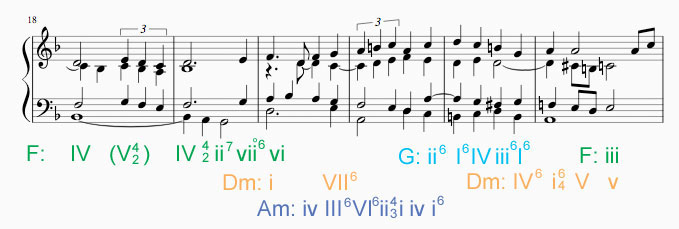
Needless to say, in my arrangement, the voices interact in a more balanced way, and there are no more awkward 2-against-3 rhythms and no voiceleading errors. Whenever a triplet appears, the other voices simply follow suit or continue obliquely. The C natural in the melody in bar 23 is prepared by a shift in the alto away from A Major to A Minor — this is a bit gloomy for a Gloria, I admit, but it's passable as an imitation of the tenor moving from F-Sharp to F-natural a few beats prior.
Here are the two passages together for side-by-side comparison.
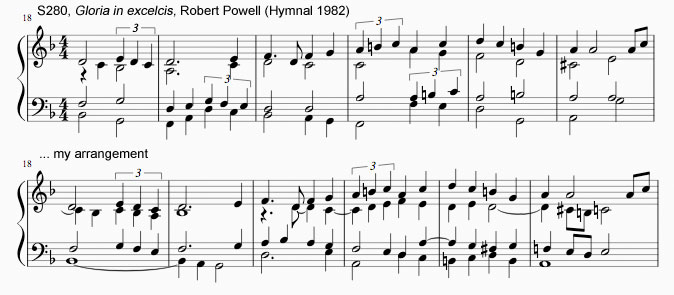
While I wouldn't claim that my version is completely fail-safe, it at least improves the chances for the congregation to sing the B-natural correctly.
A similar exegesis could be done for the entire piece, but it would take a long time. By now you know how this works: There are problems in the original, I find them and fix them, and the result is music that makes more sense and is more satisfying to play.
The complete arrangement is below, with a link to the .pdf file for you to download, print, and use in your services if you like. I beg your pardon for my playing on this recording. You'll notice a slip in the tenor line near the end.
Thanks for your attention. If you enjoyed this post, you may want to browse previous entries on this topic using the search field at the top of the page.
Regards,
Aaron
Rewriting Bach: Italian Concerto BWV 971, Presto m.112-121
March 03, 2017
Lately I've been writing some new music, and as part of that work, I've been taking a careful look at some pieces by Bach that I've never studied in depth. Over the last couple of days I've been analysing the Presto (third movement) from the Italian Concerto BWV 971.
Basics of Analysis
Four basic questions I try to answer are:
- How many ideas are there in this piece?
- How are the ideas organised?
- What is the harmonic scheme?
- How does the harmonic scheme relate to the organisation of the ideas?
Once these questions have been answered satisfactorily, I should have a pretty good grasp of what Bach did.
These questions help when trying to figure out how the ideas are organised.
- After all the ideas have been stated, in what order do they reappear?
- Are the ideas varied when they reappear? If so, how?
I Wouldn't Change a Note!
Here is Glenn Gould playing the music which we'll be looking at. [N.b. This video was available as of April 11, 2020. If the link breaks, please notify me so I can fix it.]
When a piece of music sounds perfect the way it is, one is inclined to make remarks like "Not a single note should be changed!" But that doesn't teach anyone anything. The way to learn whether such a statement is true is to change some notes and see if it makes any difference.
I'm always on the lookout for places in a piece of music that could have been different. I like to look at these passages and try out alternatives to determine why what's there is there. One can learn a lot by doing this. In Bach's music, I've found consistently that the different possible versions are never as good as the version that's there. In other words, as far as I can tell, he always chose the best possibility. In Bach's Italian Concerto there is an intriguing passage at bars 112 and following that could have been different, but shouldn't be, and you'll see what I mean by taking a look at a possible alternative Bach didn't choose. Here it is the way he wrote it.
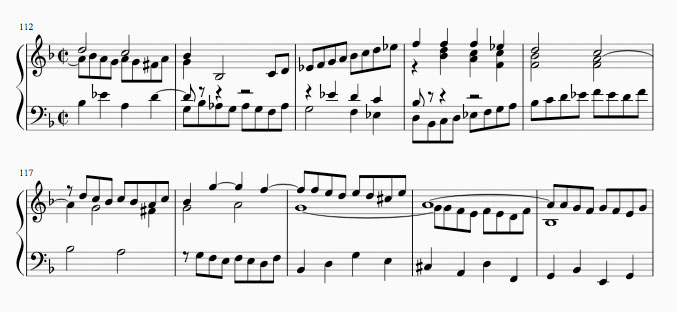
So we ask question 1: How many ideas are there here? The answer is two. A 1-bar motive (M) is being developed through imitation and sequence through most of the passage. Four bars from the main theme of the work (T1) appears in the second measure. For context, this passage comes basically in the middle of the entire work, after 8 bars of development of M (in its second appearance so far). It's the appearance of the theme here that interests me.

On to question 2: what is the harmonic plan? I also chose to look at this passage because it's the most harmonically ambiguous place in the entire work (again note that it appears almost exactly in the middle of the piece). My harmonic analysis is below.
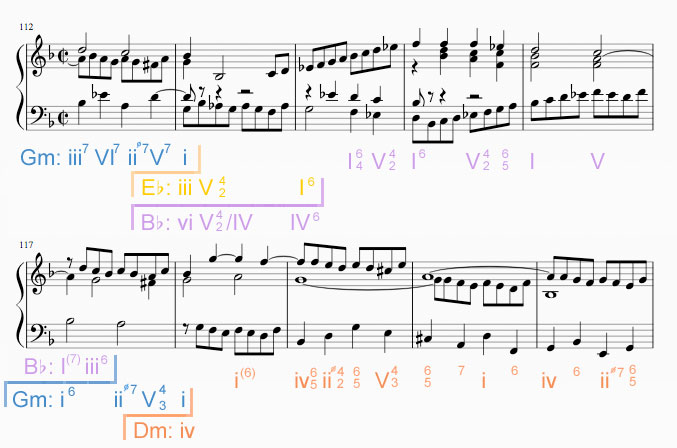
In summary, we begin with a cadence in G Minor based on the motive (M), and then the Theme (T1) appears in B-Flat Major, followed directly by another cadence in G Minor, and then a sequence leading to a cadence in D Minor. The image below shows these key areas in a simplified way.
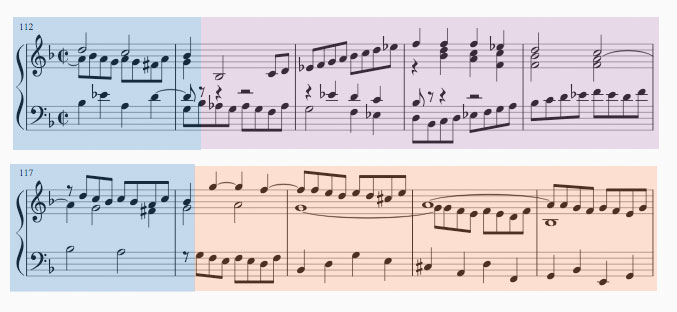
Places to Cut? or Insert
Take a close look at the two cadences in G Minor, and you'll notice they are very similar. In fact, the voiceleading is identical, and they both end up in exactly the same place.
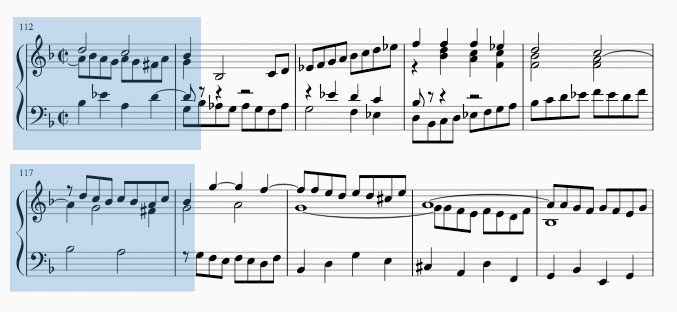
Places like this are especially interesting for composers to study, because we can clearly see that Bach had an option to leave out some music here, but decided to put it in. So we see here a point in the music where we could, if we wanted to, make a "cut". Orchestral conductors do this sometimes, when they want to shorten a piece. They tell the orchestra to play up to point A, then skip over to point B and continue. This will only work when a conductor knows how to find places in the music that are similar enough that the music can continue smoothly and seem plausible, like this spot.
Look at this the other way around. As a composer, the similar cadences represent a place that music has been inserted, probably as an improvement of a first draft. Bach could have left out the appearance of the theme, and maybe he did at first. So let's see what we would have if Bach had never inserted the theme there. To recreate a fictional first draft, we simply remove the theme, and replace the second cadence with the first.

What is the result? Not surprisingly, it sounds perfectly fine, because the two cadences are so similar. The order in which the voices imitate one another (alto, bass, soprano) makes perfect sense. The impact of removing the theme here relates not only to the drama of this individual passage, but also to the larger form. It's quite possible that what we see above is what Bach wrote in his first draft, and he then added the appearance of the theme in B-Flat during a second draft, in order to make the passage more interesting and to improve the overall form. The similarity of the two cadences, the logic of the imitation in the abridged passage above, and most importantly the unexpectedness of the key of B-Flat Major all lead me to suggest this idea as a real possibility.
In an Alternate Universe …
Now let's consider another, less likely possibility. Let's say we're Bach, and the first draft is above, with no statement of the theme. Let's pretend we've decided that the piece will be better if the theme appears here, and we're going to insert it after the G Minor cadence. The question we must answer is: in what key it should appear? The fact that Bach answered this question with "B-Flat Major" is what interests us, and we can find out why he chose that key by choosing a different key for our alternative-universe second draft, and comparing the result.
We have a cadence in G Minor. So why not state the theme in G-Minor? Sounds logical enough. Stating the theme in G Minor will certainly work here. The theme begins with a descending octave leap, and we have a G on the downbeat of 113 to work with. Good. Note that we don't need to write a second cadence in G Minor since the theme does that for us. Sounds auspicious. Let's try it, and see what happens. To change the theme from B-Flat Major to G Minor, we can simply transpose what Bach wrote down a third and change some accidentals (and if that seems like an indication to you that something might be wrong with this idea, you get bonus points). Here is what we get.
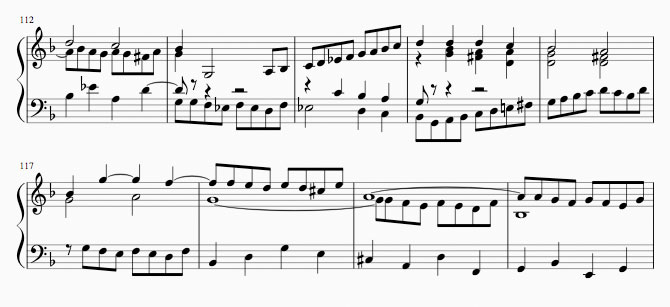
Hm, it works, but it isn't altogether convincing. Why? Let's fix some obvious things first. When we look at other statements of the main theme in this work in Minor key areas, we see that Bach always used the ascending form of Minor, with the raised 6th and 7th, so we should also do that here, because otherwise it sounds weak and wrong. The repeated G in the left hand at the entrance of T1 is clumsy; we can leave out the downbeat. If you would have already fixed these things during your transposition step, you also earned bonus points. Let's circle the problem spots.

So here it is with these couple of problems fixed (marked in blue).

It still sounds a bit unrewarding. Is this just because we expect Bach's version and ours is different? Doesn't a statement in G Minor make sense here? What's the problem? The key areas are more straightforward than Bach's version. We have only G Minor and D Minor.

If you thought that transposing down a third a few bars of what Bach actually wrote isn't likely to sound quite right in context, you were correct. We see that the result is unfortunately a bit dull. The reason is because we end up repeating the same notes at the at the same pitch level. We begin with a cadence that has a D half note in it, and then we ascend a scale again to the same D and repeat that D. D for Dull. In our version, the appearance of the theme doesn't bring much new to light. It lacks excitement. It may even bring Disappointment.
Bach Wins
At this point you should be shouting "Please bring Back Bach's original!" and you would be right. But let's list a few reasons why his version is so much better in comparison to what we did. Here is what Bach's statement in B-Flat does that our statement in G Minor doesn't do. It's quite simple.
- The harmonic change is unexpected and exciting
- The theme rises up to repeated notes in a higher, brighter register
- The flanking cadences in G Minor allow the theme to rise up triumphantly and then recede back from whence it came
We could note other things that make Bach's version better, like the pitch change from A to A-flat, then back to A, the change from Minor to Major, the ambiguity of G Minor to E-Flat Major to B-Flat Major. All those things are good observations.
So let's return to is Bach's original with a new appreciation for what he did in this passage, and possibly even how he did it, imagining that he inserted it in a second draft and covered his tracks by writing a second cadence in G Minor after the statement of the theme.

I hope this example might help someone else who is considering making changes to a draft of a piece. Seeing what Bach did here should encourage all composers to consider options wisely and make the most of opportunities. What seems like a logical choice is definitely not always the best choice, and often an inferior choice results from asking the wrong question — a question that is too simple-minded. Diversity of harmony, which notes we hear in what register — these are extremely important things that need to be considered when answering a question like "in which key should the theme appear here?" and thinking about all those things together should lead one to more musical conclusions.
Why not spend the next 15 minutes of your life listening to all three movements? Here is a performance of the work by Alexander Gavrylyuk. [Please notify me if this link breaks]
Thanks for tuning in, and I hope to see you next time.
Regards,
Aaron
2017 Underway
February 27, 2017
For anyone interested, here are some things I’ve been up to so far in 2017:
- revised and finalised the specification for a new product which will replace TBX1 for H-Pi Instruments
- celebrated new years eve at a concert of Bach’s B-Minor Mass in Xanten
- left facebook (no personal use, my account remains only for business activities)
- spent a wonderful two weeks at the Bach festival in Bruge, Belgium
- began writing my first Cantata
- started tinkering with Dorico and MuseScore notation software
- started studying Bach’s Chorales again
- visited friends in Hamburg and Berlin, attended concerts at the Elbphilharmonie and Jakobskirche
I'll come back to say more about some of these things. Thanks for your patience.
Until then,
Aaron
Fughetta a5 on Engelberg
December 27, 2016
In my last post, I talked about dealing with some things that bothered me in the hymn tune called Engelberg, by Charles Villiers Stanford (1852-1924). The aim of my arrangement was to correct the problems (as I saw them) while essentially maintaining Stanford's vision.
A couple of weeks after writing that arrangement, I decided it would be worthwhile to also write an introduction. As I mentioned before, five voices is an unusual number for a hymn setting (the normal number is four: SATB). So I chose to highlight this aspect of the hymn with a Fughetta in five voices. The manuscript is below.
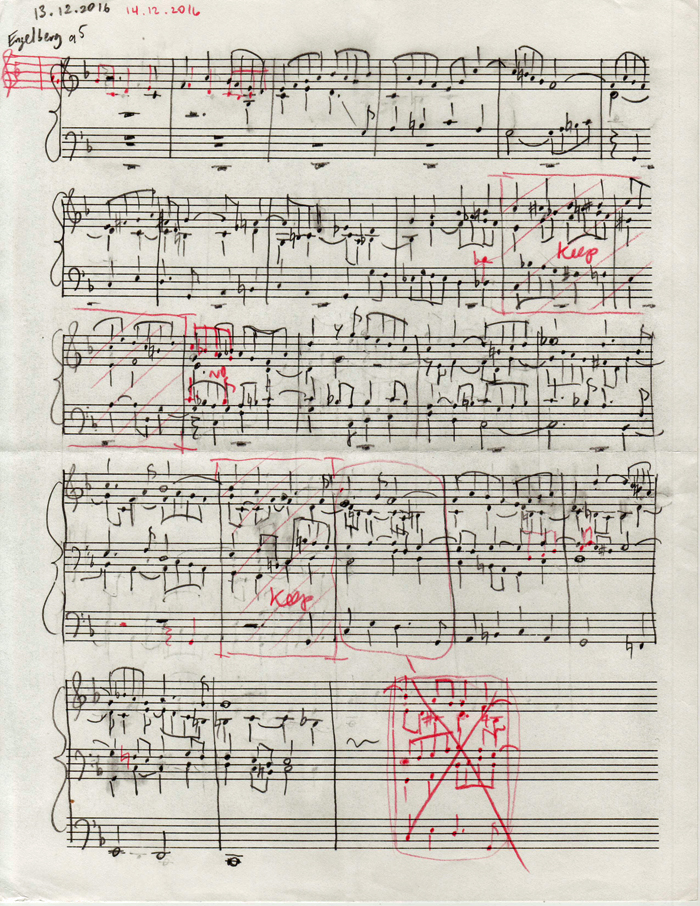
The day after writing it, I was concerned by its length, and tried making it a little shorter. That is the writing you see in red pencil, (notice the two dates at the top). After trying out both versions, the original and the red pencil changes, I basically threw out my second thoughts and went with the original.
A few days later, I transcribed the manuscript into the computer, and made some small changes in the process. Most notably, the first voice enters with the full subject, which I had initially shortened. The final result is below. I didn't get a chance to record myself playing this. Instead, I made a recording with the Jeux d'orgues soundfont Hauptwerk and MIDI Tapper. I hope you like it.
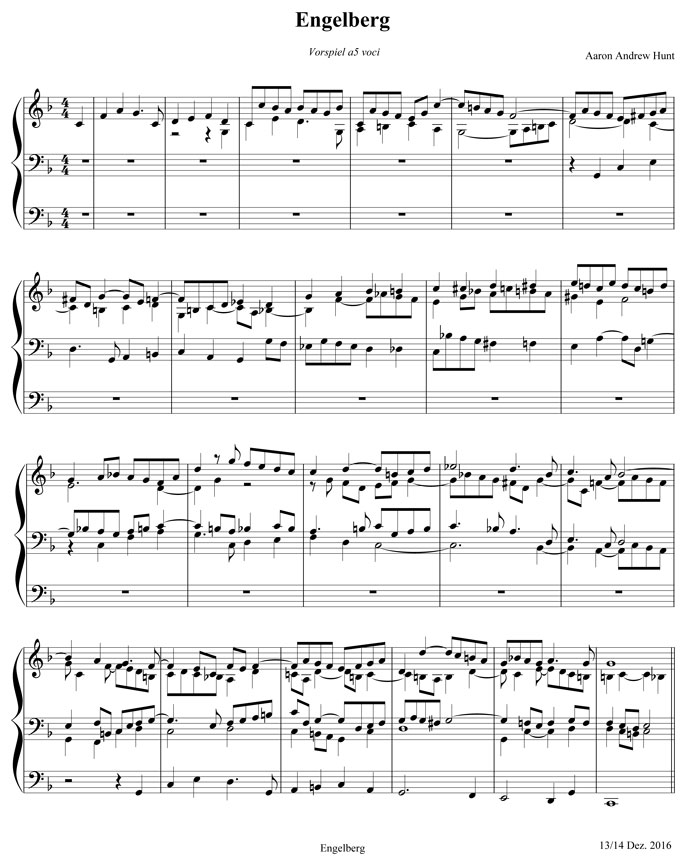
The recording includes two verses and the Amen ending, shown below.

I admit what I wrote is a little bit long for a hymn introduction. It's just one idea, one approach. A shorter Fughetta using only the first half of the melody would probably be more effective. Maybe that's something to try later. Or maybe you should try it? Or a completely different approach? To continue learning means taking chances. Try something out and see what happens.
Best Regards,
Aaron
Rewriting Annoying Music - Engelberg by Charles Villiers Stanford
December 04, 2016
Charles Villiers Stanford (1852-1924) was born in Ireland, but lived most of his life in England. He was educated at Queen's College Cambridge and the Royal College of Music, and later was professor of music at the University of Cambridge. Stanford was a gifted composer, and prolific. If you don't know his instrumental music, give it a listen. But he's best known for his contributions to the Church of England. Of his many anthems and hymns, Engelberg is one of the most beloved.
I've always liked this tune. So what annoys me about it? Well, it's not the tune. It's the organ accompaniment as written in The Hymnal 1982. Let's take a look and I'll explain why it bothers me.
Engelberg

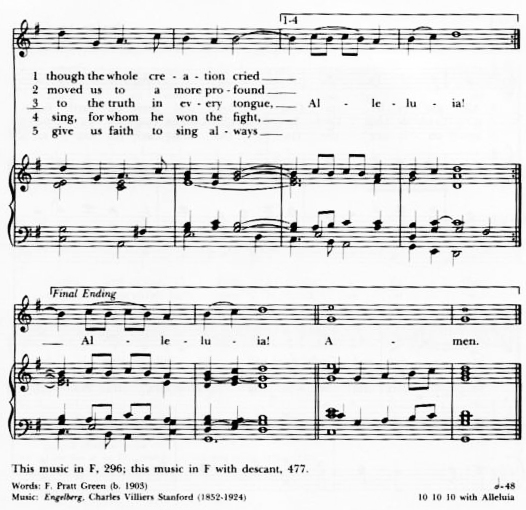
The structure of the hymn is 10 10 10 with Alleluia. It works with several other texts, but is best known by the one shown here, When in Our Music God is Glorified, by Fred Pratt Green.
Most hymns are written in four parts, SATB harmony. Not this hymn. SATB hymns, when written well, always sound solid and consistent. As an organist and a composer, I want to see and hear and feel that kind of solidity and consistency in the music I'm playing, and if there is a change in the texture, I want to see and hear a good reason for it. Did you notice that the number of voices is not consistent? Look at how widely the texture fluctuates. This is the first thing that bothers me about this music.
Texture




So what do we have here? We start with 6 voices, then move to 5. Then we alternate between 5 and 4 … can't figure out what we want … and then we have the same indecisiveness between 5 and 6 voices. Finally, at the big finish, we have a whopping 7 voices. Are there good reasons to change the texture so often? I think not. Remember, octave doublings are basically not necessary in organ music; that's what registration is for. With proper registration, fewer voices is actually better.
This is not the only thing that's troublesome about this music. Can you guess what the next issue is? There are problems. Look closely.
Voice Leading

That's right. The dreaded parallel octave. The second system is okay.

The third and fourth systems are the most offensive.


The octave doublings are obviously done to try to deliver more powerful music, but on the organ that is not necessary.
My Arrangement
Because I really do like this music, I decided to fix what's wrong with it and write a version for myself that I could enjoy playing.
A Hymn should really not need to have more than four parts, but let's be open to the idea of a hymn harmonized for more than 4 voices. After all, 5 voice counterpoint can sound great when it's done right. Based on Stanford's original, I decided that the number of voices needed to basically maintain his intention is 5. I didn't substantially change any harmony, only improved the voiceleading, added a few suspensions and strengthened a few places with neighbor tones. The outer voices remain identical to Stanford's original. Here is my arrangement.

Here is a recording of myself playing through this one time, slowly (without the Amen ending).
If you enjoyed this entry, you may be interested in reading past episodes of Rewriting Annoying Music.
Best Regards,
Aaron
P.S. I didn't point out one of the parallel octaves Stanford wrote, and I left in my arrangement. Can you find it? (Hint: it appears twice)
PayPal Checkout with Euros, VAT, and Currency Exchange
November 02, 2016

This blog entry is for web programmers looking for help with PayPal checkout processing involving Euros and VAT. I write in PHP, and limit library use to Bootstrap and jQuery. Since it took me quite a bit of time to find the right information and figure out what to do with it, I hope I might save someone else that kind of time with what I write below. The first section is there to help you determine if my explanation is for you or not. If you're in a hurry to find solutions, skip to this list.
Why I Switched to the Euro
For the past decade, I've used PayPal for my business websites' online transactions. PayPal works by linking to a bank account, and in the US there are no fees either for the PayPal account or for the bank account. Last year I implemented PayPal's IPN service to automate order processing — also a free service. As an American working in the US, my business currency was of course the US Dollar. US Tax policy regarding online transactions is simple. Residents of a state in which a web-based business resides must pay local state sales tax on each transaction. Handling all of that through PayPal was not difficult.

Then I moved to Germany. PayPal is in fact based in Europe, and it offers accounts to EU countries in Euros. German PayPal accounts work the same way as American accounts, and PayPal remains a free service for European customers, although German bank accounts are typically not free. After fulfilling the requirements for residency in Germany (a process taking several months) and finally opening a German bank account, I opened a new (German) PayPal account and prepared to point my websites to send transactions to that account.
But, not so fast. Simply pointing the transactions to the new accounts would not result in collection of the correct currency, because my prices were in USD, and the new account is in EUR. The conversion rate from USD to EUR fluctuates, but generally has not been favourable to the USD, and PayPal also charges a fee for the currency conversion. The result would be that I would collect far less money for each transaction. Nor would simply pointing the transactions to this new account be legally responsible. When selling as US business, I'm beholden to US tax policies. When selling as a German business, I'm beholden to the tax policies of Germany and the EU.
In order to do this right, I had some work to do. First, I needed to change my prices to Euros, so that I could send the currency to PayPal. Second, I had to implement correct tax policies as an EU business. The latter is extremely complicated, because online sales in the EU require that tax be collected in the rate of the customer's country, not the rate of the seller's country. This means tracking website visitors' location, and looking up correct tax rates for each transaction. To accomplish this requires gathering data from a few Euro-related online services. Luckily these services are free.
TO DO List
- Change prices to Euros
- Track VAT rates for all EU countries ( apilayer.net )
- Get website visitors' country codes ( wipmania.com )
- Track exchange rates as a courtesy to non-EU customers ( www.ecb.europa.eu )
Changing Prices to Euros
Generally, if a product costs 10 USD when marketed in the US, it will also cost 10 EUR when marketed in the EU. I decided this made sense. Something I learned through this process is that the Euro symbol is, as a rule, supposed to go after the number, not before it. Many websites get this wrong. While the decimal point and the comma also swap roles in European practice, this is not such a strict rule, and I decided not to adopt it since it confuses a lot of people.
Tracking VAT rates

VAT rates are very complicated, because they not only vary per country, but also vary per category of goods or services per country. Luckily, complete and very clear information on all the VAT rates is available from the European Commission. I suggest reading their documents before trying to implement VAT in your website. (N.B. It also looks like all the rules for handling VAT will be changing in 2017) For getting the VAT rates, I use apilayer.net, which offers free accounts for up to 100 calls per month. Since these rates do not change very often, it's not necessary to track them more than once a month (keeping the number of calls well below 100). Documentation is excellent. I wrote a PHP script which looks up these rates and stores them in a database table, then I set up a cron job on the server to call this script automatically once a month. This gives me the correct tax rates to work with via PHP mySQLi database lookup.
Getting a Website-Visitor's Country Code
For this I use wipmania, which is free for this purpose with no use limit (they have paid plans for business who are looking for more information). The location of the visitor is determined by IP address, which of course is not failsafe, but as far as I can determine, it's the best method available. It's only necessary to get this value on the shopping cart page, where VAT is calculated, so the number of calls is kept relatively low. If you need to do more with the code and are worried about making too many calls to wipmania, simply store the country code once in the PHP session cookie.
Getting Exchange Rates
Online pricing in Euros is by no means uncommon, but for some non-EU customers it is uncomfortable because of fluctuating exchange rates. I decided that it would be nice for non-EU customers to be able to see prices in their own currency. Luckily, the European Central Bank provides daily exchange rates in an xml file for free. Since it is not necessary to look this up more than once a day, again my solution was to write a PHP script to look up all the rates and store them in a database, and then set up a server cron job to run the script once a day. I then access the rates via PHP mySQLi database lookup. The Bootstrap library provides a nice popup window to display HTML in any link title attribute, so I added a PHP function to accept a price and calculate prices by conversion in an HTML formatted list to write into the title attribute of price links displayed in Euros. Keep in mind that PayPal adds between 3% and 4% to these rates; therefore, I add 3.5% to the rates before calculating the conversions, and add a note saying that the amounts are estimates only.
Calculating the Correct Tax
To sell products with the correct tax, you need to do the following, in order:
- Get the visitor's country code
- Look up the VAT rate for the visitor's country according to the type of good or service you are selling
- Calculate the tax, and show it to the user as part of your checkout process
PayPal Checkout with Euros and VAT
The last thing to do is to change your checkout currency to EUR, and send the VAT as the tax parameter. It is of course important to store all the transaction information in your local database. You can also get what you need from your PayPal IPN messages, since these will include the visitor's country code as well as the tax paid. If you like, you can also send custom fields to PayPal in each transaction. Doing so may allow you to detect possible problems caused by proxy servers.
Thanks for reading and I hope something here was helpful for you.
Best Wishes,
Aaron
Why I avoid CMS packages
November 01, 2016

Although I've built websites using CMS's like Shopify and SquareSpace, when it comes to web design, I prefer not to be locked into a third-party service. The reason is fairly obvious. Even when they are free, all CMS's require doing things their way, which means you will end up spending your time dealing with their system. To me, that's no fun, and it's also not very creative, because learning their system doesn't do much to help me become a better programmer. Doing things on my own is much more interesting and challenging, and the solutions are more broadly instructive and useful for my future work.
Of course, solutions don't come from nowhere, and my modus operandi is not unique. I use some standard libraries like Bootstrap and jQuery, and I consult PHP reference fairly often. For any given problem, before reinventing the wheel, I search to see what other people have shared online. Often I'll download something someone has put together, look it over, decide it's too elaborate for my needs, and then I make my own. w3schools is possibly the most convenient resource for Javascript, HTML, SQL, and CSS reference, and for tricky problems I find a lot of helpful advice on stack overflow.
Next time I'll show how I dealt with Euro VAT and currency conversion rates using PHP, SQL, Javascript, and a couple of simple server instructions.
Regards,
Aaron
368 Regent Square
October 16, 2016
I haven't played the organ since the middle of July, and I'm feeling the ill effects. I miss playing and composing music at the organ. While I'd like to share something new, instead I'll look back to the last service I played at Grace Episcopal in Muncie, IN, with an arrangement of a hymn written by Henry T. Smart in 1867: Regent Square. This hymn is often associated with the opening line Angels from the realms of Glory, but in this case the text is Holy Father, great Creator by Alexander V. Griswold. The hymn is number 368 in the Episcopal Hymnal, 1982.
About Hymn Introductions
A hymn introduction should prepare the congregation to sing, not only by introducing the melody, but also by creating a proper feeling for worship. The organist has quite a lot of freedom in this respect. The melody needs to be clear, but it doesn't need to be played all the way through, and it also doesn't need to be played verbatim. Motives from the melody can be used for imitation, sequences, and so on. As long as the thread of the tune isn't lost, the form can be relatively free.
My introduction to Regent Square
My setting of Regent Square is an example of an introduction which doesn't include the entire melody. Instead, I begin with a sequence derived from the first half of the first phrase (an angular arpeggiated figure) followed by a shortened version of the final phrase in augmented durations. The middle of the tune is omitted. While the whole tune isn't stated, the length of the introduction has the same number of measures as the tune.
Transition and Concluding Stanza
I conclude with a reharmonization of the final stanza, preceded by a brief transition that modulates through a sequence of third relations. The hymn includes a final descant, which the more adventurous sopranos usually sing. When an organist reharmonizes the final stanza of a hymn in an Episcopal service, people normally catch on and refrain from singing things that don't fit, but not always. In this case, in order to avoid potential disaster, I decided to reharmonize the tune in such a way that the written descant would still work; thus, the music is not as interesting as I would have liked it to be, but it is safer to use.
Here is the hymn played through with introduction, three stanzas as written, transition, and final reharmonization.
N.B. I recorded this shortly after writing it in July at Grace Episcopal, Muncie Indiana. I play a few things differently than written. There are also a few notation errors: in bar 4, the F in both parts should be F#, and an F# is also missing in bar 8 in the Tenor.

Holy Father, great Creator,
Source of mercy, love and peace,
Look upon the Mediator,
Clothe us with His righteousness;
Heav’nly Father, heav’nly Father,
Through the Savior hear and bless!
Holy Jesus, Lord of glory,
Whom angelic hosts proclaim,
While we hear Thy wondrous story,
Meet and worship in Thy Name,
Dear Redeemer, dear Redeemer,
In our hearts Thy peace proclaim.
Holy Spirit, Sanctifier,
Come with unction from above,
Raise our hearts to raptures higher,
Fill them with the Savior’s love.
Source of comfort, source of comfort,
Cheer us with the Savior’s love.

God the Lord, through every nation
Let Thy wondrous mercies shine,
In the song of Thy salvation
Every tongue and race combine,
Great Jehovah, great Jehovah,
Form our hearts and make them Thine.
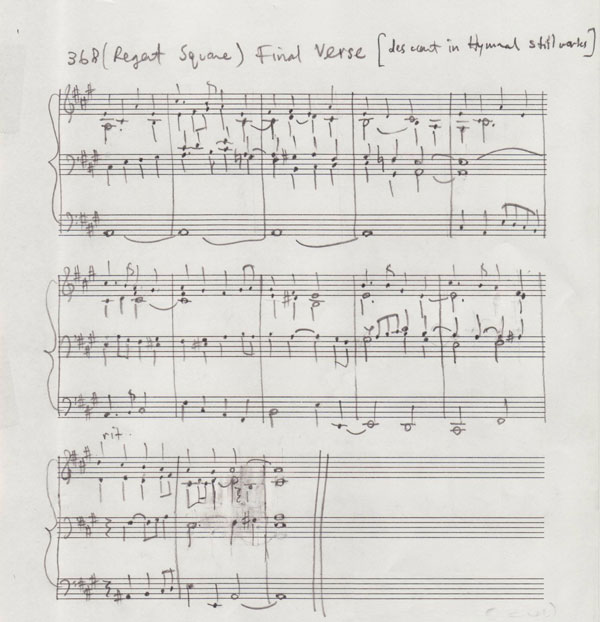
Regards,
Aaron
Voice-leading Anomalies in J.S. Bach's Mass in B Minor, BWV 232
September 14, 2016
I have owned the score of Bach's B-Minor Mass (BWV 232) since I was 18, and have studied it from time to time along with recordings, sometimes also during live performances. For decades it has remained for me one of the most inspiring of Bach's works. Two days ago, I had the opportunity to attend a performance of the masterpiece by Collegium Vocale Gent, conducted by Philippe Herreweghe, at the Jahrhunderthalle in Bochum, Germany (my new home since July 21, 2016). Unfortunately, I missed this opportunity, because I missed the bus which I had planned to take to the concert.
I was faced with a choice: sulk all evening, or open the rehearsal score of this work and read through it with a fine-toothed comb at the piano. I chose the latter. In so doing, I noticed several interesting things in this marvelous music that somehow had escaped my attention for decades.
Music students are often taught that Bach never wrote parallel octaves or parallel fifths, but that isn't exactly true. If you look carefully at Bach's music for large ensembles, you can find these voice-leading anomalies. They are few and far between, but they do exist.
All music students are taught to avoid writing parallel 5ths and parallel octaves. The reason is that voices moving together harmonically by these intervals tend to fuse into one sound (as in organ registration), and unless the voices are moving consistently together in parallel as a technique of orchestration, the occasional parallel octave or fifth between two parts will leap out of the texture and sound like a mistake.
It is true that you won't find those kinds of errors in Bach's chorales (through there are rare instances similar to those I'll show you here), but the fact is that Bach did occasionally write parallel octaves and parallel fifths in his music scored for large groups. I'm not talking about octave doublings in terms of orchestration. I am actually talking about voice-leading instances where independent parts all of a sudden move from only one note to the next in forbidden parallel motion. Bach did write such parallel octaves and parallel fifths occasionally. And guess what — they do not sound wrong. On the contrary, they sound just fine. Why? Because he knew what he was doing. In almost every case, I wouldn't characterize the parallel 5ths or octaves that Bach wrote as "mistakes"; hence I have titled this post "Voiceleading Anomalies" rather than "Voiceleading Errors". This is a huge topic, for sure, and probably someone has written a book about it already, but I have never seen it. So let's take a look at these examples, from the Mass in B-Minor BWV 232, one of Bach's most famous compositions.
Christe eleison
The first anomaly appears in the Christe, a duet for two sopranos with violin and continuo. From the last beat of bar 15 to the downbeat of bar 16, there is a parallel octave between the violin and the continuo.

Bach could have avoided the parallel octave by changing the A to a C# in the violin, but he didn't. Why? Apparently he wanted it that way. In any case, there is a simple reason this doesn't sound wrong, and that it needn't be considered a mistake. The reason is this: the eighth notes in the continuo (the bass line) are to be played non-legato, or detached. Anyone interested in early music knows this; it is part of the style. The result in this case is that the space between the written notes provides room for the violin to move against an unwritten rest in the bass. In other words, what looks like a parallel octave on the page is not actually played that way. What we hear instead is the B in the violin against the A in the bass, and then the B again with the bass – in effect oblique motion.
Laudamus te
Another parallel octave occurs at bar 56 of the Laudamus te (from the Gloria), an aria for Soprano with continuo, a trio of strings, and violin solo.
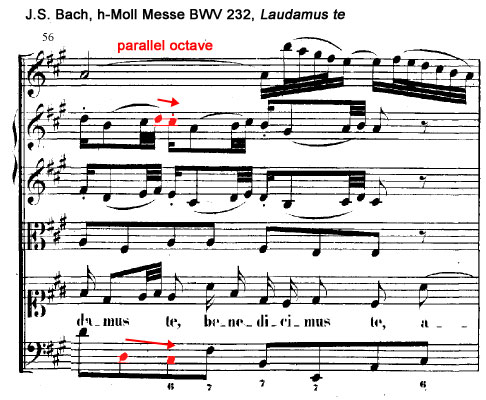
This instance may be a bit harder to see, and is also shorter in duration than the previous example. This is usually the kind of parallel octave or 5th that appears in Bach's writing. The parallel is a result of an ornamental note, an upper neighbor, in a figure that appears as a motive in the piece. The actual voice-leading between these two voices is tricky. On the downbeat, the upper part has a D, and so does the continuo, so that overall there really is structural voice-leading of parallel octaves here. On the other hand, the upper part (violin) leaps away from the D down to a B and moves up from B to C#, against the continuo (bass) which is moving down from D to C#, so structurally there is also contrary motion. Again, there is space between the D and C# in the bass, so that the upper part is actually moving against a rest. In some ways there is more of a parallel octave here than in the previous example, but again it doesn't sound wrong, because it's hidden, obscured — all but non-existent, so that nothing leaps out of the texture.
et resurrexit
The et resurrexit, (from the Credo) is scored for 5 voices with continuo, strings, woodwinds, and brass. Here we find the first example of a parallel fifth, between bars 53 and 54.

The upper voice in play here against the continuo is the second oboe. In this case the parallel is also an instance of a motivic lower neighbor tone, moving against an unwritten rest in the bass. By now you understand how this works.
pleni sunt coeli
The pleni sunt coeli, from the Sanctus, is scored for 6 voices with continuo, brass and timpani, 3 oboes and strings. A parallel fifth appears at bar 116 between the second violin and the continuo.
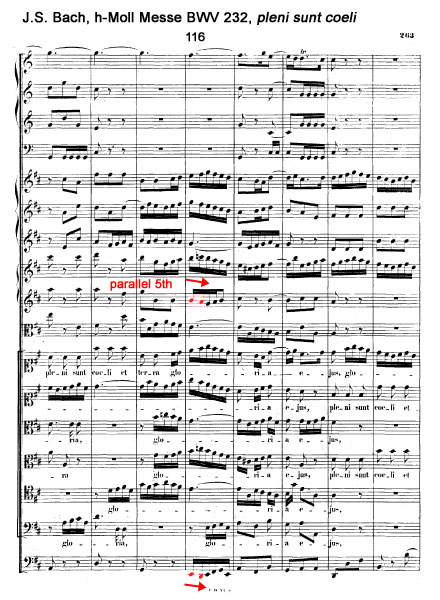
This example is more problematic, and one might be tempted to call it an error, because both the violin and the continuo are moving in 16th notes. In this case, the effect of the parallel is minimized since it occurs in an inner part. The outer (soprano) voices are moving in contrary motion at that point, and several voices hold a long note in oblique motion to the bass. Attention is drawn to these other parts, and the parallel basically vanishes within an active texture.
A second parallel fifth occurs later in the same movement in bar 134, this time including the soprano.
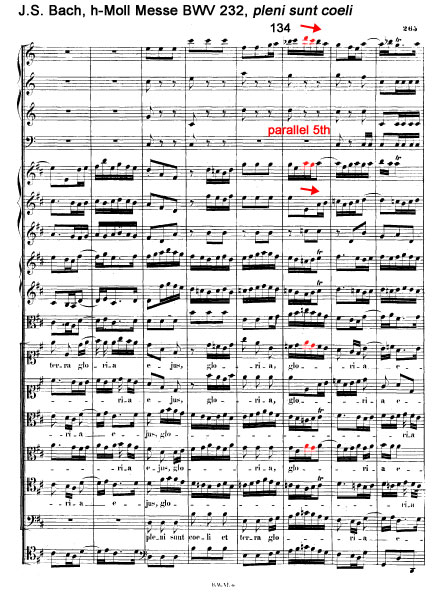
If we look at what is happening in the bass instruments here, we find that the upper parts complete two first-inversion triads: Am/C and G/B. The image below makes this clearer.
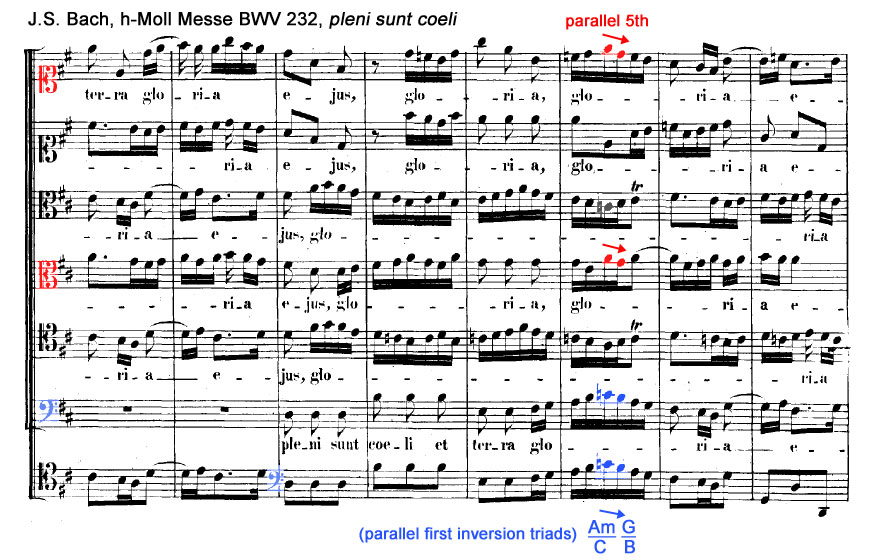
Parallel first-inversion triads sound good, regardless of what voicing is used. To avoid parallel fifths, the voices are supposed to be written up from the bottom in the order: 3rd, 5th, root, so that the upper interval is a fourth instead of a fifth. Here we see that Bach did it the other way, in the order up from the bottom: 3rd, root, 5th. And it sounds fine. In my own music from time to time I've also done this. In fact, this one special use-case of parallel fifths should probably be exonerated from the list of forbidden voice-leading, because it almost always sounds perfectly fine. But, not always. If you're a student, don't do it.
et resurrexit – a jazzy pre-dominant chord
The last example I found is not a parallel 5th or octave, but an instance (in et resurrexit) of a harmony that includes the 3rd and the 4th of a chord together. I've mentioned before that Bach does this quite often using suspensions. This is a more unusual case.
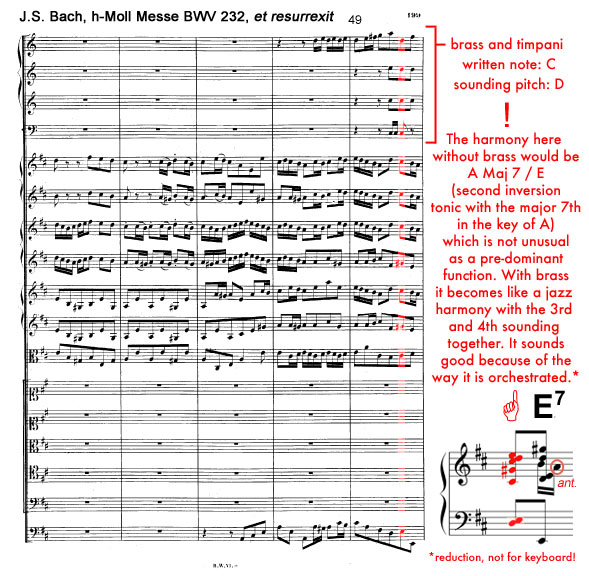
The harmony here without brass and timpani would be a second inversion tonic with the major 7th in the key of A, which is not unusual as a pre-dominant function (although the major 7th is spicier than normal). With the brass and timpani added, the 3rd and 4th of the harmony sound together. It's normal in a jazz style to voice chords with both the 3rd and 4th together, so this harmony becomes like a jazz chord. It sounds good because of the way Bach has orchestrated it. The D in the timpani (written C) is there for its weight more than its pitch. The D in the brass (also written C) is a repeated note which rings out very clearly on the valveless baroque trumpet in D. It may be an obvious point, but Bach did not write chords like this in his keyboard music. There are certainly examples of unusual dissonances to be found in the keyboard music, but as I hope you can see from these examples, Bach wrote for ensembles quite differently than he wrote for keyboard.
Conclusion
In a score that I thought I knew well already, I was delighted to find these things. In fact, as much as I love this music, I had never played through the entire work at the keyboard before. It's amazing the things one can discover in the space of a few hours just by looking into a piece of music. I highly recommend it as a way to spend an evening or two, or three. The piece has become new to me again. The main thing to take away from all this might be the same observation we started with, that Bach really knew what he was doing (big surprise).
Has this made you curious to find more anomalies in Bach's music? There are many other interesting passages in the passions and cantatas from which to learn.
Happy searching!
Aaron
Solace in Music
June 12, 2016
Playing music gives us a personal connection to an abstract spiritual world, where time changes, and becomes "all at once". The present, past, and future disappear into one unbroken experience. In the infinite present, music gives us a glimpse into our collective past, and a vision for our future.
The best music is courageous. It speaks to all of the human experience — our joy, our sorrow, and everything in between. It challenges our focus and skill, and gives us a great reward — a chance to momentarily find the perfection we seek, as we wrestle with our very flawed reality.
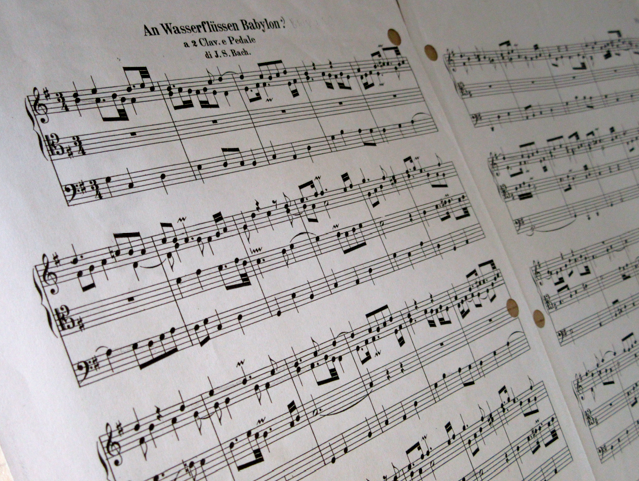
Peace,
Aaron
Benedictus es, Domine
June 05, 2016
You may recall that recently I took a look at the first six measures of John Rutter's Benedictus es, Domine and showed how I rewrote them. Today I've decided to go ahead and share my arrangement of the rest of the composition.
Liturgical Function
This music happens in the service after the opening Hymn and the Gloria, as an alternative to the Psalm, called a Canticle, in this case with text beginning (in Latin, though it is sung in English) Benedictus es, Domine. Many verses in scripture begin with these words Benedictus es, Domine, and I poked around but could not find out exactly from which verses this text is taken. It sounds like a Psalm to me, which would make the most sense, since that is how it's being used in the service. This is something I should know, so if you know the answer, please tell me via email.
The Original Music
The melody composed by John Rutter is easy to sing — one-octave range, middle C to the C above, and contains a memorable, kitschy modulation. The tune is repetitious, with a lot of long notes that try the patience a little, but it could be worse.
The piece also features a descant, which is written in an imitative (quasi-canonic) way, and this is the most attractive element of the composition, as well as the reason for the aforementioned long notes in the melody.
The organ accompaniment in the service book may be a transcription from an instrumental score, which would explain some of its non-idiomatic qualities. In any case, as I demonstrated previously, the accompaniment has problems which work against the better qualities of the music.
You can hear the original piece being played in a service, cued up in this YouTube video.
My Arrangement
The version I wrote for myself is basically in four parts, with a fifth and sixth voice added intentionally in places according to the harmony and form of the original.
NOTE: On this recording I'm playing more slowly than I would in a service. Also, in the recording I play the last three measures a bit more "jazzy" than written (A-flat instead of A, and then a Major 7th and Major 9th on the final chord), but I didn't do that at the actual service.
Technically speaking, this arrangement is not beyond reproach (there is still objectionable voiceleading here and there), but correcting every technical error in the published score was not my aim. My goal was to improve things enough that I could enjoy playing the music, and I'm satisfied with the result.
I'll continue next time by discussing some other problems in organ music, showing specific examples in music written by different composers.
Peace,
Aaron
Nicaea
May 31, 2016
The opening hymn in the Episcopal Church takes place as the leaders of worship carry the cross (followed by the choir) from the back of the sanctuary up to the alter. This gives the organist an opportunity to introduce the hymn in an especially ceremonial way. I prefer to write something imitative, often fugal. My setting of Nicaea — 362 Holy, Holy, Holy (Episcopal Hymnal 1982) for May 22nd included a short sequence and cadence after the statement of the first phrase of the tune.

I found the text and music for the hymn online at www.songsandhymns.org which you may want to read along with for stanzas 1-3.
1. Holy, holy, holy! Lord God Almighty!
Early in the morning our song shall rise to thee.
Holy, holy, holy! Merciful and mighty,
God in three Persons, blessed Trinity.
2. Holy, holy, holy! All saints adore thee,
casting down their golden crowns around the glassy sea;
cherubim and seraphim falling down before thee,
which wert, and art, and evermore shalt be.
3. Holy, holy, holy! Though the darkness hide thee,
though the sinful human eye thy glory may not see,
only thou art holy; there is none beside thee,
perfect in power, in love, and purity.
My setting of stanza 4 has a lot of running 8th notes in it. Finding a tempo that was comfortable for congregational singing was a bit tricky. Sometimes I add a tag on the end of the opening or closing hymn, to make things a little more grand, but I decided that would be overdoing it for this service, so you'll notice a few bars crossed out at the end.
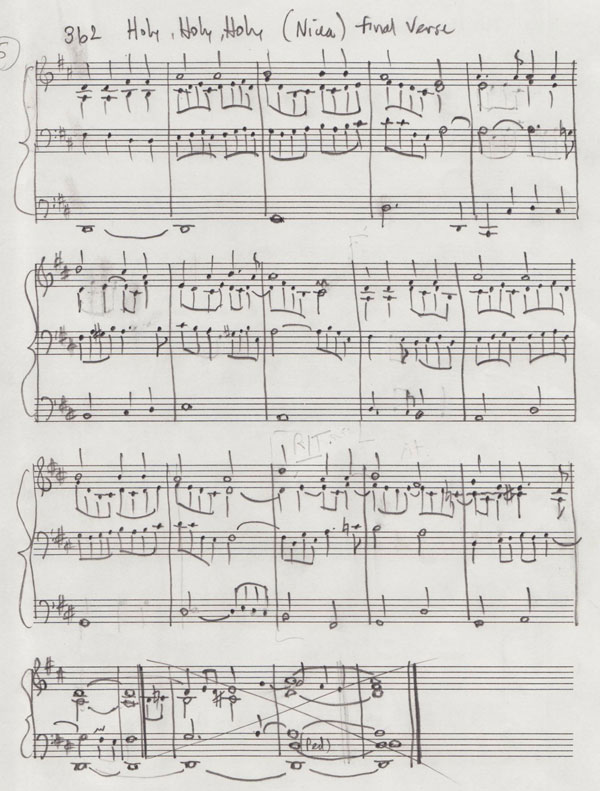
4. Holy, holy, holy! Lord God Almighty!
All thy works shall praise thy Name, in earth, and sky, and sea;
Holy, holy, holy! Merciful and mighty,
God in three Persons, blessed Trinity.
Peace,
Aaron
Nettleton
May 31, 2016
In the Episcopal Church, the reading of the Gospel text takes place in the center of the sanctuary. Procession to the center takes place during the last stanza of the Hymn which precedes the reading directly. Last Sunday this was Hymn 686 Nettleton — "Come Thou Fount of Every Blessing". I wrote a short introduction, and used the B-section of that in my final stanza harmonization. NOTE: This performance is not perfect; there are some finger slips. The recording quality is also pretty bad, but I can't do anything about that at the moment. Thanks for tolerating these issues.
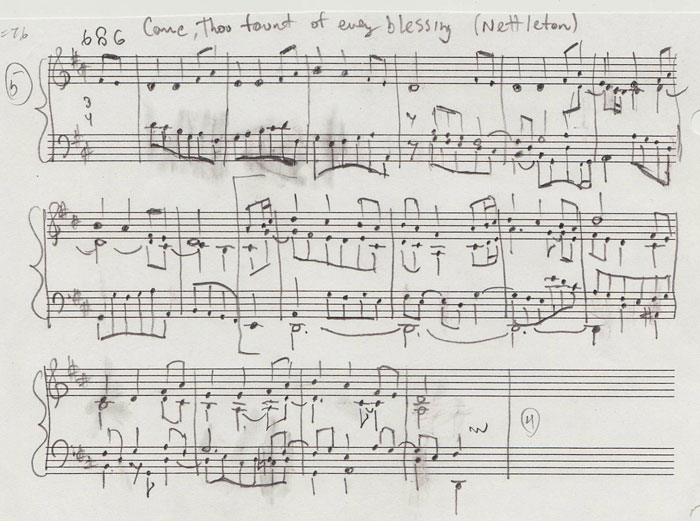
The quarter notes in the melody look a little funny because originally they were half notes. (The actual Hymn is written in 3/2, not 3/4).
1. Come, thou Fount of every blessing,
tune my heart to sing thy grace;
streams of mercy, never ceasing,
call for songs of loudest praise.
Teach me some melodious sonnet,
sung by flaming tongues above.
Praise the mount! I'm fixed upon it,
mount of thy redeeming love.
2. Here I find my greatest treasure;
hither by thy help I'm come;
and I hope, by thy good pleasure,
safely to arrive at home.
Jesus sought me when a stranger,
wandering from the fold of God;
he, to rescue me from danger,
interposed his precious blood.
3. Oh, to grace how great a debtor
daily I'm constrained to be!
Let thy goodness, like a fetter,
bind my wandering heart to thee;
prone to wander, Lord, I feel it,
prone to leave the God I love;
here's my heart, oh take and seal it,
seal it for thy courts above.
After the reading is finished, there is another solemn procession back to the alter. Often this takes place in silence, but on festival days, the organist should play something, er, festive. In some churches, this brief period is always taken as an opportunity for the organist to improvise some music (not just on the super-special days), and the music played is usually based on the hymn which was just sung prior to the reading. Last Sunday I did the latter, with a simple playful variation on the melody of the tune. What I actually played in the service was very close to this, though it went on a little longer because the priest was not yet in position to deliver the sermon. Improvisation in these situations can be a lot of fun.

Regards,
Aaron
Rewriting Annoying Music, PART 1
May 24, 2016
Welcome to the first installment in this (at least) week-long series. For details on why I'm doing this, please see the previous entry titled "Rewriting Music That Annoys Me". Today I'm discussing one of the major faults in organ music that I have to play sometimes, and how to fix what's wrong.
PROBLEM 1: OVERWRITING
What I mean by "overwriting" is this: It's overdone. The music is too busy, or there are too many octave doublings written in the harmony, or both. Usually notes have been written that just don't need to be there, either in a chord or in a moving inner part.
The organ is a powerful instrument. It doesn't need overwriting. With proper registration, playing 3 or 4 notes together is enough. Big chords with lots of doublings really aren't necessary on the organ, and in fact more notes sounding together usually will not sound as good as fewer notes sounding together on the organ. This is a fact that many people writing music for organ just don't seem to understand. Adding voices is reasonable in strategic places, like a final cadence. Even then restraint gives a clearer result. Many settings in the service book were written by folks who seem to have missed this memo.
S 236 Benedictus es, Domine by John Rutter.
Take for example the opening phrase of S 236 Benedictus es, Domine by John Rutter.

I did not record myself playing this passage for you, because it annoys me too much. You can however hear the entire thing being played in a service which I have cued up for you to the correct spot in this YouTube video.
There are a lot of things wrong with this passage, but let's start with the octave doublings. Here they are, marked in different colors so I can talk about them more easily.

Not all of these are bad. Those I have marked in green aren't so bad; they are just passing doublings with the melody, which happens in good writing. The others are poor choices, either wrong from a voiceleading standpoint, or not necessary.
Here I have marked the octave doublings in this passage that are problematic.

- m2-4: a tenor voice doubles the pedal (red)
- m4-5: doubled 5th between the alto and tenor (blue)
In each case, one of the doubled notes can be removed, and the music will either sound essentially the same, or better.
By the way, did you notice the parallel octaves in the outer voices? (I left it out of the images above to see if you'd notice).

Pretty bad …
There are also problems here from other categories I'm going to cover this week, for example:
- haphazard texture

It begins with five parts, then all of a sudden there are six, and then five again. There is no reason to do that.
- unnecessary difficulty
- readability issues

I've circled split parts that are written on single stems with one of the notes tied. Please don't do that. It just looks terrible. When voices move in different rhythms, they should be written as independent parts, using separate stems.
Look what is written there in the tenor where I've indicated crossing voices in m3-4. The lower tenor has been doubling the pedal for the last 2 bars. Then it's the upper tenor doubling the pedal. It's illogical voiceleading.
Now for the two double-arrows with question marks. The alto has been tied for three bars, and it's really necessary to rearticulate it in bar 4? The tenor D must be rearticulated in bar 5, just as it is doubled in the second alto (which is voice crossing) and the other tenor voice disappears? Come on.
My arrangement of Rutter's Benedictus es, Domine.
One of my goals in the way I rewrite music that annoys me is actually to make my changes transparent to anyone who's just singing along. Only organists and musicians listening should hear a real difference. With that in mind, here is my version of this opening passage, which fixes the noted problems.
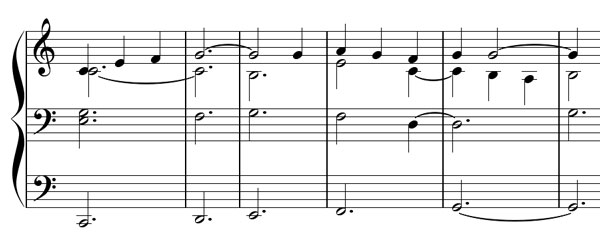
You'll probably notice a few things:
- the first bar is the same
- I did not fix the parallel octave.
- the harmony is very slightly altered
- after the first bar, the texture is four parts
Why have a split tenor in the first bar and nowhere else? First, because that's what was written, but more importantly, because omitting the fifth sounds too weak at the opening. The melody emerges from the sustained C which ties over to the alto in the second bar, which is not that objectionable. I could have just as well left out the C in the alto in the first bar, and put the alto on the G. I decided that wasn't significantly easier to read or play.
Why didn't I fix the parallel octave? A rule of thumb I use when making these arrangements is this: When fixing a problem makes the music harder to play, it probably isn't the right solution. In this case, I decided the parallel octave was not worth fixing because it would have required the pedal line to either move in quarter notes F-G-A in m4, or a half note F followed by a quarter note A, both of which in my opinion don't sound all that much better, and increase the difficulty of the passage beyond being worthwhile. Instead, I mitigate it by drawing attention to the inner parts with a clear preparation of the suspension in the alto, along with the anticipation of the D in the tenor, also tied over to the downbeat which emphasizes the alto. The alto then resolves by moving in quarter notes with a cliché figure, so that attention is drawn away from the parallel octave as much as possible.
The slight changes to the harmony are a result of improving everything else. The doublings are gone; four parts are all that is needed. The end result is that the music sounds essentially the same, except that it actually sounds a lot better, and it looks a lot better too. It's much easier to play.
How Not To Overwrite
In closing for today, let me leave you with a guideline for writing organ music. Here it is:
- write only what the harmony requires, and not more.
Believe it or not, Olivier Messiaen understood this, even though he wrote a lot of big chords for the organ. His harmonies use a lot of notes but not a lot of doublings. The notes he wrote need to be there to produce the harmony he was after, and not more than that.
Pianists often don't get this, because in piano music the tendency is to add doublings of octaves all over the place. That makes sense on a piano, because you can't get octaves any other way than playing them directly. It's close to nonsensical on the organ to work that way; that is what registration is for. To double an octave on the organ, the organist doesn't play another note on the keyboard, but instead pulls out the stop at the desired octave. A new set of pipes then sound along with those already sounding, so the octave doubling happens transparently. The written score doesn't include the octave doubling. That is a completely different way of thinking than pianists are used to. It's also a much simpler and more efficient way of making music.
Thanks for tuning in! This series continues this week with more examples from music that annoys me.
See you soon!
Aaron
New Series: Rewriting Music That Annoys Me
May 23, 2016
Today I'm kicking off a week-long series about rewriting music that annoys me. Why would I want to do that? Let me explain …
I normally leap at the opportunity to play as a substitute organist in the Episcopal church. Unlike so many other denominations who have all but given up the pipe organ and gone the way of the praise band, the Episcopal church still maintains its musical traditions, values the quality of its music, and employs professional musicians to deliver that music. Accordingly, I was very happy to serve again this past Sunday as organist at my local Episcopal Church (where I normally sing in the choir).
One of the many interesting things about the Episcopal church is that there is a such wide variety of music available for various parts of the liturgy. The Episcopal modus operandi is that each part of the mass is set by a different composer, so that different parts of the liturgy are put together in a sort of mish-mash of styles. It's up to the organist or choir director to select which parts to assemble together for a reasonable result. This is quite different from my experience in the Lutheran church, where various settings of the liturgy are through-composed by a single composer, so there is always continuity of style throughout the service. In any case, during the liturgy Episcopal congregations are almost always reading only a single line melody, and the organist normally accompanies that melody with music written in the service manual. Although improvisation and creative harmonization are part of the Episcopal tradition, normally the service music is played verbatim.
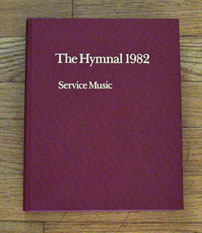
Variety is great, but it also means opinions and preferences will vary, which brings me to the point of this series I'm launching today. In short, I can't stand playing music that annoys me, and at this point in my life, I refuse to do it. The nice thing about being a composer is that I can rewrite music that I don't like, so that's what I do. Working with a melody written by someone else, which I also may not be crazy about, challenges my skills in a special way that I quite enjoy. The task is to improve what's there, not just so that it no longer bothers me, but so that I can put my heart into it enjoy playing it — so that I can truly make music with it. Some of the accompaniments written in the Episcopal service manual from 1982 are fine the way they are, but many of them I think are awful, and I refuse to play them as written. No offense to the composers, honestly.
For this particular service, all of the accompaniments I was slated to play annoyed me. Each day this week, I'll talk about the things I encounter in this music that I can't stand, and clarify each point. Then I'll share recordings and scores of my solutions to the problems I outline. The music in question is as follows:
THE SERVICE MUSIC
- S 280, Gloria in excelsis by Robert Powell
- S 236, Benedictus es, Domine by John Rutter
- S 125, Holy Holy Holy by Richard Proulx
Let me outline the basic problems as I see them, so you have an idea where I'm going with this.
THE PROBLEMS
- Overwriting
- Unnecessary difficulty
- Haphazard texture
- Poor or inconsistent harmony
- Readability Issues
I'll discuss these issues, and maybe also talk about quality and good taste in service music generally. The final posts will include recordings and scores of my arrangements — the result of my attempts to improve upon the work of others.
As a teaser, here's a simple chorale harmonization by J.S.Bach that can't be improved upon. Bach is the only composer I know of who always knew how not to do all the things I'm going to be complaining about.

So what about the music I rewrote? Is what I came up with really better than what I started with? Stay tuned to see and hear for yourself.
Until tomorrow,
Aaron
Passiontide Prelude and Fugue
March 19, 2016
Today I would like to share with you a piece which I wrote for Palm Sunday in 1995 – Prelude and Fugue on St. Theodulph, performed by organist Mark Bani of the Church of St. Vincent Ferrer, New York, NY. The tune is also known in German as the Chorale Valet will ich dir geben, but in English speaking countries it is primarily associated with All Glory Laud and Honor, a hymn which is sung only on Palm Sunday (the start of Holy Week in the Christian liturgical year).
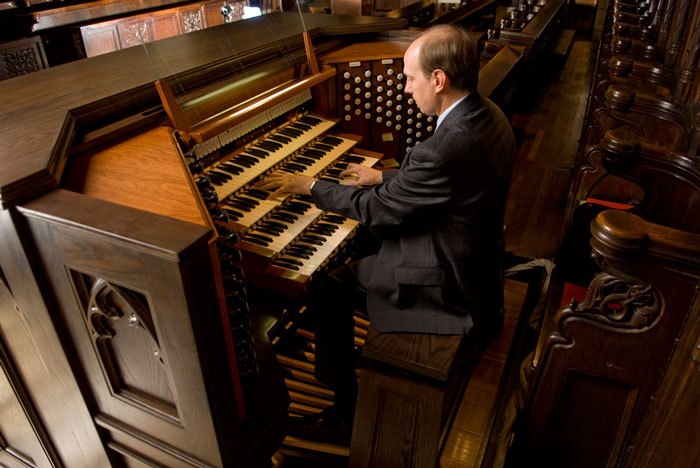
Pictured above: Mark Bani. [ Photo by Max Shuppert ]
This is a student work which has some flaws (and the performance in this recording also has some minor mistakes in it, and was transferred to digital from the master which was a cassette tape), but good memories return to me when I hear this music. The piece won the AGO-Holtkamp prize the year I wrote it, and it was premiered in New York City at the AGO National Convention in 1996, played by Mark Bani. Mark did a great job, and it was a pleasure to work with him. There is also an interesting story to be told about the performance that did not take place.
This piece was supposed to be played on a high-profile concert at Lincoln Center's Alice Tully Hall by the widely acclaimed organist Michael Farris, but was struck from the concert. Instead the work was played as a prelude to a recital of all choral music, which was scheduled as one among many other events. As I recall, neither my name nor Mark's name were even printed in the program leaflets distributed at the concert. This seemed like quite a shame to me, but I didn't complain to anyone about it. I was briefly recognized at the event. I was also happy enough simply to be there, and I enjoyed the whole experience of the convention.
Some years later, in the early 2000's, I began teaching music theory at Eastern Illinois University. During that time I became colleagues with my former composition teacher and mentor Peter Hesterman. Peter and his wife Debbie often invited me over for dinner, and Peter and I would shoot the breeze. On one of these evenings, I told Peter this story about how my piece ended up on a different concert, and was surprised to find out that he knew something about what had actually happened. Apparently, my piece had been replaced by a piece written by Samuel Adler, who was a colleague of Farris's at Eastman. Peter knew this because he had studied composition with Adler at Eastman, and they had become friends afterwards, keeping in touch regularly by phone. During one of their phone calls, Adler had mentioned something to Peter about having just finished a new piece for organ, and getting a high profile premiere at the AGO conference by asking Farris to play it, and that Farris had to remove one of the pieces he was going to play in order to play Adler's new piece. Peter and I were able to piece together what happened, roughly in order:
- My piece won the competition and was more or less "assigned" to Farris by the AGO committee to be part of his recital at Alice Tully Hall.
- Adler made a phone call to Farris asking him to play his piece on the recital.
- Farris did the favor for his friend, and my piece got reassigned to Mark Bani.
That in itself is curious enough, but the story doesn't end there. By chance, I had also been a student of Adler's for one quarter term at the College Conservatory of Music (CCM), University of Cincinnati, where I was completing my Masters Degree during the time that I had written this piece. The change in the concert schedule had taken place (unbeknownst to me) before I began studying with Adler. I'm fairly certain also that even after he was my teacher, Adler did not realize that he had inadvertently booted my piece off of Farris's concert. It was really too bad for me that the change was made, because Farris's recital was the most important recital of the convention, where no other events were taking place and everyone was in attendance. Theoretically, that could have opened up other opportunities for me, but alas …
As it turned out, I met Michael Farris at the closing party of the convention. I had no idea why he hadn't played my piece, so after shaking hands, I simply asked him if he disliked my music. He replied immediately, "Oh no, I thought it was brilliant!" which confused me. I remember stumbling awkwardly for a rejoinder when someone else grabbed Michael's attention, and that was that.
So much for the back story! As part of the AGO award, the piece was published by Hinshaw Music, and is still available from them.
I'll sign off now with the following thought: things don't always turn out the way we expect them to, and sometimes the way things turn out can seem rather unfair, but in the end, it's how we respond that matters. I'm glad that I was able to be happy with how things turned out, and have never felt bitter about it. It makes for an interesting story, I think. Also, I learned that Michael Farris passed away at the age of 41 just a few years after the conference, in 1999. In hindsight, I wonder what were all the other circumstances that led to these particular outcomes that can now be called history. The world is so full of unlikely coincidences, pieces of a puzzle that can't be solved because we never have all the information.
I hope you enjoy Mark's performance, and wish you many blessings this week.
Thanks for listening, and Best Regards,
Aaron
Two Kinds of Three: Fuge in A-Dur, BWV 536
February 05, 2016
Bach played all sorts of games with meter, especially triple meter. A great example is BWV 536, prelude and fugue for organ. Bach achieves a very flexible rhythmic feel in the fugue, using a single meter in different ways. The piece is written in 3/4, but the fugue subject is constructed in such a way that it sounds in 3/2 meter.

At the outset of the fugue, the listener is more likely to hear the meter as 3/2. As more voices enter, the rhythm sometimes sounds in 3/2, and sometimes in 3/4, so that there is more or less a constant underlying tension between these two rhythmic feelings. The effect is playful and dancelike. To me it has a fleeting quality, something like a sparkle in someone's eyes, or sunlight glinting on the surface of gentle ocean waters.
I hope you enjoy this performance by Andrea Marcon, with score.
Regards,
Aaron
Respecting All the Languages of the World
January 17, 2016

When I launched my new websites in April 2015, I confronted the problem of multi-lingual support. The main site at Zentral.zone, my personal site, and my new publisher site, Zwillinge, were all designed in both English and German, and I also wanted to support all languages for user accounts at on my business sites at H-Pi Instruments and Mather Point Software. As a programmer I knew that the answer to this problem was to use Unicode UTF-8 character encoding system-wide, and I had coded my web pages accordingly.
The Problem
However, I found that no matter what I did, my database tables would not cooperate whenever non-Latin characters were involved. Needless to say, this was rather frustrating, and for someone who considers himself a decent programmer, a bit humiliating. Searching far and wide for answers, I found no way to solve the problem.
With a lot of other work on my hands and a lack of infinite patience, I had to find a temporary solution. This was twofold: first to use HTML entities for non-Latin characters in the German text stored in the database, and secondly to instruct visitors wherever necessary that all submitted data had to be in Latin letters. Though I did not like these temporary workarounds, they worked well enough.
Network payment notifications received from PayPal originating from places like Japan or Russia, however, were doomed. Whenever a transaction of this sort was processed, things would become a bit confused. Safeguards within the system ensured that original data was never lost, but the database would not record information properly in these cases.
The problem was compounded by the mechanism I had designed to generate email responses and software licenses, processing the data received from PayPal notifications. Everything would run smoothly as long as only Latin letters were involved, but the moment a non-Latin letter appeared, even something as ostensibly harmless as an umlaut in a German name, the system became confused, response emails would be sent with greetings to garbled or completely blank names ("Hello .") and software licenses would likewise be issued to garbled or blank names. Handling these cases manually was my only option, which was not fun. After a few months running the system, I added a patch which replaced umlaut letters with their double-ASCII equivalents (oe instead of ö) which helped some of the more trivial cases. I also coded my own lookup table to Latinize Russian characters, but I found that it did not work. By the end of the year, I knew it was high time to finally find the proper solution.
The Solution
What I discovered about all this was quite interesting. The solution is a bit complicated, and involves tweaking Apache, MySQL, PHP, and HTML so that they all to work together to support UTF-8. The good news is that once these changes are made, everything works together like a well-oiled machine. I believe we would all be better off if all of these tweaks needed for UTF-8 were instead the standards implemented on all systems by default. Optimization for other uses would still be possible, after all.

Of all the resources I found online about these issues, these two were the most helpful:
Though these pages may seem a little old, the information is still relevant, although not entirely error-free. The mistakes are minor and easy to spot, and in many cases have to do with outdated coding practices in PHP. The complete list of changes which need to be made are listed on these pages, and anyone wanting to support UTF-8 would do well to thoroughly study these references.
The main points as I see them:
- Apache: Headers sent from Apache can conflict with meta-charset header tags in HTML documents
- MySQL: there are several character-set and collation settings which must be changed to ‘utf8’
- PHP: is encoding agnostic and has native string functions that may corrupt UTF-8 data
- HTML: meta-charset header tags may not be enough; use the accept-charset attribute on database-related forms
Apache
Add this line to all .htaccess files so that HTML headers are sent as
UTF-8: AddDefaultCharset UTF-8
MySQL
Change all character sets to utf8. You can see what your settings are using the SQL command:
show variables like ‘char%';
- character_set_client utf8
- character_set_connection utf8
- character_set_filesystem binary
- character_set_results utf8
- character_set_system utf8
Filesystem remains binary, of course. If you have shared hosting, you will not have access to your server or database connection settings. I thought this would cause issues, but it turns out that leaving these as latin1 poses no problems.
- character_set_database latin1
- character_set_server latin1
To change these settings, execute SQL commands such as the following:
set global character_set_client = utf8;
Use the PHPMyAdmin Operations tab to set all collation settings server,
database, all tables, and all columns within your tables to either
utf8_general_ci or
utf8_unicode_ci I made all my changes manually to be
safe. This was extremely time consuming.
There are also scripts available to make these changes via code, which
in my opinion you should only use if you read through the code and
understand it all. And, of course, back up your database first.
PHP
- Add this line directly after your database connection is made:
mysqli_set_charset($con, ‘utf8'); - Where appropriate, replace string functions with UTF-8-safe functions.
Use
mb_stringhttps://php.net/manual/en/book.mbstring.php or the UTF-8 safe functions supplied on the pages linked above.
HTML
Add the attribute accept-charset=“utf8" to all database-related
HTML form elements (although not strictly required when the
meta-charset header tag is used, some browsers may not respect the
meta tag properly). See W3C
Conclusion
What I have breifly outlined here may seem like a mere technical matter, but the result is something quite human, and personal. I'm pleased that after tweaking the system, someone from another culture who speaks another language can create a user account through my sites using the correct characters for their own name in their own language. To me this was not just a practical issue of record keeping. It was also an important matter of respecting others.
There are some use cases requiring further qualifications; again, a thorough reading of the cited resources is a good idea if you are working through similar issues.
In Other News...
Besides today’s organ practice, during which I decided BWV 536 will be the first fugue I will learn in 2016, the rest of my week was occupied with software development and preparing keyboard hardware for DIY orders. MIDI Tapper beta 55 will be released early, since a major problem was solved concerning MIDI File export, and a Custom Scale Editor update will be issued as well, since a new feature has been added at customer request.
Regards,
Aaron
Ohren und Augen
January 10, 2016
Some lively discussion followed last week's inaugural installment of Passages That Bother Me. Analyses and alternate revisions of the passage in question were shared by a few other composers on Facebook. The solution I ultimately prefer was suggested by Stephen Malinowski; that is, to leave the passage the way Bach wrote it, except for the doubled A 7th, which should be changed to a B. As far as I'm concerned, that A might as well be a copyist's error. It's possible that Bach really wanted it to be weird and awkward, but I bet he would change that note to a B if he ever revised the work (of course, for him the note I'm calling B would be called H). Bach always made improvements to his own works if he ever revisited them; we see such revisions in his composing in almost every genre. There are other examples in Bach's works where his choice of notes seems somewhat less than ideal. Maybe in the future we'll take a look at some of those passages here.
I received a really nice surprise last week from my friend Wolf Peuker, in the form of a performance on upright piano and recording, made informally in his home in Berlin, of the Prelude in G-Sharp Minor from 24 Preludes and Fugues. Wolf posted his rendition to SoundCloud and you can hear it there or listen via the embedded player below.
Wolf also brought to my attention a notation error in the fugue which follows this prelude. Somehow a few C-Doublesharps were notated as D-naturals (ugh)! All such notation errors are immediately corrected for each next printing of the book (it is printed on-demand, so when you order it you always get the latest printing), and the list of errata for existing print copies is maintained online at the Zwillinge 24 Preludes and Fugues Errata page.
Today I spent about four hours practicing the first half of Clavierübung III (all except the opening prelude, which I had already focused on last week). Some good progress was made with Kyrie, Gott heiliger Geist, after taking some time to renotate the suspensions and long note values in inner voices. Here's an example problematic measure from this piece:

The meter is cut time, in this case 2/1, the stile antico practice during the Baroque era, writing polyphony in the "old style" using the open-head note values (twice as long as otherwise customary), hearkening back to the Renaissance era. While the visual impression seems very clean, there are several things I don't like about this kind of notation. For me it all boils down to ease-of-use. If I have to struggle to keep track of where the voices are on the page, I don't enjoy reading through the music. Especially when the note head symbols for the whole notes look the same as half notes (technically wrong by modern notation standards) and stem directions often aren't well chosen to separate the voices visually. This is exactly what I was looking at, the Dover edition of this score, which is a reprint of the Bach Gesellschaft edition from the mid 19th century.
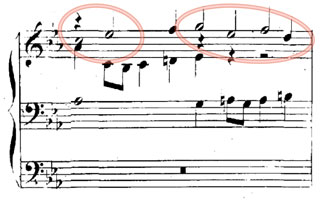
So I spent time editing the notation, resulting in something like this.
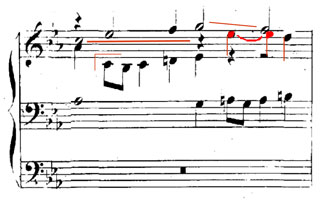
Mind you, I'm not changing anything about the actual resulting music; all the pitches and rhythms are the same. I'm just making it easier for myself to read. After doing this kind of editing, the piece is much more enjoyable to play, because I can always easily see what each voice is doing, and how all the voices fit together.
Last time I mentioned something about Bach's deliberate parallel octaves. I'll save it for another time. In fact, think I'll stop trying to predict what I'll write about in the next blog entry, because so far I have never followed through on any of these kinds of teasers. In any case, I do appreciate you tuning in to see what's going on here. Drop me a line if something I write about here interests you too. Until next time.
Regards,
Aaron
Passages That Bother Me, Episode 1
January 04, 2016
Welcome to 2016, and the first installment of a rare topic which I may revive from time to time, namely: passages in Bach's music that bother me. There aren't many of them, but, well, it happens. Today I'm discussing a passage from the first Bourreé from the English Suite No. 2 in A Minor. Here is the piece played in its entirety in a straightforward albeit not very exciting manner on harpsichord by Martin Galling.
Now, here is the passage that bothers me. It's the final phrase of the piece.
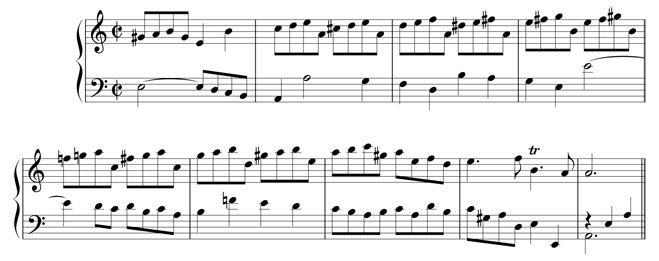
And here's why it bothers me. It sounds like there are wrong notes here. Take a look at the upper voice: a figure made of two parts, both of which are ascending. In the image below, I've colored the notes of the lower part red to separate them from the upper part. Keep your eyes on the red notes as you listen to the passage again. At least one of those notes should leap out at you as sounding wrong.
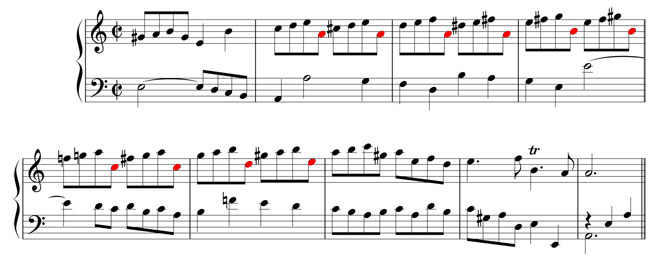
Did you hear it? Okay, first some general remarks. The upper part is very logical, ascending by step each bar, and also ascending by at least one chromatic alteration each half bar. The lower part of the upper voice however is not so orderly. It ascends, but seems to willfully resist cooperating with the upper part, instead hanging on the A for two full bars, then stepping up to B for a bar, then C for a bar, and finally stepping up D to E in the next bar, just before the two parts become one again.
Now besides the fact that the parts aren't agreeing, what bothers me about this is that bad doublings result from the lower part against the bass voice, and it is the first of these bad doublings that should have leaped out at you when focusing on those red notes. It is in the fourth bar of the upper system, the A octave doubling against the bass. This sounds wrong because that A is the 7th of a B dominant 7 structure in that half of the bar, which anyone trained in harmony knows naturally resolves down by step, and for this reason (and also just because it will tend to "stick out") shouldn't be doubled. If it has to be doubled, then it should be doubled in contrary motion. That's what Bach has done here, but the motion of the upper part is too slow to be heard as contrary motion. It just sounds like a bad doubling. That lower part of the upper voice has been harping on that A already for a bar and a half. Why repeat it here when it doesn't need to be repeated, and the note it moves to next works better? That note should definitely be a B, not an A. Problem solved.
There is another doubling that bothers me: the C two bars later, also a doubled 7th, but this is a lower neighbor in the bass voice on the up beat, so it doesn't sound as bad as the other doubled 7th. It's a harder one to get around, though of course there are ways. Here is an analysis showing how each of the lower notes in the upper voice is functioning within the harmony, also marking the doubled 7ths.
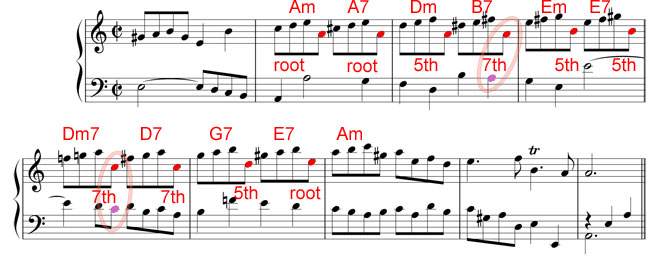
Let's take a look at some ways Bach could have written this passage which would not bother me so much. Here is a variant in which both of the upper parts cooperate, so that the lower part steps up in the same way the upper part does. The letters in parentheses are the names of the notes in the lower part of the upper voice. Look how nice and orderly it is!
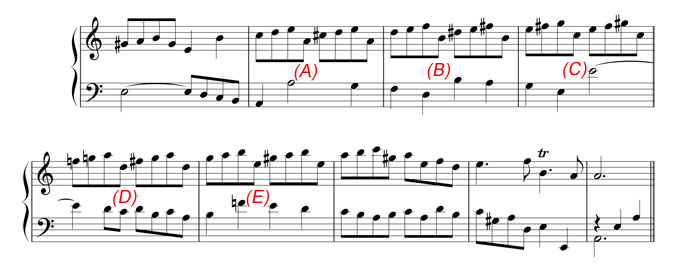
To me this sounds better than what Bach wrote. The upper voice is more uniform, and the bad doublings are avoided. An argument that could be made against it is that maybe it's a bit dull in comparison, so here is another option in which the measure from Bach's version where the lower part steps from D to E is taken as a model for a pattern beginning after one measure of A in the lower part. The result is a middle ground between Bach's version and the more conventional one above. The lower part ascends in a more orderly way, avoids the bad doubling of the A, and is still interesting in itself. (You may also notice that I changed a note in the bass voice to avoid the doubled C which still happens when this pattern is used.)
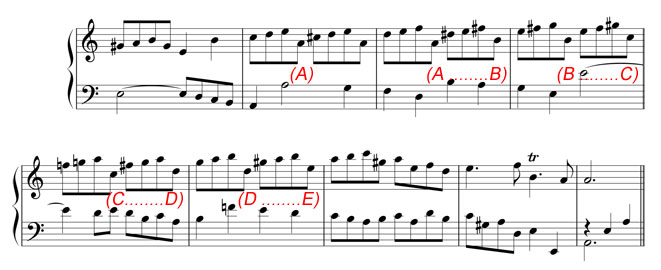
Well there you have it. Give another listen to the whole piece and see what you think. Am I right? Wrong? Of course I'm right. I like Bach's version because it's out of kilter, and maybe it has a story to tell. Let's say that the upper part is like a parent who says to its child (the lower part) "Come on, we're going up and up — here we go!" but the child resists, and says "I don't want to go!" only to be dragged along up and up eventually in a shallow parabolic curve. My revisions lack this kind of drama. They are more orderly, and as a result maybe they aren't as interesting. But, honestly, I think my versions sound better. That is my conclusion!
See you next time, when I'll discuss a few of the times that Bach deliberately wrote parallell octaves, (and no, I'm not talking about the Toccata in D Minor or the Fugue in E Minor).
Happy New Year,
Aaron
P.S. The Dm7 in the fifth bar of the analysis should probably really be labeled as F Maj7 on the downbeat. The E7 in the preceding bar then can be shown to move in a standard progression (deceptive resolution), and the E is a suspended Major 7th against the F above it as a root, instead of a suspended 9th against the 3rd above it with no root. I dispensed with the F Maj7 label because of the downward resolution of the suspended E to the D. It's really both things. F Maj7 on the downbeat which changes to Dm7 on beat two.
More about 2 over 3
December 04, 2015
After writing last time about 2-beat groups in triple meter (in the aria "Öffne dich" from Bach's Cantata BWV 61 Nun Komm, der Heiden Heiland), I started thinking about other examples. One that came to mind was the Invention No. 8 in F Major. This piece is obviously much more widely known than "Öffne dich", and the way in which Bach plays around with the meter in this case is easier to grasp.
The work starts out with a pickup, which must be performed as such (articulation and so forth), or the listener will experience a slightly jarring effect around bar 4.
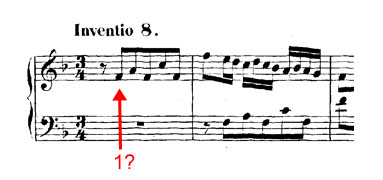
Bach uses a simple and effective metrical trick starting at the downbeat of bar 8, and ending at the downbeat of bar 12. There are in this span 4 measures of 3/4 time, equal to 12 beats. This number 12 is fairly important in music, generally speaking. 12 is of course rich in divisors: 1, 2, 3, 4, 6, 12, which made it a favorite of number theorists since time immemorial. In this case, it makes sense to look at what happens here almost as a meter change to 4/4 at bar 8. Not only do we have 4 measures of 3/4 time here, we also have 3 measure of 4/4 time. This is clear not only by the contrapuntal rhythm but also the harmonic rhythm, leading to cadence on the dominant. Let your ear follow the upper voice and you'll see what I mean.

The piece proceeds decidedly in 3/4 until four bars from the final downbeat, where the metrical trick is used again, this time leading to the closing cadence on tonic.

Probably this piece will be easier to remember, should you ever want to call to mind an example of music that has some fun pretending to be duple meter for a while within a triple meter.
BTW, the latest offering from All of Bach features an interview with the conductor and soloists that includes some commentary about this same topic in the Cantata BWV 196 Der Herr denket an uns.
Regards,
Aaron
Öffne dich, mein ganzes Herze
November 22, 2015
The first of Bach's organ works that captured my imagination when I first discovered them as a teenager was the prelude and fugue in B Minor, BWV 544. In the late 90's, after some training at the organ in college and graduate school, I learned to play the prelude, and enjoyed playing it often. The fugue however seemed just a bit beyond my ability at the time, so I never learned to play it. Now I feel more capable, so it's about time I learned to play the fugue, as well as many of the other pieces that have inspired me for so long. Hence, four hours of practice today were spent mostly reading through the great preludes and fugues, several of which I'm planning to learn in earnest in 2016.
Now for a bit of fun. Last week I mentioned that I had transcribed the simple two-voice aria "Öffne dich" (bass line and soprano) from Bach's Cantata BWV 61 Nun Komm, der Heiden Heiland. To hear the aria, follow the link and click on 'Öffne dich' menu item at the bottom of the video.
It goes without saying that Bach was a clever composer. In the case of this aria, Bach makes very clever use of meter. Not having seen the score for this work, I simply had to guess at what the meter might be. I listened to the work several times, noting the phrasing as best I could. Some places suggested a triple meter, while others suggested duple meter. The contrasting section before the Da Capo seemed to be clearly in duple meter. Based on those observations, I decided to transcribe the entire work in 2/4, because it seemed the best match for the whole work. This decision was also partly based on knowledge of Bach's keyboard works, which occasionally include phrases of 3 beat groups in 2/4 meter. Here is my transcription, in which I simplified some of the vocal ornamentation.
While the notes are correct, the meter is (not surprisingly) not at all what Bach wrote. Take a look at the actual score below.
What should follow at this point is a comparative analysis of the two versions of this music, showing how one (the original) demonstrates phrasing in 2 over 3, while the other (my transcription) demonstrates phrasing in 3 over 2.


To do this analysis right would take a very long time to prepare all the necessary drawings for this blog, so I'll just give these hints and leave the rest to the interested reader. You may also notice that I omitted a couple of weak-beat 8th notes in the bass line which were played quietly in the recording. The full score can be found at IMSLP.
P.S. I should say something about the section Bach notated in common time (4/4). Normally, when one looks at music of this period and sees 16th notes, the imagined tempo is probably a good clip somewhere between 96 and 120 bpm. In this case, Bach writes in the tempo marking Adagio, which was a bit unusual for him to do. This tempo marking Adagio had a special meaning in the Baroque: that the normal tempo is to be done twice as slow (this is according to Kirnberger and others — Anthony Newman's book Bach and the Baroque is a great reference for tempo issues in Bach's music). So Bach wanted these 16th notes to be played with the same durations as the 8ths notes are played in the rest of the piece! Of course, this is something that would be nearly impossible to know was happening by someone transcribing by ear (e.g. me); hence, Bach's Adagio 16th notes are written as 8th notes in my version.
Wo soll ich fliehen hin?
November 15, 2015
In case you didn't know, the Netherlands Bach Society has embarked on a historic project, to record all of Bach's music and release videos of the performances for free online. Truly, this is the internet at its best. Each week, a new performance is published on the website allofbach.com, along with at least one interview (sometimes several) and historical and editorial notes about the work, including any texts and translations. Performances are top notch, some of the best I've ever heard, and the interviews (subtitled in English, spoken mostly in Dutch, some in other languages) are all very well done — engaging and enlightening. It is fantastic to see professional musicians sharing about the depth and detail of their craft. Having read several books about Bach, and studying his music for decades, it's wonderful to be learning new things from this project. It's all so brilliantly done; I couldn't ask for a better source of inspiration. I don't know who is funding it, but let's hope they continue to do so, since at the rate they are going, this project will need to continue for about 30 years to publish all of Bach's music.
This week's offering from allofbach.com is the Schübler chorale "Wo soll ich fliehen hin?". Just follow the link to see the performance, as well as an interview (German with English subtitles) with the organist, and a page of historical and editorial notes about the piece.
This work has been a favorite of mine for years, and after seeing this performance, I decided to take some time to learn to play it. I'm pleased, and a little amazed, to say that I found it not very difficult! I think this means I'm improving as an organist. Though I took a week off from practicing since playing a service at the end of October, today I put in a good four hours, practicing this piece, and a few others, mostly "Wir glauben all' in einem Gott" and "Christe, aller Welt Trost", both from the Clavierübung III, which I have been listening to regularly for at least the past month. All of these works are great subjects for analysis. Between slow run-throughs and yet slower spot-checks, I did some study of the way Bach organized "Wir glauben all' in einem Gott" in terms of invertible counterpoint permutation. This piece is also particularly interesting because it features recurring 5-bar phrases. Bach actually did quite a bit with odd measure groupings. It's a topic I'd like to cover in more depth at some point, especially considering the focus of my work in asymmetrical meters. In some cases I have used meters like 5/2 (in a recent organ fugue) which is just a more overt way of organizing the phrasing. Though 5/2 never appears in Bach's music, the meter is not totally foreign to Bach's style - a parallel kind of music in Bach is found in "Wir glauben all' in einem Gott", written in 2/4 and phrased in measure groups of 5 each (though not consistently throughout). As another example, Bach's single movement Cantata "Nun ist das Heil und die Kraft" is unrelentingly phrased in 7 wherever the title text appears. The only exception is the final cadence, which comes in the middle of a phrase of 7, after 4 bars. (By the way, I found it surprising that this fact was not mentioned at all in the interview with conductor Jos van Veldhoven, especially considering he mentions other assorted number symbolism in the scoring of the piece.)
Speaking of interesting rhythmic phrasing in Bach's music, last week I spent part of an evening transcribing the very simple and beautiful aria "Öffne dich" from Cantata BWV 61 Nun Komm, der Heiden Heiland. You can hear this aria by following the link, then clicking on the white rectangular menu and selecting the aria (or just listen to the whole Cantata - it's not that long, and it's all brilliant). This aria I find captivating in its simplicity and feeling of openness, which partly comes from an ambiguous meter. I'll leave it at that for now, and will post my transcription next time. Comparing my manuscript to Bach's was a fascinating exercise and there is a lot more to say about the piece. So until next time, enjoy the music!
After Fall Break, The Mystery of the Missing C-Sharp
October 12, 2015
After more than a month away from this blog, with so much happening on a daily basis, I hardly know where to begin. The story of my life. For loyal readers curious to know how BWV 545 turned out, I'm pleased to report that it went over well at the service, with only a couple of hiccups.
I've since been asked to play again at the end of this month for a special All Hallows Eve service at the Episcopal church. This service is supposed to include some "scary organ music" at the end, so I'm preparing two of Bach's more chromatic preludes: BWV 535 and the great BWV 542. Probably I will only play the latter, but we'll see. I've been surprised to find that 542 is not particularly difficult to play.
Much of my time has recently been devoted to developing MIDI Tapper, preparing this software for its port to Windows and its commercial release. Much of the work has been directed at issues related to performance of organ music, for my own use. For almost a year now I have been intending to re-record the New Goldberg Variations using MIDI Tapper (the original recording which sold on bandcamp for a while was a simple mechanical MIDI rendering straight from the notation software), but have not made a new recording because the feature set needed to do it really well has not been fully implemented. Just a few things remain to be tweaked, and then I'll be able to do it, and hopefully the task will be completed within a week.
I've not forgotten about the suspended 4th against the 3rd which I said I would discuss on the blog at some point. I'm making notes in my mind about the best examples to use. There is a great example in the Goldberg Variations. I'm also paying close attention to this when I read through something new, because I want to make sure I'm not missing anything. It seems that Bach handles things very consistently, but there may be other instances I haven't taken a close look at yet.
I was excited to read through Christoph Wolff's beautiful book The Organs of J.S. Bach, and I learned a lot from it. The book of course includes details on the Wender organ in Arnstadt, which I had the honor to play for a few minutes last year. I had noticed then that this instrument has no low C-Sharp in the pedal. Having studied organ building, and been an aficionado of the organ for decades, one would think that I would have been aware that organs in Germany from Bach's time almost universally did not have a low C-Sharp in the pedal. The reason this fact surprised me so much is that Bach wrote plenty of low C-Sharps in his organ music. BWV 542, for example. This is a work Bach performed in Hamburg on the organ which had been installed originally some time before 1540, rebuilt many times, but in his day lacked this note in the pedals. Odd. And I would like to find out more about this. There is a two volume work by Peter Williams called The Organ Music of J.S. Bach which I'm hoping may shed some light. For now I conclude that Bach didn't apparently care that most instruments couldn't play his music exactly the way he wrote it. There were a few instruments in the general areas he lived and worked that did have low C-Sharps in the pedals (the Trost organ in the castle at Altenburg, for example) so maybe he wrote for these instruments, or simply hoped that more instruments would in the future have this note added. Do you have some insight to share about this mystery? Send me an email.
Stitch in Time
August 23, 2015
Inevitably, 9 hours were spent at the organ today. At least two of those hours were spent composing an exposition of a new Fugue in F Major (in 5/2), which has turned out to be a 5-voice piece. I'm not sure how I feel about that yet. I might scale it back to 4 voices. The majority of my practice was devoted to music for a service I'll be playing next month. I've chosen a simple 3-voice setting of Vater Unser by Praetorius for the prelude (which is called the Voluntary in the Episcopal service), but might add a second piece because the Praetorius may be too short, even if I play through it twice (it merits a repeat).
BWV 545 is coming into focus. Very slow practice is the key, for me. In a couple of places I find it necessary to watch what my hands and feet are doing instead of watching the score (such as the two measures I pointed out last week), but I'm long past the point of having memorized the music anyway, so it's not a problem to look away from the score and back again at any point.
I finally got around to investigating publisher membership at ASCAP this week, something I have been meaning to do since becoming a publisher in January. I was disappointed to find out that ASCAP is now charging a $50 membership fee, so I decided against it, considering that it's highly unlikely any royalties would be disbursed to me at all, and even if they were, they would be much less than $50. In the process I found out that the one published composition that earned me a writer membership in 1996 (Fantasia and Fugue on St. Theodulph) had somehow been deleted from my ASCAP profile, so I went through the process of adding it to my registered catalog, along with my music now published by Zwillinge. Being reminded of the Fantasia and Fugue written 20 years ago, I got the idea to get back in touch with the organist who premiered the work at the AGO convention in New York, Mark Bani, so I wrote him an email. Mark had sent me a cassette recording of his rendition of the piece (not the concert recording) back in '96, which I transferred to digital a few years ago. I thought it might be fun to put this recording on YouTube, but not without Mark's permission. We'll see what he says; I have not received a response yet.
A page of Errata has been added at Zwillinge for three known errors printed in previous copies of the 24 Preludes and Fugues. I was pleased to receive help with the German language version of the webpage from my friend Wolf Peuker in Berlin, who also helped proofread all of the music for publication. My German continues to improve, but is nowhere near good enough for public consumption.
Divide and Conquer
August 16, 2015
For some reason, each week I've been adding another hour to my organ practice. As a result of this odd habit, today's practice lasted 8 hours, almost without a break. An hour spent playing through the Prelude in F written last week led to a few minor improvements in the counterpoint, and I was surprised to be able to read through it almost steadily at a slow tempo. Bach's Fugue in C Major BWV 545 is coming along reasonably well, though I still fight my way through a few awkward passages in the pedals. Measures 56-57 are killing me.

When I find out I can't play something, I use a divide and conquer strategy to figure out what it is exactly in the passage that is difficult for me, and then isolate each aspect of the problem to become more comfortable with it. In this passage, the combination of things throwing me off are as follows.
- leap up of a 10th in the left hand
- the pedal is all leaps, requiring both legs to swing out of resting position
- the rest on beat 3 in the soprano the first measure is easy to forget
- the D on the downbeat in m.57 has to be taken by the left hand
- the tenor repeats the D on the and of 1 which is held in the alto (effectively turning the alto's written quarter note into an eighth note)
- these measures also happen to be the last on the page before a required page turn
Put all of those little snags together and for me those are two extremely difficult measures. There are a couple of other places similar to this which I also hacked away at. Little by little I will get there.
Having lost the slip of note paper listing the hymns I was supposed to practice, I spent probably a good 15 minutes looking for the hymns in order to practice them. (I'm good at remembering tunes, but not so good at remember texts or the names of hymns.) I simply could not remember one of the hymns, but was happy to give the three I found their due rehearsal, as well as some time improvising to get some ideas going for for possible introductions.
The work of the week was taken up mostly by programming for Mather Point Software and some website design work I'm doing for a client in Indianapolis. I also wrote a new composer's résumé — something I haven't done in years. According to my friend who knows more about these things than I do, it "doesn't flow". Still working on it.
Composing When it Rains
August 09, 2015
Rundown of this week's highlights
- Received the proof copy of the first novel to be published by Trabant Books, and fixed some photoshop issues with the cover
- Submitted PDF Bookmaker to the Mac App Store (more time consuming than it might sound)
- Dealt with some zip file downloading issues with the 1.5 GB wav files at Zwillinge
- Posted the Zwilling catalog on Amazon (the titles are still not showing up in non-US Amazon store and I don't know why)
- Wrote a new Prelude in F in mixed meters, for pipe organ.
The first hour of organ practice today was spent playing through the new Prelude in F, written this week. I had started this piece some time in May, but had set it aside. When it started to rain here on Thursday and I wasn't able to take my daily bike ride, looking for something different to do, I decided to input my sketches for this piece into the computer. About 9 hours later (at around 3 in the morning), a first draft of the piece was finished, and the next day I made a few revisions. Playing through my own music at the organ is exciting but can also be a bit painful, because I find things in my writing that disappoint me. For example, a passage that was supposed to be exciting turns out to be too awkward to play, or some voicing I thought sounded great doesn't quite work after all. Sometimes there are silly errors like a parallel octave somewhere I just didn't catch when I was writing (it can happen in 5 parts). Anyway, after fixing all those kinds of things, although I can't play it up to speed, I was able to get through it well enough to verify that it's a good piece, so that made me happy.
During the week, I put some time in on BWV545 just to get the hands in order (no pedals at home) so I put that together with the pedals for a few read-throughs, once with a very slow metronome. Some passages are still tough going, but I think in a few more weeks I'll have it down. Otherwise I practiced service music and hymns, beginning to get a feel for how hymn introductions might be worked out.
After about 6 hours, I was about to head home to get in my bike ride before sundown, when I looked outside to find it was raining, so I sat back down at the organ and started fiddling with a fugue subject I had in mind to go with the Prelude in F. Last night I had decided on a meter of 5/4 for the fugue, but looking over some of Bach's fugues during practice I decided to change that to 5/2. It's just a stylistic thing, so all the rhythms have double values. It could be written in 5/4, but it wouldn't look quite right. The practice of using cut time or meters based on half notes in organ music was a holdover from the Renaissance, and Bach followed that practice often in his fugues. To me, the longer note values give more of a visual sense of the powerful sound the organ makes. It didn't take long to find the subject. This is why I choose a meter first. Without rhythm, for me it's tough to come up with an idea. Once I have a meter in mind, rhythm begins, and melody comes from that. The subject I'm working with for this fugue is a simple one that requires a tonal answer of the kind I've not worked with much before, so this will be a chance to study some of those issues more in depth and try out some new things in my writing.
Design, Documentation, Deployment, Downloads, Dos & Don'ts
August 02, 2015
Some highlights from the past week:
- co-designed a book cover for a novel to be released by Trabant Books, a new division of Zwillinge
- wrote documentation and prepared the product page for new software from Mather Point Software — PDF Bookmaker
- fixed the reported bugs for MIDITapper beta cycle 47 and released beta 48 through H-Pi Instruments
- added mp3 and wav download purchasing to Zwillinge Verlag website for 24 Preludes and Fugues, which included preparing the zip files and writing a license document
Today's organ practice lasted six hours. Part of the time was spent with hymns and liturgy for an upcoming subbing job. Mostly I was reading through a lot of Bach. I decided to learn BWV545 Fugue in C Major, so played through it very slowly many times. An interesting factoid about this particular piece is that there are numerous suspended fourths against thirds — something that counterpoint students are taught is wrong. Bach actually did it fairly often, but of course it's a sophisticated thing. I teach students never to voice the third and fourth together, even though it's part of the style. To do it right requires higher level knowledge and experience students don't have. Maybe I'll show some examples of what I'm talking about in the next blog post. For now, I'm fairly exhausted.
Developments and Revisions
July 26, 2015
Work of the past week consisted mostly of programming and website development. I'm close to releasing a new app through Mather Point Software called PDF Bookmaker — a commercial version of software I wrote to help me prepare my scores for publication which combines PDFs and adds page numbers to the result. Considering that most users of the app will probably be working with words rather than music, I was looking for a test case for the app, preferably a novel. I'm glad to say that this has led to further developments on the publishing front for Zwillinge Verlag.
The Zwillinge catalog currently consists of only two titles, and I'm working on several other collections of my music for publication, but soon I won't be the only author listed in the Zwillinge catalog. Without giving too much away, I'll say at least that over a month ago I invited a certain scholar of tuning to submit his doctoral thesis for publication by Zwillinge. This week the enterprise has expanded further with the invitation of another author, not for music-related offerings, but for works of fiction and poetry. A new division of Zwillinge will be formed under the name Trabant Books for these new works.
Riding high from the momentum of the week, I somehow had enough energy to practice the organ today for over five hours. Starting out with a critical reading of a few of the movements from my New Goldberg Variations, slight dissatisfaction prompted several minor revisions. Having made these improvements, I found myself feeling glad that no copies of this work have yet been sold.
The rest of the time was spent reading through Bach's Leipzig Chorales, particularly An Wasserflüssen Babylon, which I also had taken some time to begin analyzing this week. As mentioned previously, Bach revised this work, as he did all of the 18 chorales, and the changes he made to his earlier scores are well worth studying. One can see in comparison a process of approaching a more perfect vision; hence, re-vision.
So this was a week of developing and reimagining ideas, realizing that things can and should be more than they are. Crossing out the old notes and writing in the new, seeing how the form of a whole can improve with one small adjustment — signs of growth. It is good to be reminded that we are all works in progress.
Sunday's Practice (Orgelübung)
July 19, 2015
- O Lamm Gottes unschuldig BWV656 (Versus 1 & 2)
- An Wasserflüssen Babylon, BWV653
- Prelude in F Minor BWV534
- Prelude in G Minor BWV545
- Prelude in D Minor BWV539
- Prelude in A Minor BWV543
- Prelude & Fugue in B Minor BWV544
- Prelude in C Minor BWV546
- An Wasserflüssen Babylon, BWV653
- Liebster Jesu, Wir sind hier, BWV706
Total time: 4 hours
I spent the most time with Bach's lyrically effusive An Wasserflüssen Babylon, BWV653, playing all parts separately and together in all combinations, studying the counterpoint, which contains many canons. A thorough analysis of this beautiful piece is definitely in order. The 18 chorale preludes are particularly interesting for composers because Bach left us two versions — early forms from Weimar, and later forms (definitive) from Leipzig. In all cases the later versions are improvements on the earlier. An Wasserflüssen Babylon in its early form is more square rhythmically, slightly less lyrical in the parts accompanying the chorale solo voice, and a bit shorter, with an ending that, although signature for Bach, does not reach the spiritual bliss found in the final phrase of the Leipzig version.
Star Spangled Banner in 19ET
July 07, 2015
This 4th of July I took a break from my work for a couple of hours and had a little fun arranging the Star Spangled Banner in 19ET.
After posting the result on SoundCloud with links on Facebook, some listeners expressed interest in the score, so here it is. It's written in scordatura notation, to be played on a standard MIDI keyboard retuned in 19ET (don't try playing it on a piano; it will sound completely wrong).
For those who don't know what scordatura notation is, it means that the pitches sounding are not the same as the notes written. There is however still a one-to-one correspondence between the written note and the sounding pitch. When writing in scordatura, the composer gives tuning instructions to the performer. Historically, this was done with stringed instruments, like the violin or cello. J.S. Bach even did this once or twice. For keyboard instruments, it is very unorthodox, but we can do it today with electronic keyboards that can be retuned to anything. This way, standard notation can be used to notate any tuning. The player just reads the notes and plays the keys on the keyboard according to the notes, and whatever pitches the keyboard has been tuned to will sound as the composer intended. In this situation, special care should be taken by the player when reading the score, because the experience of processing the notes on the page into music is a bit disorienting at first. One must remember that written accidentals affect only the note in the written octave, for example, because music written this way can easily include things like written augmented or diminished octaves (two inflections of the same note name in different octaves) which do not sound as such. Spellings are used for convenience, and to avoid double inflections of a given note name in different octave, although in some places better spelling choices could possibly be made (although this is a serious concern for the music I publish, I did not spend much time worrying about it for this piece, since I wrote it just for fun; if you find something that could be more clearly notated, or you think a different spelling would make more sense somewhere, just let me know and I'll certainly consider your suggestion).
Star Spangled Banner in 19ET (PDF)
Note: A Zwillinge Verlag watermark layer is embedded into the PDF, to appear only when the page is printed, but some browsers like Safari do not handle invisible layers. If the watermark appears in the browser, please switch to Chrome, or download and open the PDF with Adobe Reader.
